JASPER GAMERS TAKE ON THE MAAC
 MANHATTAN COLLEGE WINTER 2023
MANHATTAN COLLEGE WINTER 2023
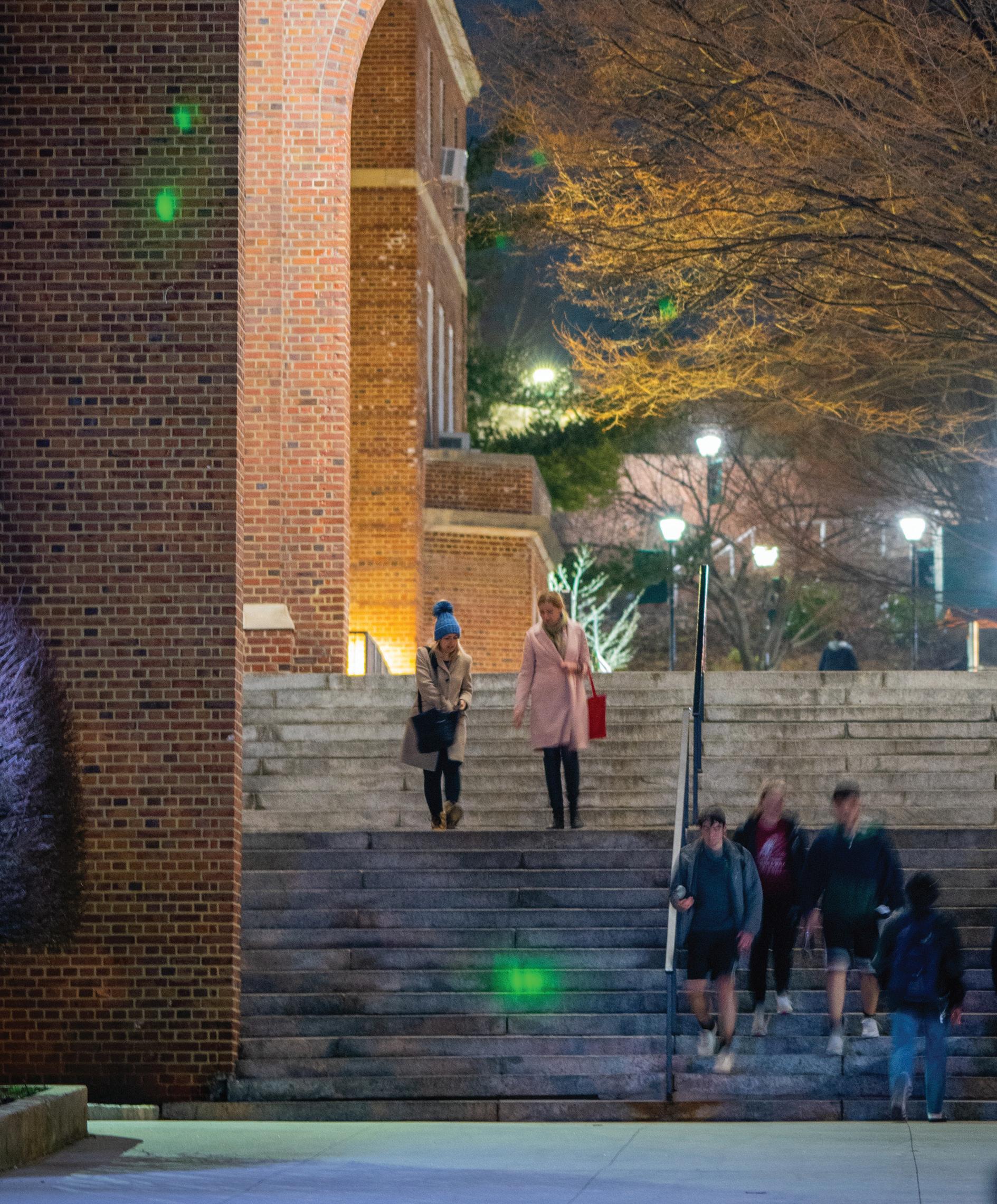
EDITOR
Kristen Cuppek
ASSISTANT EDITOR
Cecilia Donohoe
DESIGNER
Kat Lepak
CONTRIBUTORS
Patrice Athanasidy
Taylor Brethauer
Barry Moskowitz
Phil Paquette
Amy Surak
INTERNS
Taylor Carroll Bianca Schad
PHOTOGRAPHERS
Ben Asen
Josh Cuppek (cover)
Brian Hatton
Anissa Latif
Chris Taggart
Ryan Werner
Published by the office of Marketing and Communication Manhattan College Riverdale, NY 10471 magazine@manhattan.edu
Lydia Gray
Assistant Vice President, College Advancement and Executive Director, Marketing and Communication
ON THE COVER Students from Manhattan’s Super Smash Bros. Ultimate team hone their gaming skills in the esports room on campus. The College’s five esports teams regularly practice in preparation for matchups against their MAAC competitors.
2 ON CAMPUS
School of Science is named, President Brennan O ’ Donnell steps down, new Veterans Success Center opens, and so much more.

20 SPORTS
A Jasper is memorialized with a statue, plus news and fun facts from the past academic year.
22 GAME ON
Competitive gaming is on the upswing at Manhattan, with a growing number of students participating in esports.
26
CELEBRATING GRADS
At the 180th Commencement Exercises, graduates heard words of wisdom and savored their achievements.
30 DEVELOPMENT
De La Salle Dinner honors John Desmarais ’85, Cohen Foundation awards first grant, and meet a student scholarship recipient.
34 ALUMNI
Hall of Fame, alumnotes, profiles, and reminiscing on a once-popular tradition.
48 OBITUARIES
In memoriam, George Kirsch, Brother Benilde James Loxham, William Kenney, Robert Spinna, J. Carl Bennett, Sister Kathleen Tracey, Rentaro Hashimoto, Felix Bocchino, Anthony Sartor
56 PARTING SHOT
MANHATTAN COLLEGE WINTER 2023 VOLUME 49 • NUMBER 1
College Celebrates Longtime Benefactors and Dedicates School of Science in Their Honor at Naming Ceremony
IN OCTOBER, MEMBERS OF THE MANHATTAN community gathered on the McNeil Courtyard to celebrate the naming of a school at the College, the Aimee and Michael Kakos ’58 School of Science, and its longtime and generous benefactors. It’s the second school to be named at Manhattan.

The Kakoses have given the College a $15 million gift to increase student scholarships and grants, support innovative teaching and research, and enhance and diversify learning opportunities within the School of Science.

“Today is a true celebration of Manhattan College’s ongoing tradition of excellence in the sciences, and especially of the generosity demonstrated by two wonderful friends, Aimee and Mike Kakos,” said Thomas Mauriello, vice president for college advancement and emcee, who opened the dedication ceremony.
The Rev. Thomas Franks, OFM Cap., College chaplain, offered a thoughtful invocation filled with references to the sciences, before Brother Daniel Gardner, FSC, president, extended his heartfelt gratitude to the Kakoses.
“Your gifts have deeply affected me because of your deep concern for students and their accessibility to a quality education. They are real opportunities to real students in real time,” he said. “All of your gifts work toward the advancement of Manhattan College’s mission, and your direct support for students is the Lasallian mission on display for all to see.”
Also thanking the Kakoses for their long history of support, Dean Marcy Kelly then talked about the bright future of the Kakos School of Science and detailed the strategy for the school’s new vision, which includes an integrated community of scholars.
“The continued support and generous gift from the Kakoses, coupled with our new vision and mission to guide our sustained growth, will help us usher in a new, distinctive chapter for the Kakos School of Science,” she said.
Pulling from that community of scholars, Emilio Emini ’75, CEO of the Bill & Melinda Gates Medical Research Institute, served as the event’s special speaker. He offered the intimate crowd a glimpse into his 30-plus-year career in the biopharmaceutical industry, in which he led teams involved in the research and development of novel antiinfectives and vaccines, including the successful development of vaccines for human papillomavirus and rotavirus.
Afterward, the Aimee and Michael Kakos ’58 School of Science bollard was unveiled. The bollard eventually will have a permanent home at the entrance to the school, signaling Manhattan’s promise of student research and faculty collaboration to visitors and members of the community alike.
Michael Kakos, who spoke for the couple, noted how delighted he and Aimee were to “come home to this beautiful campus” and how humbled they were by the honor bestowed upon them. He discussed his professional path and the impact that the College has had upon
his long, successful career.
“Manhattan College has been the educational love of my life,” he said. “It is our pleasure to give back to Manhattan College, where I received my college education, and I consider it the most valuable thing that I own. The Aimee and Michael Kakos ’58 School of Science is our legacy.”
The gift, which will be paid over several years, will provide needsbased academic scholarships for students pursuing undergraduate degrees in a science, technology, engineering or mathematics (STEM) field; scholarships for students to study abroad; funds to support the research and scientific discovery interests of undergraduate students; grants to support innovative academic and research ideas and projects within the Kakos School of Science; and money to upgrade the school’s equipment, laboratories and other facilities.
A native of Riverdale, Kakos earned a bachelor’s degree in chemistry from the College in 1958. He continued to excel academically, earning an M.S. in chemistry at Niagara University, where he was awarded a fellowship, and an M.S. in industrial engineering at the Stevens Institute of Technology.
Kakos began his distinguished career in materials research, focusing on metals and ceramics, before switching industries to specialize in plastics engineering. At Celanese Plastics, he earned a number of patents through his initial work in the company’s labs. Kakos then rose through management in sales and international marketing, ultimately spending 11 years in London as director of European marketing. In 1987, he founded his own company, Resin Express, which achieved success in selling plastic to a previously untapped market — smaller British companies that fashioned
2 N winter 202 3 ON CAMPUS
Brother Daniel Gardner, FSC, president (right), joins the Kakoses during the unveiling of the bollard for the newly renamed Aimee and Michael Kakos ’58 School of Science at a special dedication ceremony in October.
parts for the automotive, telecommunications and appliance industries.
He and Aimee married in 1989, and she joined him at Resin Express. Assuming responsibility for personnel, payroll and training, Aimee rose to director. The company flourished. In 1997, they sold Resin Express to a Belgian plastics distribution firm. Today, they divide their time between Florida and Pennsylvania and devote themselves to philanthropic causes.
Longtime benefactors of their alma maters, the couple has made major gifts to the College of Arts and Architecture and the Arboretum at Penn State, of which Aimee is a graduate. They also established a significant record of giving in support of STEM at Manhattan College. Their gifts include funding the Michael J. and Aimee Rusinko Kakos Endowed Chair in Science, endowed scholarships for academic research and for study abroad, the Kakos Center for Scientific Computing endowment, and a named site in the Kelly Commons.
“Aimee and I support many of the institutions that we encountered during our lifetime, but Manhattan College is in the forefront because we know how it impacted our lives,” he said. “May all of its future students be inspired by the dedicated administration, faculty and staff, which is the hallmark of this great institution.”

Public Health Major Is Named College’s
First Truman Scholar
AJASPER NABS ANOTHER FIRST.
Alixandria James ’23 is the first Manhattan College student, and one of 58 college students nationwide, to earn a 2022 Truman Scholarship for graduate studies, leadership training, career counseling, and special internship and fellowship opportunities within the federal government. A public health major in the School of Education and Health, James also was awarded a Jasper Summer Scholars grant to analyze the results of the College’s first Diversity & Equity Campus Climate survey. As a result of her findings, which she presented to the president’s cabinet and other stakeholders on campus, the College created a Bias Education and Response Team, of which she is an active member.

James is committed to pursuing a career in improving health-care access for low-income people and people of color, drawing on innovative health delivery systems that provide low-cost, high-quality services. She is contributing to COVID-19 response efforts in New York City by working with New York-Presbyterian Hospital’s community outreach programs, helping to spread the word about vaccine availability, and inviting city residents to vaccine pop-up clinics.
The new Truman Scholars were selected from 705 candidates nominated by 275 colleges and universities. They were recommended by 17 independent selection panels based on the finalists’ academic success and leadership accomplishments, as well as their likelihood of becoming public service leaders. Regional selection panels met virtually and included distinguished civic leaders, elected officials, university presidents, federal judges, and past Truman Scholarship winners.
Established by Congress in 1975 as the living memorial to President Harry S. Truman and presidential monument to public service, the Truman Scholarship carries the legacy of our 33rd president by supporting and inspiring the next generation of public service leaders.
James and the other 57 awardees from the 2022 cohort join a community of 3,442 Truman Scholars named since the first awards in 1977.
MANHATTAN.EDU N 3
Emilio Emini ’75, CEO of the Bill & Melinda Gates Medical Research Institute, discusses his long career as the event's featured speaker.
Alixandria James ’ 23
With Mission at Heart, O’Donnell Leaves a Legacy of Growth and Advancement
AFTER A 13-YEAR TENURE, Brennan O’Donnell, now president emeritus, stepped down from his role as Manhattan College’s 19th president in July. But his legacy as an accomplished, thoughtful and faithful leader remains.

O’Donnell joined the College in 2009 and guided it through a critical period of transition and growth, as well as the challenges of the COVID-19 pandemic. He quickly got to work on expanding Manhattan’s academic programming while ensuring the College remained steadfast to its Lasallian Catholic mission.
Working with the various departments, he implemented a stronger integration of academic and extracurricular activities, such as the Arches Learning and Living program and more service- and community-based learning initiatives.
New academic programs at both the undergraduate and graduate levels were created to adapt to the changing needs of students, including the reestablishment of the MBA program, as well as new academic centers. Thomas Hall, for example, saw a renovation of its first floor to better serve students with a one-stop shop for mentoring, career services, fellowship advisement and more. Undergraduate research opportunities and support for summer research became priorities.
All of this work didn’t go unnoticed. Under O’Donnell’s leadership, the College’s rankings and recognition continued to not only climb, but excel. In addition to maintaining a top U.S. News and World Report ranking — even moving up to a No. 13 spot — Manhattan was named the No. 1 most transformative college in America by Money in 2019. But other publications and organizations started to pay attention as well, including several military-oriented rankings and college salary reports, like Payscale.
In addition, the College became known as a top producer of Fulbright students, and Jaspers earned more and more prestigious fellowships and honors, such as the Newman Civic Fellowship and Gilman Scholarship. Not to mention, O’Donnell guided Manhattan through two successful reaccreditations by the Middle States Commission on Higher Education.
Meanwhile, O’Donnell also led major facility and campus improvement projects. During his tenure, the Raymond W. Kelly

’63 Student Commons and Patricia and Cornelius J. Higgins ’62 Engineering and Science Center were constructed and opened. Both transformed the campus and the student experience. Major areas of Leo Hall and De La Salle Hall were renovated, as well as three floors of Thomas Hall, among other projects.
O’Donnell worked closely with the Christian Brothers on campus and in the district to assure the continuing strength of the Lasallian Catholic mission that was always at the heart of all his endeavors. Throughout his tenure, O’Donnell expanded the role of the Mission office; strengthened Campus Ministry and Social Action; and greatly expanded support for the Holocaust, Genocide, and Interfaith Education Center. The importance of mission could be seen and was beautifully expressed in the historic De La Salle windows, which he helped to bring to the College’s Chapel of De La Salle and His Brothers — an enduring example of Manhattan’s continuing strength as a Lasallian college.
“I think if there’s one Lasallian theme that motivated me more than others, it would be the idea of meeting students where they are,” O’Donnell says. “Part of honoring the dignity of the human person is the faith that everyone has a gift and the conviction that everyone deserves the education required to develop that gift to the full. When you talk to alumni, the most important thing they remember from their time at Manhattan was this personal, individual care — in a few words, the love and support they received from their teachers, advisers and mentors.”
With so much happening on campus during his 13 years as president, it was especially important to have a leader deeply committed to building philanthropic support and successful fundraising programs. O’Donnell worked closely with the College’s Development office to secure commitments from potential donors. Annual giving increased steadily and strongly during this time, and Manhattan’s endowment more than doubled. A $165-million Invest in the Vision capital campaign — no small feat for a college the size of Manhattan — was started, eventually surpassing $200 million in funds raised.
As O’Donnell, who began a long-planned sabbatical in July 2022 ahead of transitioning to the College’s faculty, looks back upon his tenure, he is proud of how Manhattan stayed true to its mission while adapting to the needs of students in a rapidly changing economy and world.
“I’m grateful to have had a chance to be part of a great and powerful educational mission,” O’Donnell says. “I’ve worked with some incredibly talented and dedicated people here, and witnessed day after day a level of care for students that is truly inspiring. I think we did a lot in the past 13 years to make sure that the core value — that distinctive way of going about our work — remained strong. And I think that, as long as Manhattan College provides that to students, it will continue to be the great force for good in the world that it has been since 1853.”
4 N winter 202 3 ON CAMPUS
New Veterans Success Center: Larger Space for a Growing Culture of Community
support and community for veterans that Manhattan provides.
“There, I went to the vets center to certify my GI Bill,” he says. “I didn’t get to know anyone. Here, I see veterans every day.”
One element of the Veterans Success Center that inevitably draws the eye is a photo display affixed to the large windows. Starting with a portrait and discharge papers of a Civil War veteran and proceeding through photos of Jaspers who served over the span of two world wars, in Korea and Vietnam, and through to the post-9/11 era, the photos are a reminder of the College’s long history of supporting those training for the armed forces, and of welcoming military veterans as they reenter civilian life.
THERE’S MUCH TO ADMIRE about the College’s new Veterans Success Center, which opened in fall 2022. Divided into three sections, the center features a comfortable “living room” furnished with couches and a large-screen TV; a conference area for group projects and tutoring; and, in the quietest corner, six pods for individual homework and studying. From the welcoming atmosphere to the layout and amenities (loaner laptops, a textbook lending library, snacks and a coffee machine), it’s clear that every aspect of the center was conceived with the unique needs of student veterans in mind.
Tiana Sloan, director of veterans success programs, notes that the former center, which opened in 2017, was a windowless room — at one time the campus barbershop — that seated only 13 people.
“We didn’t know how the student veterans would use it, and we found that it was more popular than we anticipated,” she says. “It wasn’t lending itself to all the things we thought it could do because it was too congested and noisy.”
With high rankings by U.S. News & World Report, the Military Times and G.I. Jobs, the College’s population of military veterans was growing quickly (approximately 100 are currently enrolled). Eventually, a large
room adjacent to Café 1853 in Thomas Hall was selected as the new location. It’s conveniently near campus resources such as the Center for Career Development, Financial Aid office, Writing Center and Locke’s Loft.
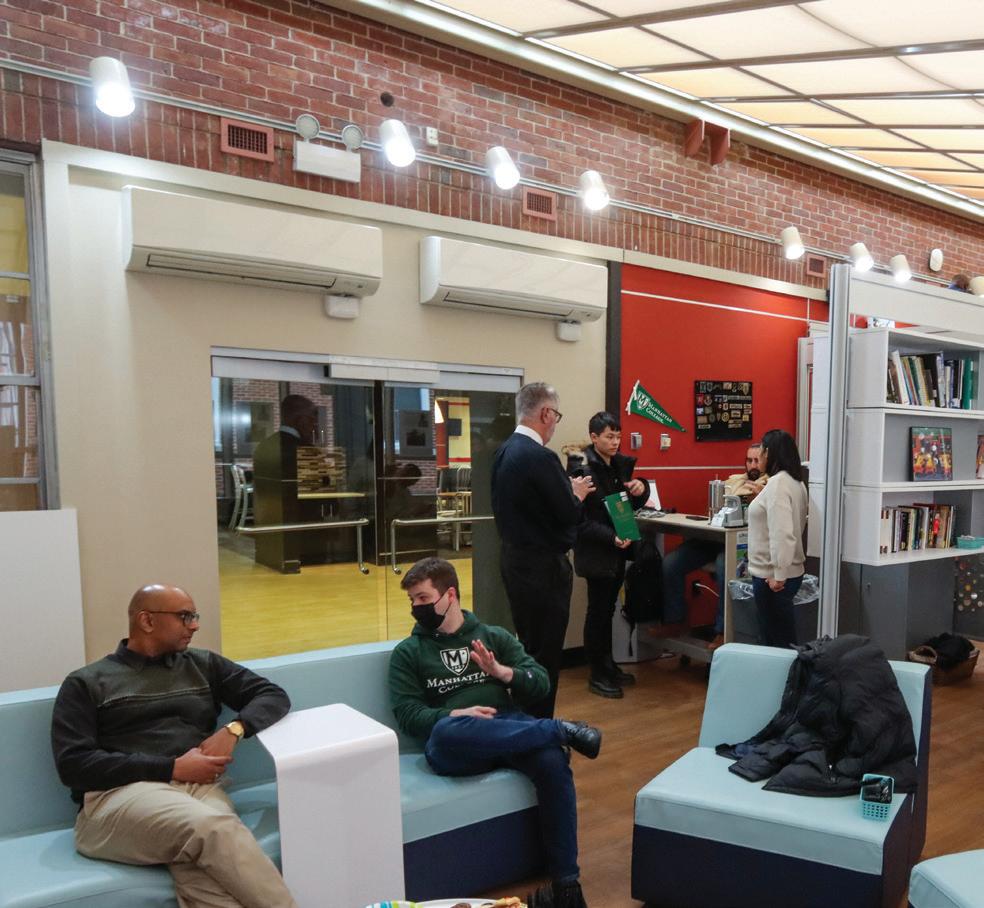
Many in the campus community are offering their services at the Veterans Success Center. For example, Madeleine Novich, assistant professor of sociology, and Daniel Alvey, assistant professor of mathematics, have volunteered as tutors.
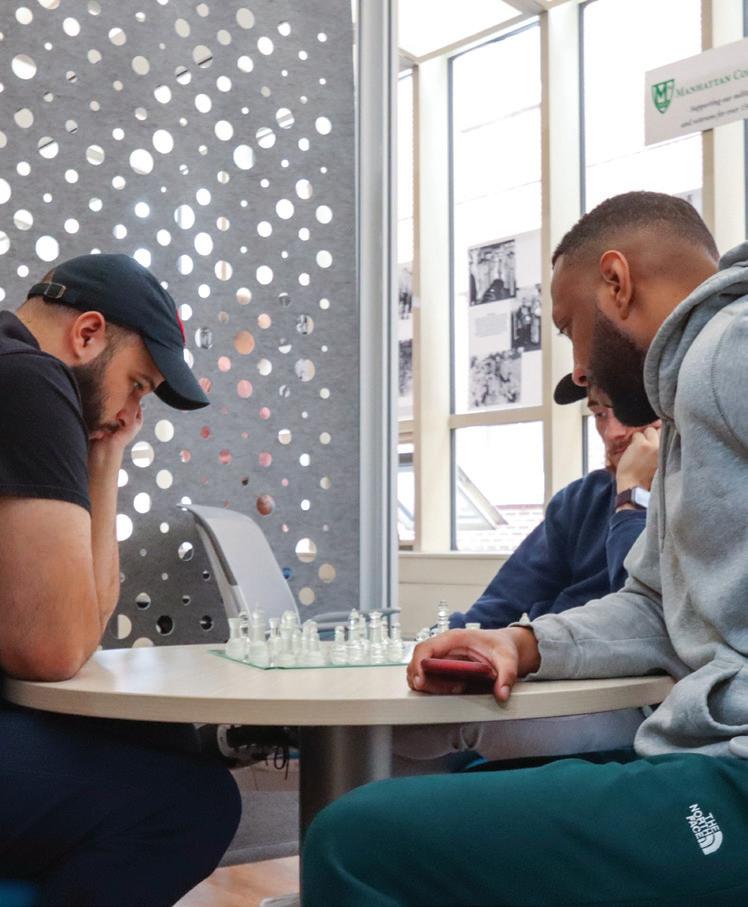
“They’ll just ask, ‘What do you need? Let me know what I can do,’” Sloan says.
A special dedication ceremony held in September was attended by Bronx Borough President Vanessa Gibson and Councilman Eric Dinowitz, as well as Viviana DeCohen, director of the New York State Division of Veterans’ Services, and James Hendon, the commissioner of the New York City Department of Veterans’ Services.
Kelvin Correa, a Marine Corps veteran who transferred to Manhattan to study electrical engineering, appreciates the new space. Although a visit to the center entails a long-ish walk from the South Campus, Correa says that the opportunity to socialize with fellow veterans and use the study spaces are worth the trip. The college he previously attended, he notes, didn’t offer the sense of
The photo display illustrates that “serving veterans is not just a tagline” at Manhattan, notes Christopher Norberto ’23, an 11-year Navy veteran and president of the Student Veterans Organization (SVO). “It’s cool to be a part of that lineage.”
“Manhattan has a holistic approach,” he says. “When we get out [of the military], there’s a sense that you’ve lost your purpose. You’re no longer part of this overarching mission or team, and it can be frustrating. Sometimes you just need a guiding hand, and Manhattan was that for me.”
The center also provides a venue for guest lectures and SVO programming. Norberto recently arranged for a local VFW post commander to discuss membership in the organization, and last fall a representative from the New York State Division of Veterans Services gave a workshop on military benefits.
Sloan also hosts an orientation for new student veterans each semester. “I think the new center has really allowed for the space of our culture of community to grow and thrive,” she says. Looking ahead to the spring semester, “This room is going to be packed,” she predicts. “And the energy — it’s just a homecoming here.”
MANHATTAN.EDU N 5
The Veterans Success Center is a highly utilized space, with student veterans constantly stopping in throughout the day to study, gather and participate in programs.
A Newly Renovated Horan Hall to Open in Fall
HORAN HALL IS GETTING A MAKEOVER. The residence hall will have 49 brand-new suites, which include a full kitchen, living and dining areas, as well as three bedrooms, when it opens in fall 2023. The renovations, which will look similar to those shown in the photos, will feature new millwork, LED lighting fixtures, tile floors, wall finishes and furniture. All bathrooms will be transformed with wall and floor tile finishes and eco-friendly plumbing fixtures. The lounges on each floor will be updated with contemporary finishes and furnishings to create a more inviting and interactive communal area. Even the corridor and elevator lobbies will be modernized. Students who were living in Horan Hall have moved into Chrysostom Hall, which was also renvoated this past fall, for the spring semester.

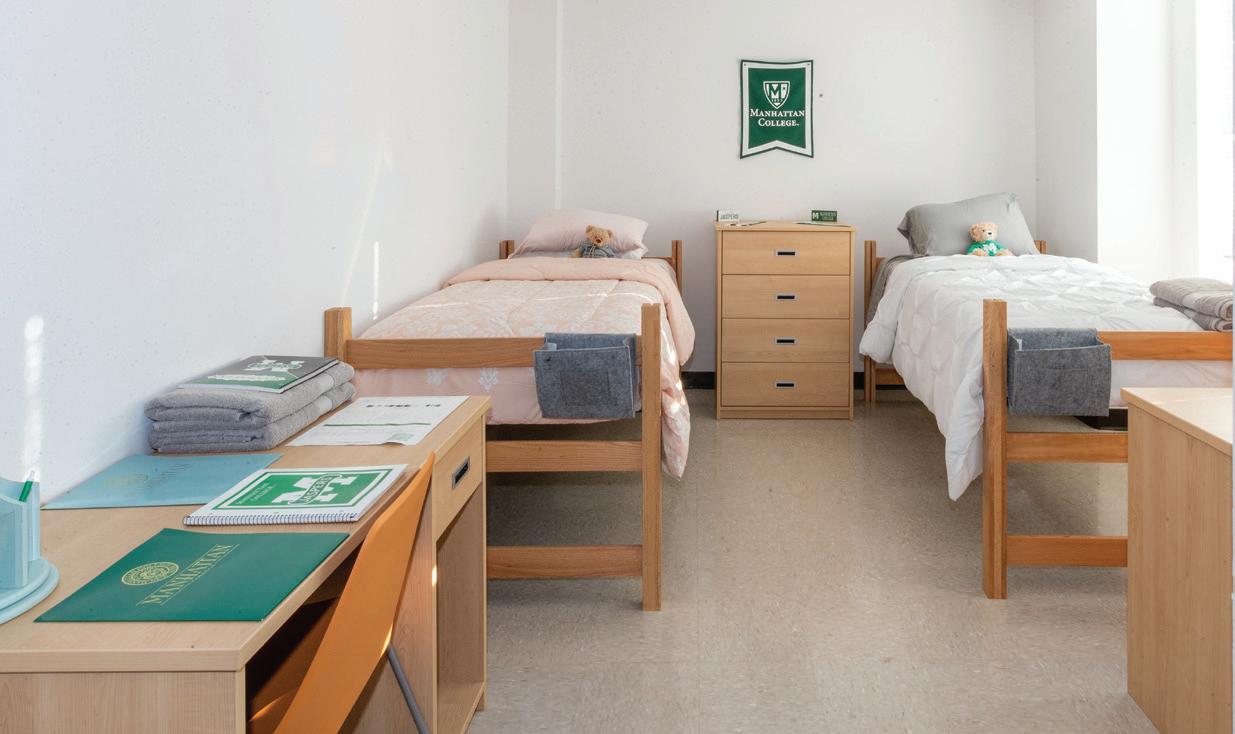

Calling all Criminology Enthusiasts
BEGINNING IN FALL 2023, the College seeks to offer a new B.A. in criminology that will prepare students to engage in the scientific inquiry of human behavior.

The 33-credit major will be administered through the Department of Sociology, which is changing its name to the Department of Sociology and Criminology. The program (pending New York state approval, expected shortly at press time) will offer a wide variety of courses, including: Modern American Gangs, Juvenile Justice, Mass Incarceration and Collateral Consequences, Crime Mapping, and Human Trafficking, with new classes being added regularly.
There has been a strong demand for a criminology major, according to Madeleine Novich, assistant professor of sociology and coordinator of the new program. The decision to implement the major is in response to both internal demand and larger national trends in higher education.
“We’re at the forefront of what’s happening in criminal justice education, research and technology,” Novich says. “We’re offering cutting-edge criminology, and students will be getting a curriculum that is very contemporary.”
Novich, who has been teaching criminology at the College since 2018, developed the department’s current concentration. She often brings in guest speakers to her classes and recently hosted experts from the FBI, NYPD and Department of Veterans Affairs, Office of the Inspector General.
There are a vast number of career trajectories and opportunities for students graduating with degrees in criminology. Some students pursue graduate programs and law school, while others consider careers in federal agencies, including the FBI, CIA and NSA. Other areas include local and federal law enforcement and nonprofit agencies that focus on criminal justice.
6 N winter 202 3 ON CAMPUS
At Annual Ignatian Conference, Jaspers Practice Faith and Advocacy
FOR THE PAST 25 YEARS, the Ignatian Family Teach-In for Justice (IFTJ) has brought together members of Jesuit and other Catholic schools, parishes, organizations and individuals in the context of social justice and solidarity to learn, reflect, pray, network and advocate. The largest Catholic social justice gathering in the United States, the Teach-In was conceived as a protest against the 1989 murder in El Salvador of six Jesuit priests and their two companions by Salvadoran soldiers, several of whom received military training in the U.S.
Sponsored by the office of Campus Ministry and Social Action and made possible by a generous gift from Debbie and Lizzie Brennan, a group of Manhattan College students attended the 2022 IFTJ in Washington, D.C., held this past September. According to Conor Reidy, campus minister, who accompanied the group, it was the seventh time Manhattan has participated. Reidy explains that the Teach-In has expanded throughout the years beyond protest to policy, with the aim of steering government policy to prevent similar events.
“The meetings in D.C. have speakers, small groups and Mass, all in an effort to educate students about advocacy and bring them together in prayer,” Reidy says.
Keynote speakers included climate activist Bill McKibben and Olga Segura, author of Birth of a Movement: Black Lives Matter and the Catholic Church. More than 40 breakout sessions were offered, focusing on a range of topics including antiracism, sustainable development, inclusive and accessible education, climate change, and many more. The third and final day of the conference was dedicated to visiting government representatives and advocating for social justice causes.
Chris Belden ’24, a history, economics, and peace and justice studies major, attended the conference. A member of the Northwest Bronx Coalition for Refugees, Belden is an active supporter of migrant and refugee rights. He attended a breakout session titled, Fleeing Nicaragua in 2021: An Immigrant’s Story, which was presented in Spanish and translated into English.
“Hearing personal stories and raw emotions was extremely powerful,” Belden says. “It’s one thing to read about it in a book or talk about it in class, but it’s another to hear Jorge Alberto — a migrant himself —and see the emotions on his face.”
Adolescent education and history major Julia Melchiorre ’23 participated in the conference with her career as an educator in mind. “As a future history teacher, I want to have firsthand experience with what goes on in government and what students and young people can do to support the legislation they want passed,” she says.
Both Melchiorre and Belden visited the Capitol on the Day of Advocacy and gave presentations to a committee from New York Senator Chuck Schumer’s office. Melchiorre spoke about renewable energy and how it can help marginalized communities.

“I made it a point to say that the U.S. is historically the biggest contributor of carbon emissions that drive global warming,” she says.
Belden shared statistics on immigration courts and legal representation issues for asylum seekers and argued that they should receive free legal representation. “These people are coming with nothing,” he says. “[Legal fees are] imposing such a high barrier to entry that I believe is unjust. Senator Schumer’s representatives were very attentive and informative on what they have done and continue to do behind the scenes.”
Belden’s passion for refugee advocacy goes hand-in-hand with Manhattan’s Lasallian mission, he says. The Ignatian Teach-In for Justice served to further his commitment to that ethos.
“I think it’s our obligation as Lasallians to uphold human dignity,” Belden says. “If we are going to say that we care about the poor and equality, then we can’t sit silent on migrants and refugees. We have to get involved.”
Due to its thousands of diverse attendees, the ITFJ provided an opportunity to connect with older generations who have lived and experienced more than most college students, Melchiorre believes. She would recommend the experience to anyone who wants to further the cause of social justice in the world.
“There is definite power in numbers,” she says. “Seeing so many people together for the same cause gives you hope.”
MANHATTAN.EDU N 7
Gathering outside of the Capitol, a group of Jaspers attended the Day of Advocacy, part of the Ignatian Family Teach-In for Justice held in Washington, D.C.
New Trustees and Chair Join the College’s Board
He is a past chairman and director emeritus of the New York Building Congress and serves as a trustee of St. Patrick’s Cathedral. Scarangello holds bachelor’s and master’s degrees in civil engineering from Manhattan College and holds a professional mechanics degree from Columbia University. Brother José Francisco Flores Gamio, FSC, was elected to the College’s board of trustees last spring. Originally from Mexico City, he is a Brother of the Institute of the Brothers of the Christian Schools. For 38 years, he has built a distinguished academic and professional career in the educational sector.
THE MANHATTAN COLLEGE BOARD OF TRUSTEES has welcomed new members and a former member back this past year.

Thomas O’Malley ’63, former chairman of the College’s Board of Trustees, was appointed the new chair. O’Malley, a transformational leader and loyal donor to the College, succeeded William Dooley ’75, who had been a trustee since 2007 and has remained on the board. O’Malley was board chair from 2005 to 2012 and served as a trustee from 1987 to 2002.

O’Malley is the former CEO of PBF Energy, an oil refining company, who retired from the organization in 2016. Previously, he was chairman and chief executive officer of Premcor, an oil refinery group based in St. Louis. Before that, he was chairman and CEO of Tosco, a small California oil refining company that he built into the largest independent oil refiner and gas retailer in the United States and one of the most successful trading firms in the industry.
In 2018, O’Malley donated $25 million to enhance learning opportunities at Manhattan College’s School of Business, renamed the O’Malley School of Business. The gift was the largest in the College’s history and designed to make a Manhattan College education accessible to students from all backgrounds while strengthening the College’s connections with the New York City business world through hands-on, experiential opportunities.
Thomas Scarangello ’79, former chief executive officer and current executive chairman of Thornton Tomasetti, a New-York based engineering consulting firm, has joined the board as a new trustee.
Scarangello has more than 40 years of experience in structural engineering, having worked on many different projects, ranging from sports and entertainment arenas and stadiums to high-rise commercial and mixed-use buildings.
He led Thornton Tomasetti to the forefront of project delivery services and engineering technologies for building analysis, design and construction. Scarangello oversaw the development of the firm’s strategic plan for growth and innovations in building information modeling, a 3D model-based tool that provides users with a digital representation of a facility’s physical and functional characteristics. He also managed its integrated product delivery system.
Brother Francisco assumed the office of president/rector of the Universidad La Salle México in August 2021, becoming the 11th president of the first Lasallian university in Latin America. Previous to his appointment as the president of the Universidad La Salle México, Brother Francisco served as bursar of the Antilles-South Mexico District for six years. He also served as the principal of Colegio Cristóbal Colón, Escuela Cristóbal Colón.
Brother Francisco is a member of the District Council for the Lasallian Educational Mission, and the Ongoing Formation Commission of the Antilles-Mexico South District. In addition, he is a member of the governing boards of three Lasallian universities in Mexico: La Salle University Mexico, De La Salle University Bajio, and La Salle University Nezahualcoyotl.
He has a degree in elementary education and Spanish, as well as in religious studies and a master’s degree in strategic management of human capital.
Jose Minaya ’94, chief executive officer of Nuveen, leads and manages more than $900 billion in assets within 13 distinct public and alternative affiliates. Named president of global investments in 2016, he also acts as chairman to several of Nuveen’s subsidiary companies and is a member of its investments and risk committees.

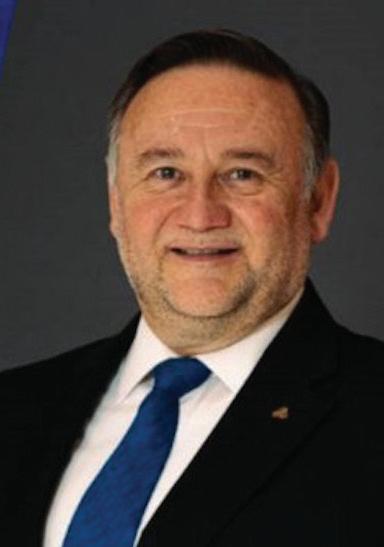

Previously, Minaya was president of Nuveen Global Real Assets, responsible for the business activities and strategic direction across various asset classes, including real estate, agriculture, timber, infrastructure, energy and alternative credit strategies. Prior to that, he was head of Private Markets Asset Management. With more than 23 years of experience, including positions at A.I.G. Global Investment Group, he is a recognized expert on real assets investing. He was involved in emerging markets equity transactions and the investment banking groups at Merrill Lynch and J.P. Morgan.
Minaya has a B.S. in finance from Manhattan College and an MBA from Dartmouth College, Amos Tuck School of Business, where he was a Robert Toigo Fellow. He is a recipient of the Toigo Blazing Trails award for his demonstrated commitment to the education and leadership of the next generation of financial services talent. Minaya joined the board in December.
8 N winter 202 3
ON CAMPUS
Thomas O ’Malley ’ 63 rejoins the College ’s board of trustees as chair, a position he held from 2005 to 2012, and Thomas Scarangello ’ 79, Brother José Francisco Flores Gamio, FSC, and Jose Minaya ’ 94 join as new members.
Fall Honors Convocation Recognizes Exceptional Achievement
“A FORUM LIKE TODAY HIGHLIGHTS THE TREMENDOUS academic excellence that is displayed each and every day by our exceptional Epsilon Sigma Pi inductees, but it is also a time to step back and thank God for the gifts and talents that we have received,” said Manhattan College President Brother Daniel Gardner, FSC, in front of a crowd of students, faculty and family members gathered in the Chapel of De La Salle and His Brothers.
It was a beautiful autumn day on campus for the College’s annual Fall Honors Convocation ceremony, held on Oct. 16, with 255 Epsilon Sigma Pi inductees spanning all five undergraduate schools and the School of Continuing and Professional Studies.
Epsilon Sigma Pi is the oldest College-wide honor society on campus, and membership is the highest scholastic achievement for Manhattan College students. Its inaugural induction class joined the society in 1933, and it continues to induct Jaspers every year.
“When I found out I was being inducted into Epsilon Sigma Pi, I was so excited,” says Giavanna Walsh ’23, a marketing major and management minor in the O’Malley School of Business.
“It was such a rewarding feeling knowing
that my hard work at Manhattan College will be recognized, along with my friends and colleagues.”
The ceremony began with an invocation from Lawrence Udeigwe, associate professor of mathematics, and was followed by a faculty address from Christie González-Toro, assistant professor of kinesiology.
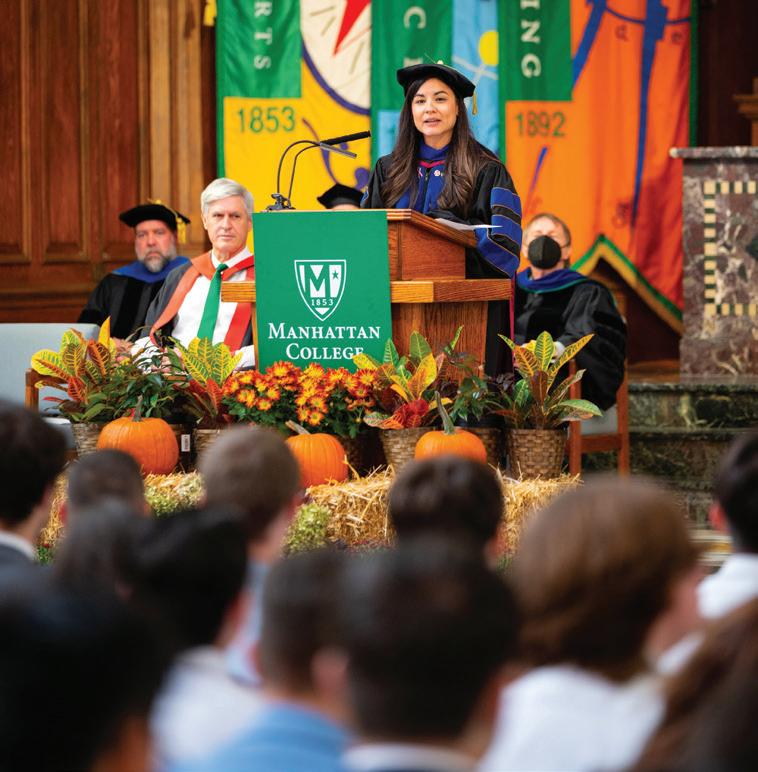
“Your path was anything but easy,” González-Toro said. “Regardless of the journey that you had to be here today to celebrate this academic achievement, we all have so many things in life to be grateful for. Jaspers, I invite you to reflect on your accomplishments and connect them with those for whom you feel thankful.”
Before students were awarded their Epsilon Sigma Pi certificates and keys, Brother Dan noted in his congratulatory remarks: “You are choosing to use your gifts and talents for the benefit of this world. Job well done. I thank you for your hard work, your example to the entire student body, and your cooperation with our faculty.”
As students and their families congregated after the ceremony for a reception on the Quad, celebratory wishes were shared among the newly inducted Epsilon Sigma Pi members, and classmates gathered for photos.
More than 250 of Manhattan ’s best and brightest students gathered in the Chapel of De La Salle and His Brothers to be inducted into Epsilon Sigma Pi, the oldest College-wide honor society. Faculty speaker Christie González-Toro, assistant professor of kinesiology, asked the inductees to reflect upon their achievements.
“Epsilon Sigma Pi induction means accomplishment and recognition for me and my classmates,” Walsh says. “It was so nice to share this moment with both Manhattan College’s faculty and our families.”
School of Science Has a New Dean
MARCY KELLY, appointed dean of the newly renamed Kakos School of Science in July, joins the College after serving as the department chair and professor of biology at Pace University’s Dyson College of Arts and Sciences. Kelly had been at Pace since 2003, advancing from an assistant professor of biology, to associate professor, and then to full professor in 2011.
As department chair at Pace, Kelly was responsible for the academic, scholarly and administrative functioning of a bi-campus department (2008-2011) and single campus department (2018-2022) that offered 11 degree programs in the subdisciplines of biology and the health sciences.

She supported the professional development of all faculty, and oversaw 12 faculty through the tenure/promotion process to associate
professor or promotion to full professor processes, and four faculty through the mid-tenure review process. Kelly also created a holistic, departmental advising program using an inclusive, strategic caseload management model to ensure that every student in Pace’s programs met with both a faculty mentor and professional adviser every semester to foster their academic, professional and personal success.
Since 2015, she has been one of 50 Vision and Change Leadership Fellows in the Partnership for Undergraduate Life Sciences Education. Organized by the National Science Foundation, Howard Hughes Medical Institute, and the National Institute of Health/ National Institute of General Medical Sciences, Kelly has worked with colleagues across the country to perform on-site evaluations of biology departments and analyze site visit data to determine the levers and barriers associated with department-level change with the goal of enhancing student success.
She received her bachelor’s degree in biological sciences from the University of Buffalo, and her Ph.D. in microbiology and molecular genetics from the University of Medicine and Dentistry of New Jersey.
MANHATTAN.EDU N 9
WoW! Whitman-Themed Performance Entertains at Gaelic Park
what it is to be an American and how to move forward, not only as an individual but also in community.”
The film, broken into seven parts, was projected onto a large inflatable screen on the playing field, with the audience seated on the bleachers. Part one, titled Journey, featured performers reciting, repeating and singing passages, often accompanied by music and frequently breaking into dance. The rendition brought vitality to Whitman’s lines, such as: “I tramp a perpetual journey/My signs are a rainproof coat and good shoes and a staff cut from the woods.” Although the performers were filmed separately, when edited together, the film conveyed an impression of communal endeavor.

THE AMERICAN POET WALT WHITMAN FIRST PUBLISHED THE GROUNDBREAKING Song of Myself in 1855 as part of his poetry collection, Leaves of Grass. The poem — comprising 52 sections and more than 1,300 lines — was greeted with both praise and censure for its unconventional use of free verse and exploration of taboo themes. In the decades since, Song of Myself has become one of the most acclaimed poems in the American canon, and its celebration of our shared humanity continues to be analyzed and interpreted today.
Manhattan took part of that tradition on a chilly September evening by hosting Whitman on Walls! (WoW!) in Gaelic Park, one of several events celebrating the College’s 100 years in the Riverdale section of the Bronx. The creation of director Karin Coonrod and her theater company, Compagnia de’ Colombari, WoW! is a traveling performance project that pairs live readings by local poets with More or Less I Am, a film that weaves together Whitman’s vision and lessons from our own time. The film was recorded during COVID-19 lockdown by more than 50 performers from around the world. To date, the event has been presented in partnership with libraries, museums, theaters and community groups. More than 100 people attended the event, with more watching on BronxNet.
“Many great bands have played [in Gaelic Park], and so I’m very excited that for the first time since the ’70s, we’re having a performance take place on this field,” said Michael Grabowski, chair and professor of communication, who organized the event.
“Our reason for starting all this in 2007-08 was to raise voices for democracy,” Coonrod said. “We were inspired by Walt Whitman, who in 1855 was very concerned about the polarization of the country and wrote this extraordinary poem to really investigate
Haydil Henriquez, the inaugural Bronx poet laureate, then shared an original poem titled still, celebrate in response. Six more short films with titles like Seen and Unseen, The City, Nature + Democracy were then screened, each with a response from poets including Manhattan faculty members Dominika Wrozynski, associate professor of English, and Melinda Wilson, visiting assistant professor of English. Two alumni also participated: Gabriela DePinho ’21 recited her poem Rearranging the Letters from God in the Street, and J.C. Pozo-Olano
’22 read Uptown God: 7AM in Kingsbridge Heights
At the event’s conclusion, Dietrice Bolden, a performer from the films, unexpectedly rose from her seat on the bleachers and sang the first words of Song of Myself: “I celebrate myself.” The poets who had shared their own poems then stood and joined Bolden in a call and response. It made for a rousing conclusion to one of the most singular events to have been held under the night lights of the storied playing field.
A recording of the event is available on the MCCOMM YouTube channel.
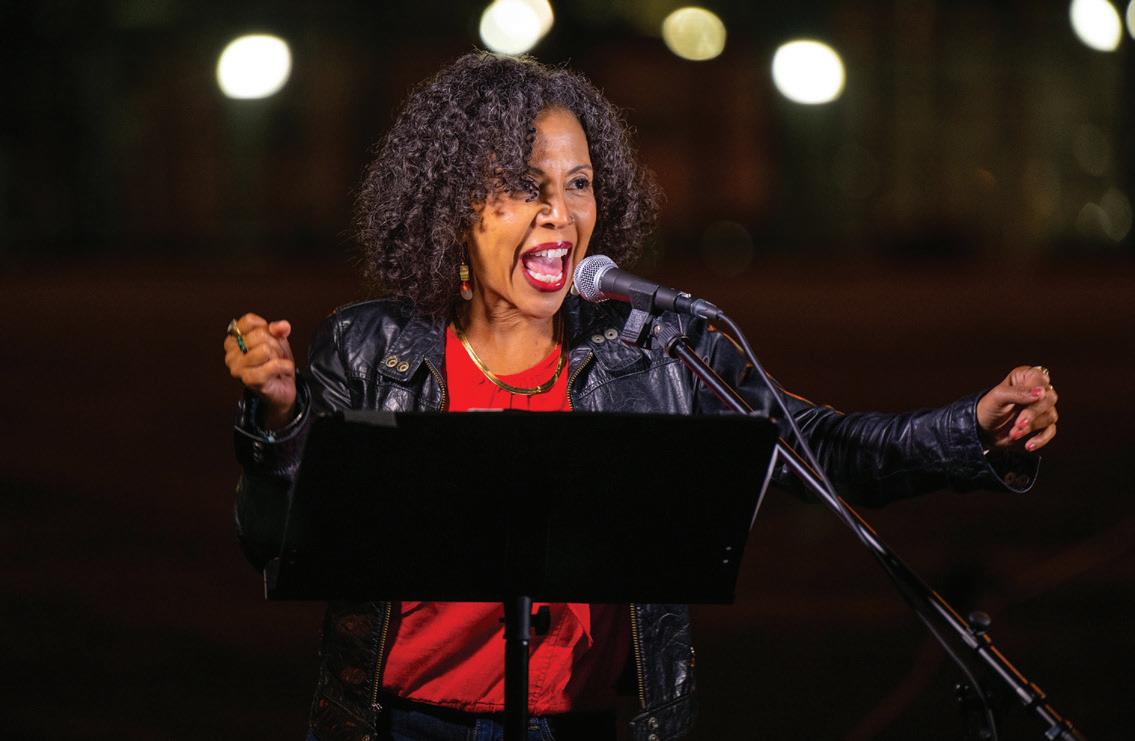
10 N winter 202 3 ON CAMPUS
This is the city, and I am one of its citizens
I call to its streets the gray dust that swirls around my feet as the morning light catches the midtown skyline in the distance.
—J.C. POZO-OLANO ’22
Bronx native Mariposa Fernández recites her poem Contradictions at Whitman on Walls! She is an award-winning Afro Puerto Rican poet, visual artist and activist.
School of Liberal Arts Officially Names
New Dean
Developing Learning Modules, Thanks to an NSF Award
CORY BLAD, who had been serving as interim dean of the School of Liberal Arts since March 2021, was officially appointed dean in July.
Blad has contributed greatly to the College in many roles since joining the faculty as assistant professor of sociology in 2009, progressing steadily through the faculty ranks to full professor in 2018. Beginning with his appointment as director of the Urban Studies program, which he oversaw from 2010-2015, Blad amassed a strong record of administrative success, including five years as chair of the department of Sociology from 2013-2018.
In addition, he has served with distinction on a variety of important committees, including the Diversity Council Steering Committee, the College Retention Committee, the Transfer Articulation Committee, and the Steering Committee for the Middle States Self-Study.
Blad also has engaged in a variety of significant College-wide service positions, such as the deputy chair of the Council for Faculty Affairs, co-chair of the Strategic Planning Steering Committee, a member of the Middle States Accreditation Committee, and a member of the Diversity Council.
Prior to arriving at Manhattan College, he was assistant professor of sociology and criminal justice at Southern Illinois UniversityEdwardsville.
Blad is the author or co-author of three books, and numerous peer-reviewed articles, book chapters, book reviews and presentations. He holds editorial positions and has served as a reviewer for scholarly journals and publications.

He received his Ph.D. in sociology from the University of Tennessee, his M.A. in history from Northeastern University, and his B.A. in history and education from the University of New Hampshire.
PREPARING THE NEXT GENERATION
of civil and environmental engineers has always been the goal of the College’s School of Engineering. And now, the school is educating tomorrow’s engineers with help from a grant from the National Science Foundation (NSF).
Resources provided by the NSF award will help faculty and alumni of the Civil and Environmental Engineering department to build online and in-person educational modules designed to teach students in undergraduate engineering programs nationwide. The modules will include instructional materials for professors, as well as presentations and projects, and will feature various real-world scenarios that relate to economics, business and statistics. The learning tools are designed to help aspiring infrastructure designers, builders and operators prepare for their future careers.
To keep up with an industry landscape that is ever-changing, associate professors of civil and environmental engineering, Juneseok Lee and Matthew Volovski saw the need for more robust systems and analytics course content. Together, they began brainstorming the NSF grant proposal in 2020.
“We wanted to train [and] prepare [the students], so they are fully ready when they join the workforce,” Lee says. “The new innovative modules [we proposed are] comprised of videos, instruction and exercises that can be implemented to nationwide/worldwide civil engineering undergraduate courses.”
After submitting the proposal in July 2021, the team was awarded the grant in December 2021 and began its work this past May.
“The resulting research products will not only provide the next generation of infrastructure designers, builders and operators with the system-level thinking and analytics skills they will need to thrive in the 21st century, but also help attract students with diverse backgrounds into this critical STEM field,” Volovski says.
The Manhattan team assisting in the grant’s research consists of principal investigators (PIs) Lee and Volovski, along with faculty consultant Peter Sweeney ’64 and four co-PIs, including visiting professor Christina Cercone ’09, associate professor Swaminathan Krishnan, associate professor Mehdi Omidvar, and assistant professor Medya Fathi. The project will also include undergraduate and graduate researchers, along with alumni project advisers Peter J. Zipf ’79, Tony Canale ’94, Paul Scariano ’94, Brian P. Sullivan ’97, ’07 (M.S.), and Timothy C. Lynch ’07, ’10 (M.S.).
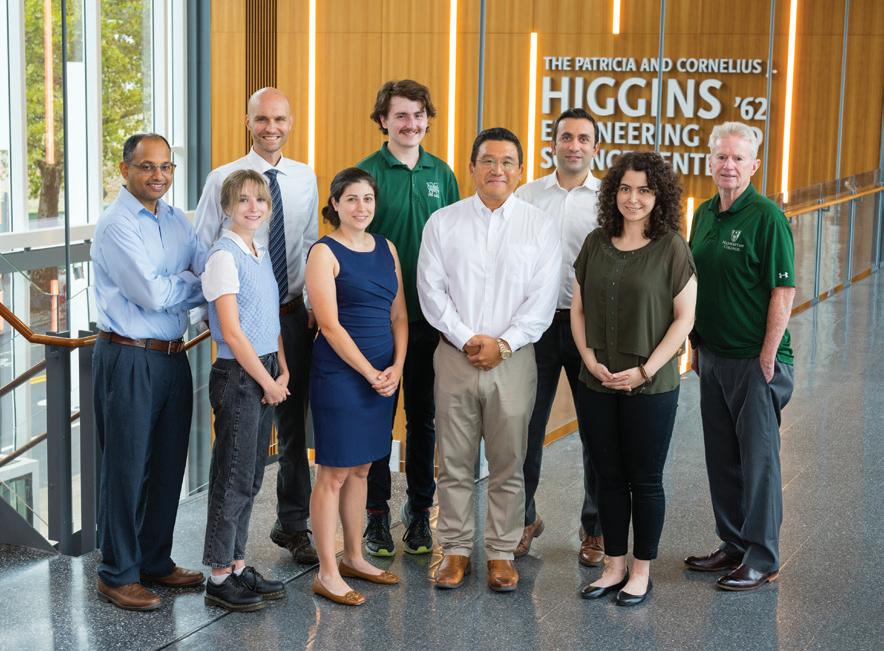
The goal for the NSF grant team and these newly developed modules is to allow departments and professors to benefit from this work, regardless of whether they focus on undergraduate education or are from tier-1 research institutions.
“Manhattan College is uniquely qualified to develop and serve as a model program,” Lee says. “The College has a strong working relationship with the nation’s leading civil engineering firms, and serves as the largest civil engineering bachelor’s program in New York City, which is home to the nation’s largest and most diverse assembly of civil infrastructure.”
MANHATTAN.EDU N 11
A National Science Foundation grant is helping civil and environmental engineers build educational modes.
LASALLIAN LOOK
For Hispanic Heritage Month, Bishop Espaillat Offers a Joyful Mass of Thanksgiving
MANHATTAN COLLEGE MARKED LATINX/HISPANIC HERITAGE
MONTH last fall with a full schedule of events including an opening dinner, film screening, guest lecture, trivia night and more. One of the highlights of the month was a memorable Mass of Thanksgiving in the Chapel of De La Salle and His Brothers, celebrated by Bishop Joseph Espaillat, Auxiliary Bishop of New York.
Ordained at age 45 in March 2022, Bishop Espaillat is the youngest bishop in U.S. history, and one of the first Dominican American bishops in the New York Archdiocese. A New York City native, he has served as pastor of Saint Anthony of Padua parish in the Bronx since 2015. He also hosts a podcast called Sainthood in the City.
Throughout the Mass, Bishop Espaillat spoke in both English and Spanish. The bilingual service was appreciated by Omar Torres ’25 and Luis Chavez ’23, who emigrated as children from Colombia and Peru, respectively. “It felt a bit like home to me,” Chavez says.
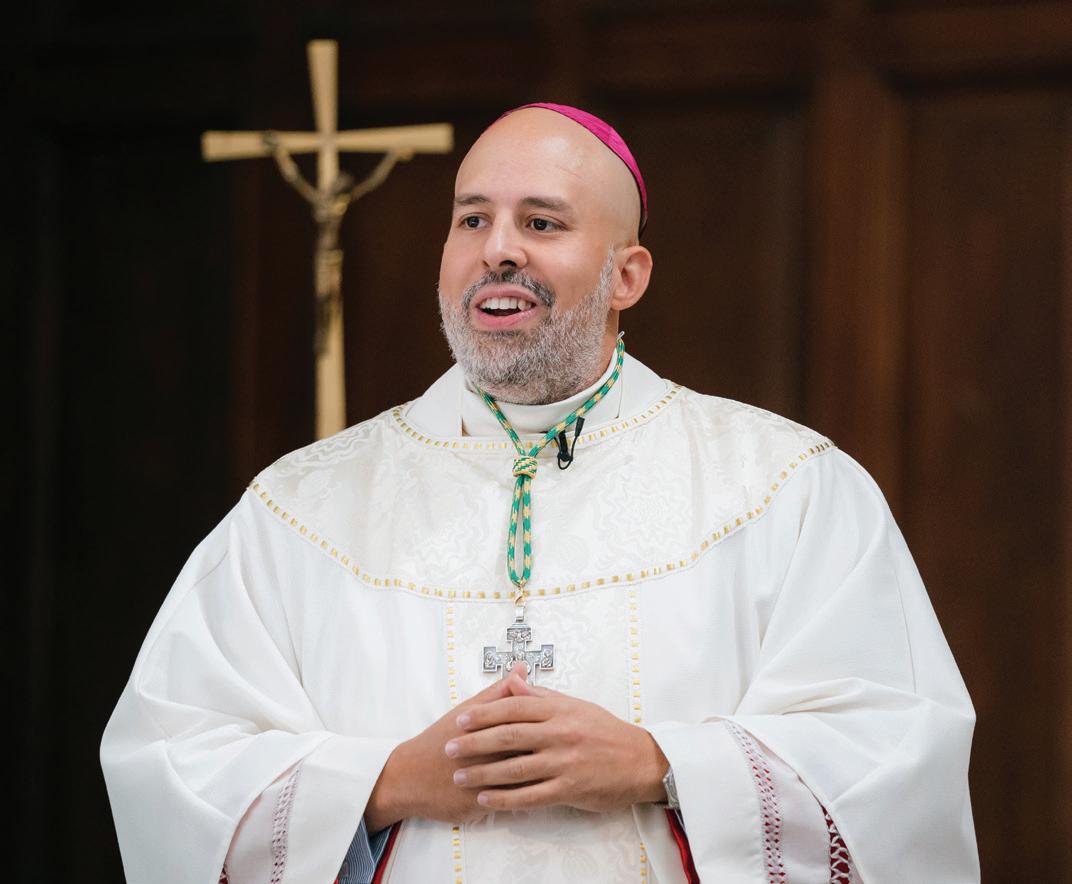
During the homily, Bishop Espaillat stepped off the altar to be closer to the congregation, directing his comments to the many students present.
“It was lighthearted but very serious,” Chavez recalls. “He asked us, ‘Who here knows how to curse?’ His point was that we also know how to bless. He said that it’s very common for people to curse, but how often can you say you’ve blessed someone? That was something that stuck with me.”
Bishop Espaillat described faith using the acronym BAR, which stands for belief, action and response. As Christians, he noted, we hold ourselves to high standards and have the ability — and obligation — to uplift those around us. He also shared his thoughts on relations between various Latinx communities. People from Spanish-speaking nations, he stated, should focus more on
their commonalities and less on competing with one another.



“I thought it was great,” Torres says. “A lot of times communities fight to see who’s better — whose country is better. I feel like that’s wrong; all Hispanics should be together.”
At the end of Mass, Bishop Espaillat blessed the men’s and women’s soccer teams, both of which were in attendance and had games that day.
“It was a 100% extra boost,” jokes Torres, a member of the men’s soccer team. “We beat Rider in our first league game of the season.”
The bishop’s down-toearth style and heartfelt spiritual message made an impression on all who attended the Mass.
“He’s very much a true New Yorker in that he has a very personable, very open, big personality, but with a warmth about it,” says Kerri Gallagher, director of cross country and track and field. “He was very reverent and very accessible at the same time. I was really impressed by how he was able to balance the two.”
Chavez, who participated in the Mass as a member of Music Ministry, left the chapel feeling energized. “Mass is a celebration and that’s what it felt like — that we were celebrating the word of the Lord,” he says. “It was one of the liveliest masses I’ve been to.”
That sentiment was widely shared. “Bishop Espaillat’s celebration of the Mass of Thanksgiving in honor of Hispanic Heritage Month was a wonderful gift to the vibrant and diverse community that is Manhattan College,” says Brother Daniel Gardner, FSC, president. “His message of kindness, unity and Christian example clearly resonated with the many students, faculty and staff who heard him speak. It was a blessing indeed to welcome him to Manhattan.”
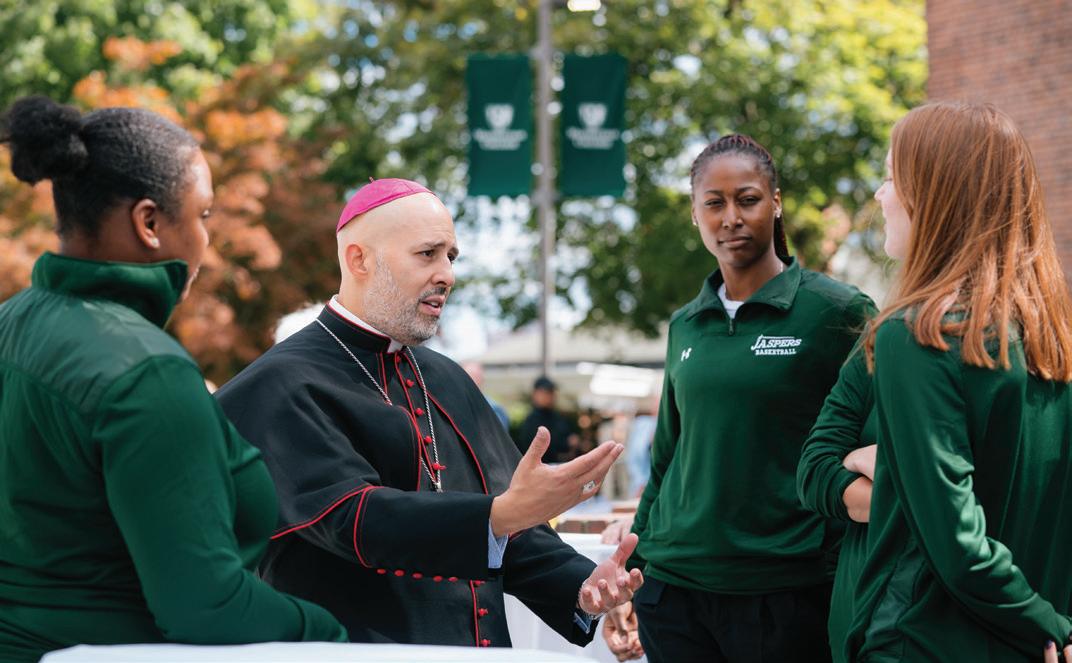
12 N winter 202 3 ON CAMPUS
Bishop Joseph Espaillat, Auxiliary Bishop of New York, offered a memorable Mass of Thanksgiving during Latinx/Hispanic Heritage Month on campus.
Introduction to Astronomy (SCI 201)
Course Description:
By studying astronomy and investigating the cosmos beyond our own globe, we can discover more about where we came from, where we are going, and the vastness of the universe. Introduction to Astronomy examines the basic forces at work in the universe and offers a thorough introduction to modern astronomy.
This course explores many concepts, such as a brief history and the tools of astronomy, the solar system, fundamental properties of radiation, astronomical measurements, stellar evolution, supernovae, neutron stars, black holes, and an introduction to cosmology (a branch of astronomy that deals with the origin, general structure, and evolution of the universe). The weekly class is divided between lectures, during which the instructor reviews new material and subject matter, and labs, where theoretical and practical experiments are carried out in class. It is intended for non-science majors and open to all students. Excursions to the Hayden Planetarium, located at the Rose Center for Earth and Space at the American Museum of Natural History, are also available as extracredit opportunities.
By the end of the course, students will gain a better perspective on the size and scale of various cosmic objects in the universe, know the origin and layout of the contents of the solar system, learn how stars are born and die, and enjoy an overall better understanding of science at a basic level.
Text: S. Palen and G. Blumenthal, 21st Century Astronomy, 7th Edition, W.W. Norton (2022)
Lectures: Mondays, 6-8:45 p.m.
Professor: Farrukh Fattoyev
About the Professor:
Farrukh Fattoyev, assistant professor of physics, teaches a range of subjects, from physics and astrophysics to statistical mechanics and astronomy. He has a Bachelor of Science from Samarkand State University in Uzbekistan, a Master of Science from the National University of Uzbekistan, a Master of Science from the University of Trieste and Abdus Salam International Centre for Theoretical Physics in Italy, and a doctorate from Florida State University. His research interests include nuclear theory and theoretical neutron star astrophysics, which focuses on the studies of structure, composition and dynamics of neutron stars.
Celebrating a Century of the End of the Infamous Latin Question
ONE HUNDRED YEARS AGO, the Christian Brothers in the United States had cause for celebration — the teaching and studying of the classics in their communities, high schools and colleges had been restored. The tumultuous period of fracture and strife between the American Christian Brothers and their French superiors, infamously termed the “Latin Question,” ended in 1923.

Under the Holy Rule established by the Founder of the Institute, Saint John Baptist de La Salle, the Brothers were forbidden to teach the Latin language. During the period in which De La Salle lived, educating the poor in the vernacular was valuable, progressive and certainly necessary. Latin was deemed ornamental and impractical for the underprivileged in 17th-century France. However, the unique circumstances of the late 19th century in the United States, and the conditions of American education, demanded the modification of the Rule. The American Catholic bishops needed and expected the Brothers to foster and encourage religious vocations. They could only achieve this by teaching the classics. Without the language of the Church, the Brothers were also constrained in their diocesan assignments. Since the establishment of the Institute in America, the practice of teaching and studying Latin served an important function in the development of the Brothers’ apostolates in North America in particular and the Catholic Church in general.
Nonetheless, after years of discussion and debate, at the General Chapter in 1894, the French superiors ordered the suppression of the classics in the United States; thus, exposing the fracture between the French and the American Brothers. Several American Brothers were sent into exile, and enrollment in the Brothers’ schools declined. The law ran counter to the best interests and desires of the American Brothers and significantly undermined the Brothers’ influence in North America. But after two decades of continued deliberation, different French superiors and a new General Chapter, the obstacle to teaching and studying the classics was removed, and the Latin Question concluded. Conveniently, the restoration of the classics coincided with the opening of Manhattan College’s new campus in the Riverdale section of the Bronx.
MANHATTAN.EDU N 13
SPOTLIGHT
COURSE
A photo of the Christian Brothers in the 1920s, during the time of the infamous “Latin Question” that pitted the American Brothers against their French superiors.
College Continues to Rack Up Rankings Recognition
U.S. NEWS & WORLD REPORT
For the seventh consecutive year, Manhattan College has been ranked among the top colleges in the North by U.S. News & World Report. Manhattan placed 16th out of 175 colleges and universities in the region.
Among student veterans, the College ranked sixth, continuing its recognition as a school that embraces those who have served in the military. In the undergraduate teaching category, Manhattan placed 10th, extending its run of top-10 rankings. The College was also recognized as one of the best schools in the region for undergraduate engineering and took the No. 42 spot out of 178 colleges and universities. Manhattan also was ranked No. 86 for social mobility, making it one of the top-performing colleges in the country.
U.S. News provides rankings of more than 1,800 best colleges and universities, as well as hundreds of best graduate school programs. The company ranks colleges based on data it annually collects from administrators at hundreds of colleges about their institutions’ academic offerings. U.S. News & World Report also considers data it gathers from its surveys of students at the colleges who rate and report on various aspects of their campus and community experiences.
THE PRINCETON REVIEW

Manhattan College has once again been ranked as one of the nation’s best institutions for undergraduates and best colleges in the Northeast, according to The Princeton Review. In the latest edition of its annual guide, the education services company recommends Manhattan College as one of its Best 387 Colleges
The Princeton Review promotes the College for its prestigious academics, vibrant campus life, and “eclectic” student body. Students overwhelmingly praise the “outstanding” professors who are “not only outstanding in fields they teach, but they also care very deeply for their students.”
Only about 14% of America’s 2,700 four-year colleges are profiled in the book, which is one of The Princeton Review’s most popular publications. The company chooses the colleges based on data it annually collects from administrators and college students.
FORBES
Forbes selected Manhattan College as one of the best schools in its 14th annual rankings of America’s Top Colleges. The renowned business publication spotlights colleges and universities that provide an outstanding track record of academic excellence while minimizing student debt. Manhattan College was ranked No. 229 nationally out of 500 colleges and universities and No. 87 in the Northeast.
Forbes uses multiple criteria in making its selection including return on investment, on-time graduation, securing high alumni salaries and low debt, how well the school serves low-income students, retention rates, and academic success.
WASHINGTON MONTHLY
Manhattan College’s contribution to the public good in social mobility, research and public service has earned it a spot on the list of the 45 Best Master’s Colleges and Universities in the country, according to Washington Monthly’s annual rankings Washington Monthly also recognized Manhattan as one of its top 40 Best Bang for the Buck schools in the Northeast. This year, the College’s ranking jumped from 96th to 42nd on the 2022 Master’s University list, and went from 120th to 40th on the Best Bang for the Buck: Northeast rankings.
Since 2005, Washington Monthly, a bimonthly political magazine and website, has ranked schools based on their contribution to the public good in social mobility, research and providing opportunity for public service, and all three of these measures are weighed equally. The Best Bang for the Buck recognition is based on a college’s ability to help non-wealthy students obtain marketable degrees at affordable prices. This year’s ranking focused on equity and value for all students.
ALL IN CAMPUS DEMOCRACY CHALLENGE
Manhattan has been selected as one of the Most Engaged Campuses for College Student Voting based on efforts to increase democratic engagement and student voting.
The inaugural ALL IN Campus Democracy Challenge (ALL IN) sponsored by the Washington, D.C.-based nonprofit Civic Nation, chose 397 U.S. colleges and universities for their efforts to increase nonpartisan democratic engagement in the 2022 election.
To participate, students were asked to meet several requirements, including sharing a 2020 National Study of Learning, Voting, and Engagement report with campus voting data. Students also developed and submitted a 2022 democratic engagement action plan to ALL IN.
The 2022 youth voter turnout was the highest for a midterm election in 30 years, according to research conducted by Tufts University’s Center for Information and Research on Civic Learning and Engagement.
EXERCISE IS MEDICINE PROGRAM GETS GOLD
Manhattan College’s newly established Exercise is Medicine program, designed to provide students with the tools needed to sustain healthy physical activity habits, has earned gold status from Exercise is Medicine On Campus (EIM-OC).
The College is one of 63 institutions to earn gold status from EIM-OC, which provides an opportunity for schools to enhance their image as a healthy academic environment and highlight their commitment to creating a culture of wellness.
14 N winter 202 3 ON CAMPUS
Law Alumni Council Honors Two Jaspers for Their Dedication to Public Service

“Tonight is to celebrate Manhattan and what Manhattan has meant to the practice of law,” Kosch said. “We’ll get to celebrate two of the greatest. People who, when you look at their résumés, understand what public service is and what Manhattan College can lead to in your education and your growth as a person who contributes to society. Our two honorees make us proud to be Jaspers.”
Kelly was the first honoree to speak, commending the council for “being a resource to Jasper alumni who are in the profession of law and for doing it in the Lasallian tradition of giving opportunity to those who are deserving and bright [...] My Manhattan degree distinguished me in the police department, and my law degree opened up all sorts of opportunities.”
He then went on to speak about his journey after graduating from the College with a bachelor’s degree of business administration, which included joining the New York City police force and eventually the Marine Corps during the Vietnam War, and then ultimately deciding to pursue a law degree. Kelly most notably went on to serve as commissioner of the New York City Police Department from 1992 to 1994 and again from 2002 to 2013.
“I feel so lucky to have experiences on the local, state and federal [levels],” Kelly said. “Being a lawyer has made me a much better thinker, writer, and certainly have an understanding of the law. Certainly one of the best decisions I’ve ever made.”
MEMBERS AND FRIENDS OF THE MANHATTAN COLLEGE LAW ALUMNI COUNCIL gathered together for an evening reception in October to recognize Raymond Kelly ’63, the 37th and 41st police commissioner of New York City, and Michael McEneney ’53, the longest-serving member on the College’s Senate, for their service to the College, New York, and the nation as a whole. The event, held at the Columbus Citizens Foundation in New York City, brought in alumni across multiple decades to hear both honorees speak about the College’s impact on their careers and their journeys through law and public policy.
Louis Calvelli, director of Alumni Relations, and the Rev. Thomas Franks, OFM Cap., College chaplain, kicked off the event with opening remarks and a welcoming prayer.
“I think about these two honorees, two people that we’re honoring tonight, and they both had a profound impact on my life,” said Calvelli, who shared anecdotes about the honorees both on campus and in his personal life.
Calvelli then introduced James Kosch ’77, a partner at McCarter & English LLP in Newark, New Jersey, who spoke about revitalizing the Law Alumni Council, which serves as a resource for mentorship and networking for current and future alumni in the legal community, and encouraged the crowd to stay tuned for upcoming events and plans. He then talked about the impact the College has had on the field of law, especially in regard to the work done by McEneney and Kelly.
McEneney followed Kelly, opening his speech by thanking his wife, Catherine, for being by his side throughout his college years at Manhattan, as he graduated with his B.B.A. in accounting and then throughout his career, which includes his role as director of the New York Judicial Conference’s Education and Training Office and the Court Operational Services.
He then spoke about the impact the College had on his journey within the law field, one that has been widely recognized with several accolades from the New York courts system: the Botein Award, Merit Performance Award and Frances Carol Award.
“I’ve been very fortunate to have graduated from Manhattan. Manhattan meant a whole lot to me,” McEneney said. “Manhattan is really at the heart of what we’ve done and what I owe so much to.”
Brother Daniel Gardner, FSC, president, closed out the evening by thanking the council for honoring Kelly and McEneney and for the honorees’ reflections on their beginnings at the College.
“These are two great alums of Manhattan College, but I think it’s even bigger than that,” he said. “I think when we’re talking about two gentlemen who have over 50 years of service, over 60 years of service, to public service and public policy in our city and in our nation, I think we can’t help but be extremely proud of our institution, Manhattan College.”
MANHATTAN.EDU N 15
Raymond Kelly ’ 63, former New York City police commissioner, served as one of the featured speakers at the College ’s Law Alumni Council reception in October.
Recent Mechanical Engineering Alum Shoots for the Stars

MIGUEL DÍAZ-LÓPEZ ’20, now a third-year doctoral student in the department of Mechanical Engineering at Johns Hopkins University, has been awarded two national research fellowships: the National Defense Science and Engineering Graduate (NDSEG) Fellowship and a NASA Space Technology Graduate Research Opportunity (NSTGRO) award.
“I have dreamed of entering the aerospace industry and being at the cutting edge of technology for most of my life,” Díaz-López says. “With these fellowships, I have reached a point where not only am I just at the cusp of achieving that dream, but I also have some major players like the DoD and NASA who believe in my abilities and future potential.”
While he was awarded both fellowships, he was only able to select one to pursue. Ultimately, he decided on the NSTGRO award with NASA, but will still pursue the research topic of particle deposition in jet engines that he proposed for the NDSEG fellowship with the Department of Defense.
During his undergraduate years at Manhattan College, Díaz-López studied mechanical engineering with a minor in physics, was named valedictorian of the class of 2020, and was a member of the Tau Beta Pi and Pi Tau Sigma honor societies, jazz band, and orchestra. In 2019, he was one of 496 students nationwide selected for the Barry Goldwater Scholarship.
“There are not too many students over the years with whom I have worked that are more deserving of recognition and academic merit than Miguel Díaz,” says Brother Daniel Gardner, FSC, president of the College.
“Beginning as an undergraduate, Miguel’s precision to detail and advanced research skills earned him a Goldwater Scholarship and many opportunities for research around the world. The NASA Scholarship is yet one more proof of his continuing dedication to the pursuit of knowledge through research.”
At NASA, he’ll be working under an umbrella of research called the Plume-surface interaction (PSI), a topic that will build off
of a project he had previously worked on at Alabama’s Marshall Spaceflight Center. His proposal will further investigate how temperature and temperature gradients affect the dynamics of PSI and the potential ways of predicting particle behavior and mitigating damage to a landing spacecraft.
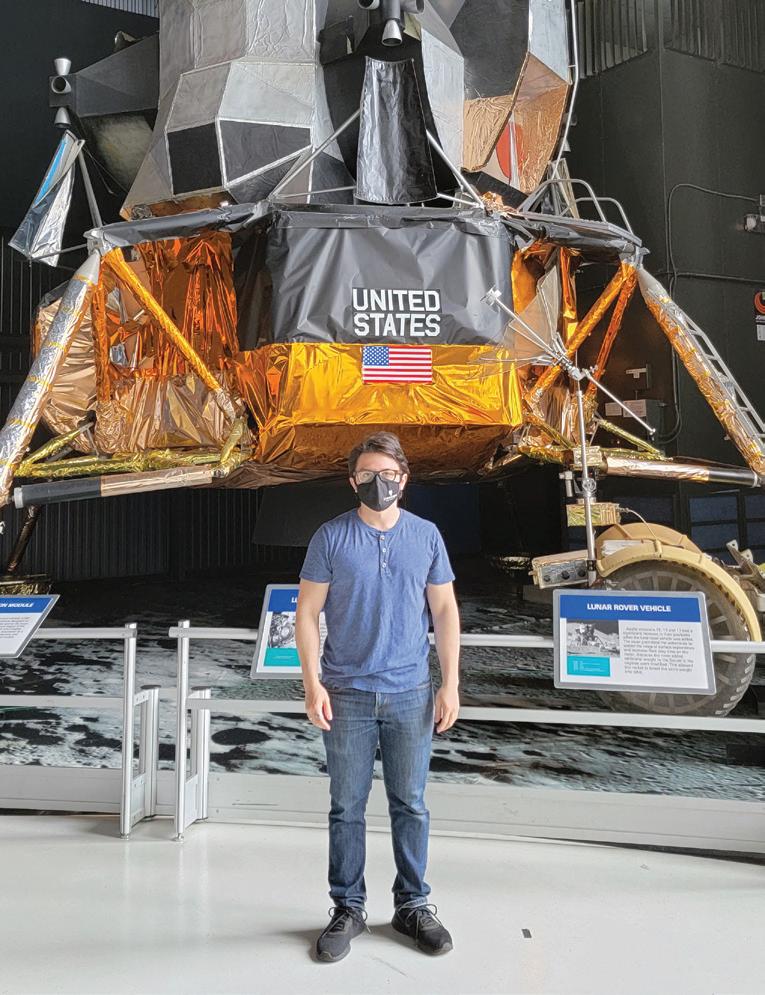

“Since I accepted the NASA fellowship, every summer for the next few years, I will be at a NASA facility of my choosing for 10 weeks, where I get to perform experiments related to my research with other NASA scientists,” Díaz-López says. “I will also be paired with a mentor who will be my liaison, so I can access any resources from NASA that I may need. In a sense, I work directly with NASA now, and it’s just unbelievable.”
NASA’s NSTGRO sponsors U.S. citizen and permanent resident graduate students who show the potential to contribute to their goals of creating innovative new space technologies. Researchers, like Díaz-López, will perform innovative research at their respective campuses and at NASA Centers.
16 N winter 202 3 ON CAMPUS
Valedictorian of the class of 202o, Miguel Díaz-López ’20 was awarded not one but two prestigious fellowships before ultimately deciding on the NASA Space Technology Graduate Research Opportunity, through which he will study the Plume-surface interaction. He is a third-year doctoral student at Johns Hopkins University.
At Dorothy Day Lecture, Speakers Share Memories of the Candidate for Sainthood
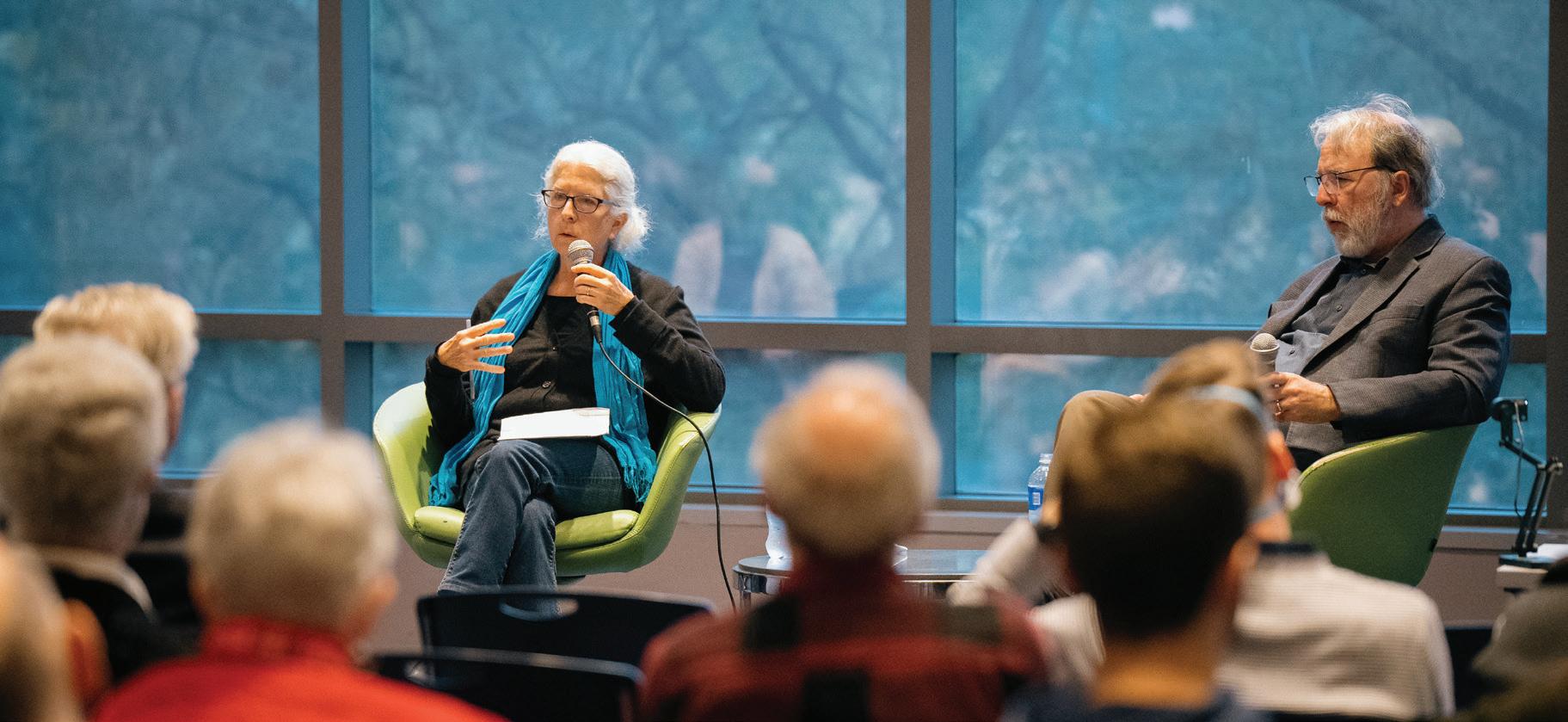
Hennessy also explained that her relationship with her grandmother gave her an idea of what it is like to be in the presence of God.
“She understood each person that came in front of her, in terms of their strength and who they are, their positions, their natures,” she said. “She was so encouraging to everyone and always remembered to stand with nonviolence.”
DOROTHY DAY, THE CATHOLIC ACTIVIST known for her social justice campaigns in defense of the homeless, hungry and poor, is in the process of becoming formally recognized as a saint by the Catholic Church. In keeping with Manhattan’s commitment to sharing Day’s story, the College hosted its eighth annual Dorothy Day Lecture in November.
Sponsored by the Dorothy Day Guild and moderated by Kevin Ahern, associate professor of religious studies, the event featured guest speakers Martha Hennessy, a social justice activist and Day’s granddaughter, and Robert Ellsberg, editor-in-chief and publisher of Orbis Books, a leader in religious publishing. Since 2015, Manhattan College has hosted the lecture and supported student summer research projects to learn more about Day’s contributions to society.
In honor of the event being held on All Saint’s Day, Ahern asked Hennessy and Ellsberg what saints mean to them. Hennessy addressed the importance of studying the lives of the saints, praying to them, and naming our children after them.
“Our saints give us examples of how to live and serve as an inspiration to all of us,” she said.
Ellsberg noted that it wasn’t until his encounters with Day that he completely understood what it meant to be a saint and the significance of modeling oneself after them. While working with Day, he learned about the veneration of saints. “Saints help us to walk the path of holiness, an attitude that Day always had,” he said.
When asked how Day has shaped him and what people can learn from her, Ellsberg responded: “People like Day help us to see and understand reality in a new way. By following her example, we can recognize Jesus in a new way, see the Gospel in a new way, and overall understand reality better.” He noted that Day was always pushing for peace, solidarity, workers’ rights, and concerns for the earth, stating that these were all “values that can provide a handbook on how we should be living.”
Hennessy also noted that a new Staten Island Ferry named after Day, who lived in Staten Island for many years and was a regular ferry rider, was officially commissioned in November.
“My grandmother loved the Staten Island Ferry, so what an honor to have one named after her,” she said.
Ahern and Julie Leininger Pycior, professor emeritus of history, were involved in planning the official commissioning of the vessel.
Both presenters urged alumni, professors and students to support the cause of Day’s canonization. Hennessy stressed that Day might be used as a model for dealing with any suffering we could be experiencing.
“It is possible to learn from, live for, and apply Dorothy Day’s lifetime of service to our own lives,” she said.
Manhattan College will soon serve as the home of the Dorothy Day Center for Study and Promotion of Social Catholicism to educate others on her works and continue her legacy. Embodying the College’s Lasallian mission, the center will host events and lectures as a tribute to Day’s immense contributions to the Catholic Church, in hopes of carrying on her message.
MANHATTAN.EDU N 17 LECTURE CIRCUIT
Martha Hennessy, Dorothy Day’s granddaughter, and Robert Ellsberg, publisher of Orbis Books, at the Dorothy Day Lecture this past fall.
LECTURE CIRCUIT
What’s Happening in Iran?
Manhattan Community Explores the Woman, Life, Freedom Movement


THE DEATH OF MAHSA AMINI, a young Kurdish woman who was detained in September by Iran’s religious morality police for improperly wearing the hijab, has sparked widespread human rights protests led by Iranian women. In November, Manhattan College hosted an informal discussion with students and faculty members about the current situation in Iran and what Americans can do to prevent the suffering and mistreatment of Iranian women.
The event was sponsored by Campus Ministry and Social Action, the Lasallian Women and Gender Resource Center, the Muslim Student Association, and the Holocaust, Genocide, and Interfaith Education Center. Faculty members Mehnaz Afridi, professor of religious studies, Pamela Chasek, professor of political science, and Evelyn Scaramella, professor of modern languages and literatures, provided insights into the religious, political, historical and cultural aspects that have contributed to the protests in Iran.
Amini’s arrest and the history of Iran’s mandatory hijab were both discussed in the opening video, which showed footage of women leading protests, burning their hijabs, and cutting off their hair in response to Amini’s death and in protest of the restrictions on their daily lives.
“No woman should be taken to jail, beaten or even killed for her preference regarding the hijab. It should be a personal choice between a woman and her God,” said a student representative of the Muslim Student Association.
Chasek started the discussion by describing the history of U.S.-Iran relations. She noted that the curtailing of women’s rights has been a long-running issue in the country and that Iranian women are now challenging the law and asserting their human rights.
“Looking at where we are today, and over time, we have seen countless protests that Iranian women have led throughout Iran,” she said. “They protested the dress code and the overall violence against women. Especially in more urban areas, women collectively began pushing the boundaries of the hijab law, started wearing makeup, colorful head scarves, and intentionally allowed their hair to peek out from under their scarves, which is the exact offense that Amini was arrested for.”
From a religious perspective, Afridi told students that this issue should be taken seriously regardless of one’s background, religion, race, ethnicity or gender. She emphasized that Amini’s killing was not merely the instigator of a movement, but it was the death of a young woman.
“We must be really careful on how we talk about her,” Afridi said. “Sometimes we use these symbols and these bodies as tokens, and I want us to be careful of that and make sure we do not do that when talking about Mahsa Amini.”
The students were then given the opportunity to contribute to the conversation.
One student asked, “As a Western nation, what, if anything, should we be doing about this injustice we are witnessing in Iran?”
Chasek responded that the United States must tread carefully, since directly supporting the protestors would be seen as meddling in Iranian domestic affairs.
“Right now, the best we can do is to advocate from here and continue to hold lectures and events for awareness,” she said.
Toward the end of the discussion, students voiced their opinions on what they thought students should be doing during times of crisis like this. One student said that we should recognize that the fight for women’s rights in Iran is multigenerational and can be seen through the actions taken by the protestors’ mothers and their grandmothers in order to survive.
“It’s important that we show up when lectures are held about this issue,” another student commented. “By showing numbers and giving our support, it is like us saying that we have [the protestors’] backs.”
Several departments and student groups on campus gathered to discuss the religious, political, historical and cultural aspects of the protests in Iran that were sparked by the death of Mahsa Amini, who was detained and killed for improperly wearing her hijab.
ON CAMPUS 18 N winter 202 3
Alumna Offers Insights from Four-Decade Career in Finance at Gargano Lecture
EILEEN MURRAY ’80, HON.D.SC. ’15 has more than 40 years of experience in the finance industry, having held senior leadership roles at Morgan Stanley, Credit Suisse and Duff Capital Advisors. Most recently, she served as chair of the Financial Industry Regulatory Authority, and from 2010 through 2020, she served as co-chief executive officer of Bridgewater Associates. In October, Murray returned to campus for the annual Ambassador Charles A. Gargano Lecture, to share her experiences and wisdom with Manhattan College students in a fireside chat moderated by the dean of the O’Malley School of Business, Donald Gibson, and global business and economics major Paris LeCleir ’24.
The first question that Murray addressed in her conversation, Walking the Talk, was what brought her to Manhattan College and how that choice shaped her career in finance. Murray noted that the professors and courses challenged her to push herself, and stressed that the College’s commitment to integrity and teamwork was one of the things she valued most about her education.
“I have terrific memories of Manhattan College,” she said. “I can’t think of any other place that would have prepared me better for my career, in terms of the successes that I have had, and even the failures.”
Murray told students that learning how to network with others is one of the most important skills they should take away from her talk. She noted that treating others how you would like to be treated has helped her to get most of her promotions in her successful career.
Spending her formative years in the Dyckman Street housing projects in the Bronx, Murray grew up with people from different countries, cultures and religions, which proved to be an asset in her career.
“If you become a manager, you always
have to make sure to put yourself in someone else’s shoes,” she advised. “What are they feeling? What is their day like? It’s not about yelling at them or trying to discipline them, but instead, giving them the opportunity to realize their potential and treating them like you want to be treated.”
In 2008, U.S. Banker named Murray as one of the 25 Most Powerful Non-Bank Women in Banking, and in 2013, she was named one of Hedge Fund Journal’s 50 Leading Women in Hedge Funds. She also was Manhattan College’s first alumna recipient of the De La Salle Medal and was awarded an honorary doctoral degree from the College in 2015.
LeCleir asked if Murray thought that progress has been made in diversifying leadership in the context of women in executive positions. Murray noted that when she graduated from college, less than 1% of senior positions were held by women, while today that figure has increased, ranging from 17% to 23%.

“Honestly, I don’t know whether to do the happy dance or go home and cry about this statistic,” she said. “Although we have made progress, we certainly have not made enough, and we must keep pushing for inclusion and diversity.”
Near the end of the lecture, Murray discussed environmental, social and governance (ESG) investing. She is working to bring together regulators and businesspeople to discuss solutions rather than to justify their positions.
When asked whether a recession is coming, Murray expressed her optimism that it would be short-lived.
“Here’s one thing I am certain of: There will be an end to this recession,” she said. “The people that will come out of this are the strongest people who have planned and prepared for it.”
More than 140 students, faculty and
alumni attended the annual lecture, which honors Ambassador Charles Gargano ’79, former chairman and commissioner of the Empire State Development Corporation and vice chairman of the Port Authority of New York and New Jersey. He was also a member of the Manhattan College Board of Trustees and in 2009 established the Ambassador Charles A. Gargano ’79 Endowed Chair in Global Economics and Finance.
Eileen Murray ’ 80, Hon.D.Sc. ’ 15, who most recently served as chair of the Financial Industry Regulatory Authority and co-chief executive officer of Bridgewater Associates, shared experiences from her successful career in finance with business students at the annual Ambassador Charles A. Gargano Lecture in October.
MANHATTAN.EDU N 19 LECTURE CIRCUIT
SPORTSSHORTS
LONDON CALLING
The men’s basketball team headed to London, England, during Thanksgiving weekend as one of four teams to play in the inaugural London Basketball Classic. The tournament consisted of two semifinal games, a third-place consolation contest, and a championship game. The Jaspers opened the classic against Northeastern inside the Copper Box Arena in Queen Elizabeth Olympic Park Manhattan and Northeastern went back and forth during the final minute of regulation time before the Huskies came away with the two-point win in overtime, 69-67. In the consolation game, Manhattan hung on to beat Army West Point, 72-71. Princeton ultimately won the championship. This was the second time the Jaspers crossed the Atlantic for an event with the MAAC and Inspirus Sports Management. In 2017, Manhattan played in the Belfast Classic in Northern Ireland against Holy Cross and Towson.
JASPER ADDED TO THE SAN DIEGO PADRES 40-MAN ROSTER
Former Manhattan baseball pitcher Tom Cosgrove ’18 was added to the San Diego Padres 40-man roster in November. Cosgrove pitched three seasons for the Jaspers and was a 12th-round selection by the Padres in 2017 after he earned Second Team All-MAAC honors. He graduated ranked sixth in the College’s history with 225 strikeouts. In 2017, Cosgrove was a two-time MAAC Pitcher of the Week and ranked 48th nationally, with 105 strikeouts.
MEN’S LACROSSE WINS 2022 MAAC CHAMPIONSHIP
For the first time in 20 years, Manhattan won the MAAC Men’s Lacrosse Championship. The Jaspers defeated St. Bonaventure, 8-7. Justin Malpica ’22 scored a hat trick in the championship game to power the Jaspers to the conference title and was named MVP of the championship. Jack Shanley ’23, Kyle Gucwa ’23 and Sean MacKinney ’22 also scored for the Jaspers. Brendan Krebs ’21, ’22 made five stops in goal for Manhattan, which went on to face Vermont in the opening round of the NCAA Tournament. Liam Walshe ’22, ’23, Luke Pacher ’21, ’22 and Tadhg O’Riordan ’22, ’23 were selected to the 2022 MAAC All-Championship Team, joining Malpica.
SAAC HELPS MAKE STRIDES IN BREAST CANCER WALK
The College’s Student-Athlete Advisory Committee (SAAC) participated in the Making Strides Against Breast Cancer Walk in Central Park in October. Overseen by the American Cancer Society, Making Strides is a five-mile noncompetitive walk that takes place in more than 160 locations nationwide. SAAC President Kaya Simpson ’23, a member of the track and field team, was the driving force behind more than 200 student-athletes from across several teams taking part in the event.
BJORKMAN ’22 NAMED MOST OUTSTANDING FIELD PERFORMER
Nina Bjorkman ’22, a five-time MAAC All-Academic Team selection across indoor and outdoor track and field, was named Most Outstanding Field Performer at the 2022 MAAC Outdoor Track & Field Championships. Bjorkman won the event to earn her first MAAC crown with a best of 50.90 meters in the hammer. Her winning throw came on her sixth and final attempt. She took home the discus on the second day of the championship. Bjorkman was more than 2.5 meters clear of second in the discus with a best of 49.95 meters — a new personal record. She also recorded a 10th-place finish in the shot put.
VOLLEYBALL PLAYERS ADDED TO MAAC ALL-ACADEMIC TEAM
The MAAC announced that seven Jaspers made the 2022 Women’s Volleyball All-Academic Team. To be eligible, a student-athlete must hold a cumulative grade point average of 3.20. Representing the Jaspers were Elizabeth Brown ’23, Christina Katsamouri ’23, Sophia Lotto ’25, Kelly Markowski ’23, Julieanne McKee ’23, Julia Menocal ’22 and Isabella Nascimento ’25.
MANHATTAN SHINES IN LATEST GSR REPORT
The NCAA released the Graduation Success Rate (GSR) for the 20122015 entering cohorts in November, with the Jaspers posting a perfect GSR in 11 programs. A perfect GSR is based on a comparison of the number of students who entered a college in a given year and the number of those who graduated within six years of their initial enrollment. Manhattan posted perfect GSR rates in baseball, men’s golf, men’s lacrosse, men’s swimming and diving, women’s basketball, women’s cross country and track and field, women’s lacrosse, women’s soccer, softball and volleyball. As a whole, the Jaspers maintained a GSR of 97.
TWO TEAMS ACE THE NCAA APR REPORT

Women’s cross country and women’s soccer received a perfect APR score of 1,000 in the NCAA’s summer report. The APR (academic progress rate) holds institutions accountable for the academic progress of their student-athletes through a team-based metric that accounts for the eligibility and retention of each student-athlete for each academic team. Four teams posted scores between 990 and 999: softball, women’s lacrosse, women’s rowing and women’s track and field. Men’s lacrosse was the top-scoring men’s sport, with a 985. The other Manhattan teams posted scores of 965.
229 JASPERS PLACED ON THE MAAC ACADEMIC HONOR ROLL
For the 2021-22 season, 229 Jaspers made the MAAC Academic Honor Roll, an increase from last season’s total of 215. The top three sports were women’s soccer, men’s lacrosse and women’s rowing. To be eligible, an athlete must hold a cumulative GPA of 3.20 or higher.
SPORTS 20 N winter 202 3
Statue Honors Track and Field Legend

GEORGE SHEEHAN
’40, a Jasper track and field star, is remembered for his enduring contributions to the sport that he loved. On Dec. 4, the Christian Brothers Academy (CBA) in Lincroft, New Jersey, celebrated his legacy by dedicating a statue of Sheehan dressed in a Manhattan College cross country jersey, a larger-than-life tribute to a man who dedicated much of his life to running.
In 1959, with help from the Brothers of the Christian Schools, Sheehan, a respected cardiologist, became one of three founders of CBA. The seven-foot bronze statue is a gift from the Sheehan family to the school and is near the new track and field facility that bears his name: the Sheehan Track & Field Complex. The statue was created by Brian Hanlon, who is the official sculptor of the Naismith Memorial Basketball Hall of Fame.
A member of the Manhattan College Athletic Hall of Fame, Sheehan was an integral part of the Jaspers 1939 Intercollegiate Association of Amateur Athletes of America championship team, and was the 1940 Junior National Amateur Athletic Union indoor mile champion. He was inducted into the Athletic Hall of Fame in 1992. His son, George Sheehan III ’67, was considered one of the greatest long-distance runners in College history and was inducted into the Athletic Hall of Fame in 2004.
Years later, the elder Sheehan rediscovered his youthful passion for running, and at 50, he ran a 4:47 mile, which was the world’s first sub-five-minute time by anyone of that age. In 1989, he set the national men’s indoor 1,500-meter record for age 70 and older. When the running craze took off in the 1970s, Sheehan began documenting the phenomenon, writing eight books including Running & Being: The Total Experience, a New York Times bestseller. He was the medical editor of Runner’s World and served as a consultant to the President’s Council on Physical Fitness. He passed away in 1993, at the age of 74.
“George Sheehan left a powerful legacy as an accomplished track and field athlete during his years at Manhattan College more than 80 years ago and that legacy can still be felt today,” says Kerri Gallagher, director of cross country, track and field at the College.
FUN FACTS
229 Manhattan placed 229 student-athletes on the 2021-22 MAAC Academic Honor Roll.
U20
50
Matt Padre ’21, ’22 (baseball) reached base in all 50 games for the Jaspers in 2022.
40
R.J. Decker ’24 finished 40th at the NCAA Track & Field East preliminary rounds in the hammer throw this past spring, with a best of 57.83 meters.
Grace Lipponer ’22 (women’s lacrosse) established three new single-season records: goals (63), assists (34), and points (97) in 2022. The attack also paced 100 career goals this past season. 3
2nd
Freshman David Mlynek ’26 recorded a pair of top-10 finishes during the fall golf season. Mlynek finished solo 10th at the Hartford Hawks Invitational and closed the season tied for fourth at the Metropolitan Intercollegiate. 10 32
Men’s soccer finished in a tie for second place in MAAC standings and made the semifinals of the MAAC Championship this fall. Manhattan beat Fairfield in the opening round. 3
The Jaspers earned 32 postseason All-MAAC honors or were conference champions during the spring semester across men’s and women’s basketball, men’s and women’s indoor and outdoor track and field, men’s and women’s lacrosse, baseball, softball and women’s rowing.
Sean MacKinney ’22, Jake Nicolosi ’22 and Grace Lipponer ’22 were named to the men’s and women’s lacrosse senior all-star games.
More than 150 student-athletes and staff participated in the annual Tunnel to Towers 5k Run & Walk in September, honoring those who died on Sept. 11, 2001.
Women’s basketball Helena Galunic ’25 played for her home country of Croatia in the FIBA U20 European Championships Division B this past summer. 150
MANHATTAN.EDU N 21
Esports Power Up at Manhattan
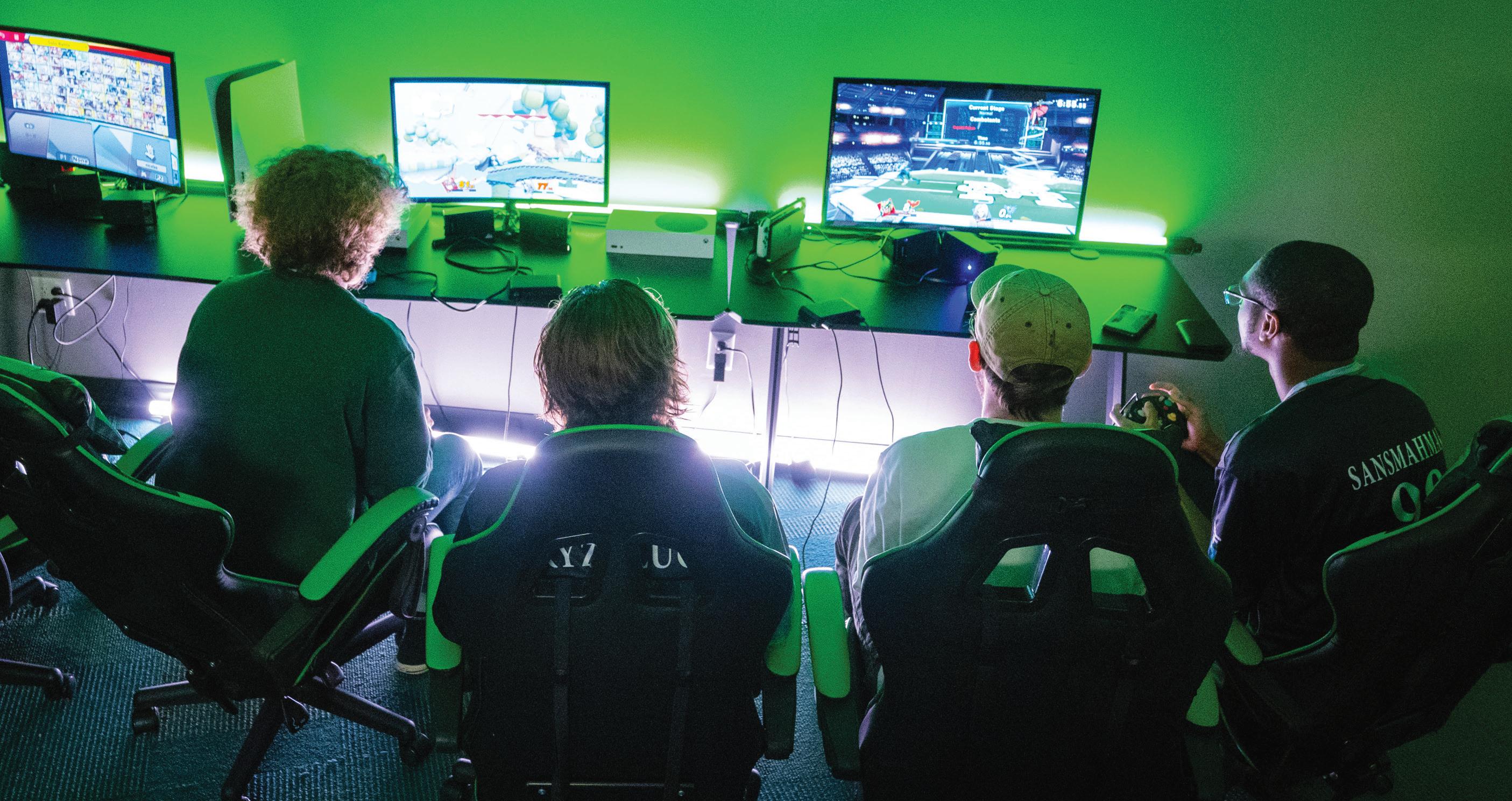
VIDEO GAMES HAVE BEEN AROUND for more than six decades, ever since the introduction of Tennis for Two in 1958. Since then, gaming has grown exponentially. According to the International Trade Association, by 2020 the global video game industry was valued at $159.3 billion, with 2.7 billion gamers worldwide. At least one gamer resides in three-quarters of U.S. households, and countless websites are dedicated to competitive video gaming known as esports. Even traditional sports media outlets like ESPN and SI.com are devoting an increasing amount of coverage to esports games and players. At the collegiate level, esports has exploded in popularity with students, and Manhattan College’s team is rapidly gaining members and racking up wins. Once you learn about these Jaspers, you’ll surely be a fan.
 BY CECILIA DONOHOE
BY CECILIA DONOHOE
BUT FIRST, PRACTICE
It’s Monday evening, and classes are over for the day. On the first floor of the Kelly Commons, in a room painted lime green, esports practice — one of several held per week — is about to start. Students stroll in and seat themselves in pairs in front of five video monitors. Within minutes, all five screens are illuminated, and 10 students are immersed in one-on-one combat between their characters in the video game Super Smash Bros. Ultimate.
Derek Criollo ’21, coach of the esports program, and Sean Powers ’23, the Smash Bros. team captain, provide an onlooker with a quick tutorial: Each of two players try to knock the other’s chosen character off a platform, called a stage. Different characters (there are 89 in all, from Captain Falcon to Zelda) possess different abilities. The weaker an opponent becomes, the easier it gets to knock them off the stage. Of course, it’s way more complicated than that, but these basics are enough that a nongamer can watch and (mostly) follow along.
Throughout the three-hour practice, Criollo observes each pair of players, now and then offering a word of advice. Most strategizing and analysis, he says, takes place in real time, with players coaching each other.
“During the games, we talk about what to do, what not to do,” Criollo says. “Players make suggestions to each other, in-game, on the fly. Then, before a game against another school, we discuss do’s and don’ts. We know the players on the other teams, what characters they’re going to use, and what their playing styles are.”
A major in computer information systems, Powers prefers to play a character called Kirby. “I enjoy Kirby because he has a lot of jumps in the air and can do a lot of low attacks that are hard to hit,” he says.
He will likely deploy Kirby in Manhattan’s Smash Bros. game against Mount St. Mary’s this week. A week ago, in the first matchup of the spring 2023 season, the team notched a 17-9 win over Marist.
Currently, the Super Smash Bros. squad is the only esports team that utilizes Manhattan’s gaming room. Playing in person “is a specific aspect of the Smash community,” Powers explains.
The four other esports teams — League of Legends, Rocket League, Overwatch and Valorant — require desktop PCs to run their games, rather than the Nintendo Switch gaming consoles used for Smash. Ask
FACTS & STATS
Super Smash Bros. Ultimate
• Plays in both fall and spring seasons
• Fall 2022 record was 7-4, placing fourth in the MAAC
• Placed fourth in the spring 2022 season, with a record of 6-3
• Appeared in the semifinals of the 2022 Esports MAAC Championships
• Rival: Iona
Rocket League
• Plays in fall season
• Ended the fall 2022 season in fifth place in the MAAC, with a record of 3-4
• Rival: Iona
League of Legends
• Plays in spring season
• Placed second in the spring 2022 season
• Appeared in the finals at the 2022 MAAC Esports Championships, defeated by Marist
• Rivals: Fairfield, Marist
Overwatch and Valorant
• The newest teams to Jasper esports. The Overwatch team began competing in the spring 2023 season; as of press time, they are tied for sixth place out of 10 teams. Valorant will debut in the fall.
• Rivals: Coming soon, stay tuned!
anyone from Manhattan esports about their gaming equipment, and new PCs for the esports room will inevitably come up. But they’re much more interested in discussing their most powerful assets — skill, teamwork and determination.
AN EXTRACURRICULAR WITH A COMPETITIVE EDGE
Since 2018, esports at Manhattan has grown from a small college club to a competitive team, with 35 players going head-to-head against 10 other colleges in the Metro Atlantic Athletic Conference (MAAC).
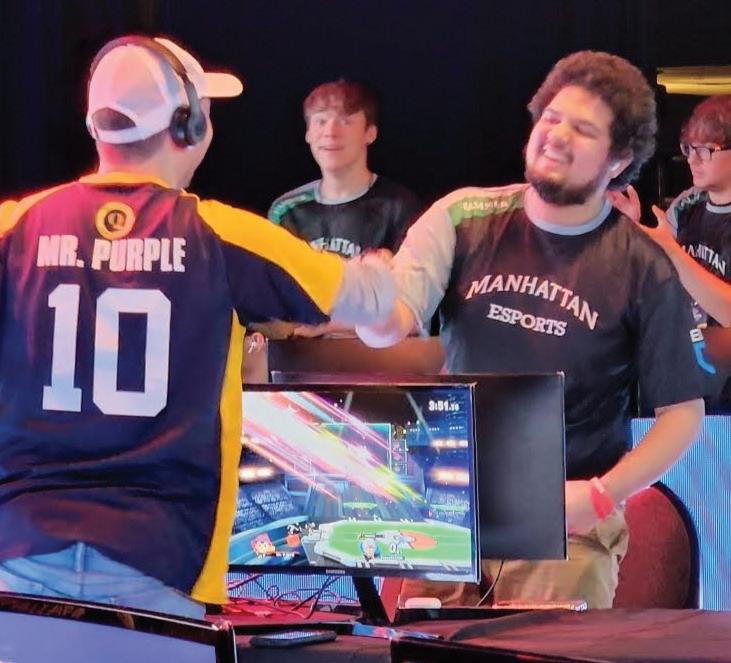
“That number is going to increase because we just added two more games, Overwatch and Valorant, to our esports program,” says Carmella Liscio ’21, ’24 (M.S.), recreation and esports manager. “There are also 50-plus students who compete in tournaments hosted by the Super Smash Bros. team in the esports room.”
How has esports grown so quickly? “Word of mouth is huge,” Liscio says. “They also use flyers and social media, as well as the Discord platform where gamers can talk to each other.”
The College recognizes the benefits students gain from competitive gaming. “Manhattan is on the bus with esports; we said ‘yes’ from the get-go,” says John Bennett ’03, assistant vice president of student life. “Esports is a real way to connect the segment of our population that’s into gaming and a great way for them to make friends on campus. It also connects with many majors, as well as the gaming industry itself — computer programming, marketing, management.”
Prospective students are increasingly interested in colleges’ esports offerings. In keeping with the trend, Liscio has noticed an
MANHATTAN.EDU N 23
uptick in queries about esports at Manhattan’s Open House events. “At the esports table, so many students were coming around to ask which games we have,” she notes. “Many students will choose a school that has an esports program over one that doesn’t.”
Vice President of Student Life Ronald Gray concurs, noting that many colleges and universities are building esports programs. “As an institution, we should make sure that we are on the forefront of this,” he says, “because that’s where our students are, from the heavy gamer to the weekend gamer.”
Michael Grabowski, professor of communication, says that plans are in progress for the College to offer a major in game design and production, in addition to the minor currently available. Such programs, together with esports and the Communication department’s sports media production concentration, “are all necessary for one another and complement one another, allowing people to understand and enjoy what is happening in the gaming field,” he says.
Recently, Jasper esports teams have had the experience that gaming pros enjoy — seeing their characters play on a big screen, in front of live audiences. For the past two years, the team has headed to Atlantic City, New Jersey, for the MAAC Esports Championships, which are played in an arena setting, viewed by live audiences, and streamed live over Twitch.
“The team travels down the same week in March that our spirit and basketball teams go,” Bennett says. “They practice and have hard discussions about games, and it’s really cool to see.”
IN IT TO WIN IT So, who can play esports?
“It’s for everyone,” Criollo says. “We have international students,
people from the swim team, we’ve had a soccer player. It’s not people who don’t have lives or introverts. Everyone should feel they can join without preconceived ideas.”
This sentiment is unanimous among the players. Hieu (Jason) Lam ’24, a computer science major from Hanoi, Vietnam, has been participating in tournaments since high school and is now captain of Manhattan’s League of Legends team. “Esports is a competitive scene, but it’s for everybody,” he says. “It’s very welcoming.”
Powers points out that students don’t have to join a team to be involved in esports. The Smash Bros. team hosts Friday open tournaments that have been well-attended by gamers of all levels. “If you just enjoy the game and want to talk to people about it, we have a community for that,” he says. “At the end of the day, we’re just playing a game and having fun.”
That sense of fun is what brought computer engineering major Sofia Bernabei ’24 back to the team. She played League of Legends her freshman year, but drifted away when other commitments, including her sorority, kept her busy. Now a junior, she has rejoined esports on the new Overwatch team. “You can do both a sorority and esports,” she says. “It was important to me to stay true to that.”
The players also are united in a sense of pride in playing for the College, and appreciation for the camaraderie between teammates and the friends they’ve made along the way.
“It’s just an honor to be representing your school in something that you’re passionate about,” Powers says. “A big thing in esports is getting to know people and creating connections. My teammates are some of the best friends I’ve ever made.”
The honor of representing the College is not lost on Lam, who feels as strongly about his League of Legends team as any traditional athlete does about their sport. “You’re playing to win, and every one of your teammates are trying their best,” he says. “When you achieve a victory, it’s very satisfying. When you fail, it gives that same bitterness
that any sports player experiences when they lose a match. I would like to prepare my team so that we are ready for the glory when we actually pick up the MAAC cup.”
“We’re all naturally very competitive as well, so as much as I want to have fun, I want to get better,” Bernabei agrees. “I want to win. I think there’s a great environment here for improving as a team.”
Powers is graduating this spring, but has high hopes for the future of Jasper esports. He’d like to see the program expand to include more players and even higher-tech computers. Lam’s vision is for the program to offer more activities for nongamers and, eventually, to host teams from other colleges at on-campus tournaments.
“That’s what the dream is,” he says. “Right now, my goal is to lay the groundwork. I hope that one day when I come back as an alumnus, the dream will come to fruition.” And just maybe, he adds, “I will be able to sponsor the team myself.”

24 N winter 202 3
“I want to win. I think there’s a great environment here for improving as a team.”
SOFIA BERNABEI ’24
Photos by
ESPORTS EVOLUTION
Spacewar! – The first esports competition, held in October 1972 at Stanford University’s Artificial Intelligence Laboratory. About two dozen Stanford students competed in the video game Spacewar! in what organizers called “the first intergalactic spacewar Olympics.” Two events were held: A five-man free-for-all, and a team competition. The prize? A year’s subscription to Rolling Stone. Visitors to the Computer History Museum in Mountain View, California, can still play Spacewar! on a one-ton PDP-1 computer.
Evo Moment #37 – A definitive event in esports history. It took place when two topranked gamers, Justin Wong and Daigo Umehara, were battling it out in a game of Street Fighter at the 2004 Evolution Championship Series tournament. By executing 15-straight parries requiring split-second timing, Umehara captured a stunning comefrom-behind win. (Check out video clips on YouTube, which also capture the spectators’ rapturous cheers.)
Beyond Stereotypes – Diversity in esports is predicted to grow as the popularity of video gaming soars. According to a 2021 article in The Washington Post, “Women are just as likely as men to play video games, and it is a passion that spans generations: the average gamer is between the ages of 35 and 44, while 15% of gamers are 55 or older. There are 33 million gamers with disabilities in this country, and within the next decade, it is estimated that people of color will make up the majority of younger video game players in the United States.”

At Manhattan, the opportunity to play esports is open to all, and the players welcome all comers who share their passion for gaming. Ronald Gray, vice president of student life, explains: “I think it’s important to provide this opportunity for those students who are coming into Manhattan College to make those connections, to engage with people from different perspectives, different faiths, different races, different genders and gender identities.”

A NOOB’S GUIDE TO GAMING AND ESPORTS
Noob – A newbie to gaming, of course!
Genres – RTS (real-time strategy), RPG (role-playing game), MOBA (multiplayer online battle arena), fighter and sports are just a few of the many classes of video games. Manhattan’s esports teams play games from several categories. For example, League of Legends is a MOBA, Super Smash Bros. Ultimate is (as the name implies) a fighter game, while Rocket League, which has been described as “soccer, with cars” is a sports-based game.
(Previous page, right) Super Smash Bros. Ultimate player Elias Lopez Herrera ’24 greets a competitor from Quinnipiac during the 2022 MAAC Esports Tournament in Atlantic City. (Opposite page) Players gather around Sam Bravate ’23 and Thierno Diallo ’24 to watch their characters square off. (This page, top right) Overwatch player Sofia Bernabei ’24 hopes that more Jasper women will join esports. “Even though it’s technically Division I, it’s open to new players and all skill levels,” she says. “When I tell people I’m on the esports team, it’s a great conversation starter.” (Lower, right) The League of Legends squad at the 2022 MAAC Esports Championships. (Above) A screenshot from a Manhattan vs. Mount St. Mary’s Super Smash Bros. match in which Diallo (Pineapple) is handily winning. In Smash, the percentages at the bottom of the screen reflect “damage” to the players — the higher your “damage,” the more easily your character can be knocked off the stage and defeated.

Twitch – Hugely popular livestreaming platform through which gamers can broadcast their games and viewers can interact with each other. Watch the Jaspers compete against their MAAC rivals on www.twitch.tv/ manhattanesports.
Caster – Short for shoutcaster; an esports commentator. The MAAC Esports Championship features casters who provide analyses of players, characters, matchups and tactics.
Rig or setup – Slang for a desktop PC that’s customized for gaming.
MANHATTAN.EDU N 35
MANHATTAN.EDU N 25
PHOTOS OF ESPORTS PRACTICE BY JOSH CUPPEK AND OF SOFIA BERNABEI 24 BY CHRIS TAGGART
Celebrating Our Grads
THE LOCATION MAY HAVE BEEN NEW, but the Jasper spirit was as vibrant as ever as the Manhattan College classes of 2022 received their degrees at the 180th Commencement Exercises. Held at the Meadowlands Exposition Center to allow for social distancing while also giving graduates the chance to celebrate together and with loved ones, both undergraduate and graduate ceremonies took place on the same day, May 18.

A few days earlier, on May 15, the Spring Honors Convocation recognized students who attained membership in the College’s
foremost honor society, Epsilon Sigma Pi. Medals and prizes were also bestowed, including the Gunn Medal, one of the College’s highest undergraduate honors. The recipient, Eunice Nazar ’22, a double major in history and peace and justice studies, earned Dean’s List status every semester and was one of only 212 students in the nation to be awarded a Newman Civic Fellowship. She was an active member of the College Senate and Student Government, volunteered on a service immersion trip to El Paso, Texas, and was selected to participate in the Women Inspiring Successful Enterprise program, among many other achievements.

26 N winter 202 3 COMMENCEMENT
At the undergraduate ceremony, valedictorian Jessie Rising ’22 acknowledged the unique pandemic-related challenges faced by the class of 2022, and applauded their “resilience throughout this unprecedented season.” A biology major and captain of the College’s softball team, Rising then shared a personal story of triumph over hardship that her family experienced when her older brother, Michael, suffered a traumatic brain injury in 2020. His long and often arduous recovery required patience and faith. Rising advised her fellow graduates to “embrace small victories” during difficult times.
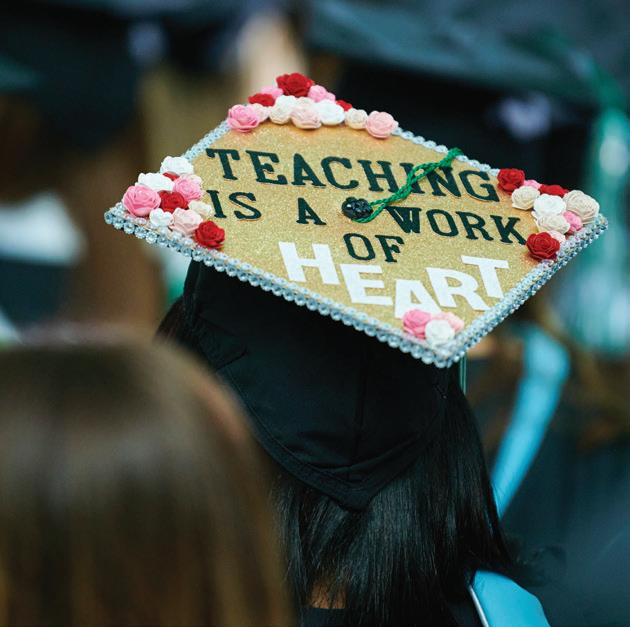
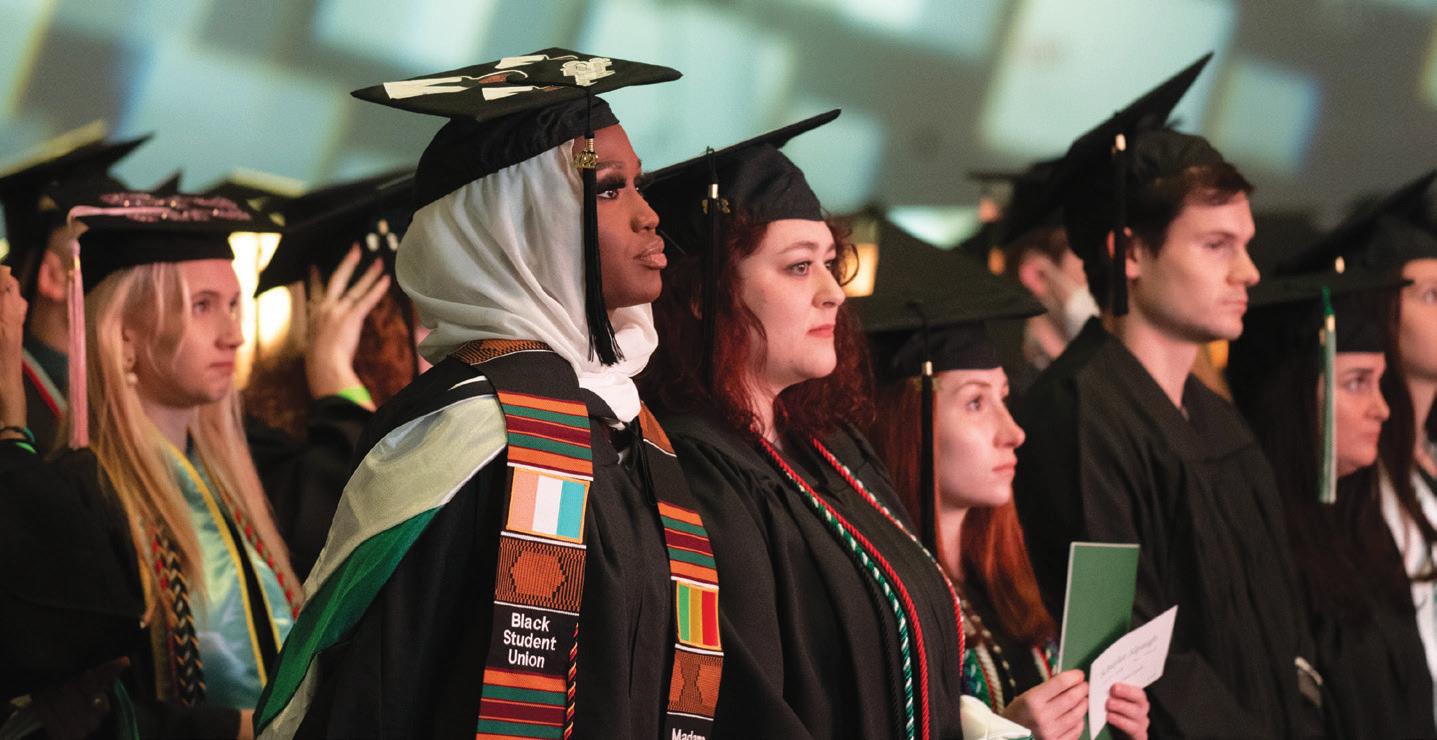
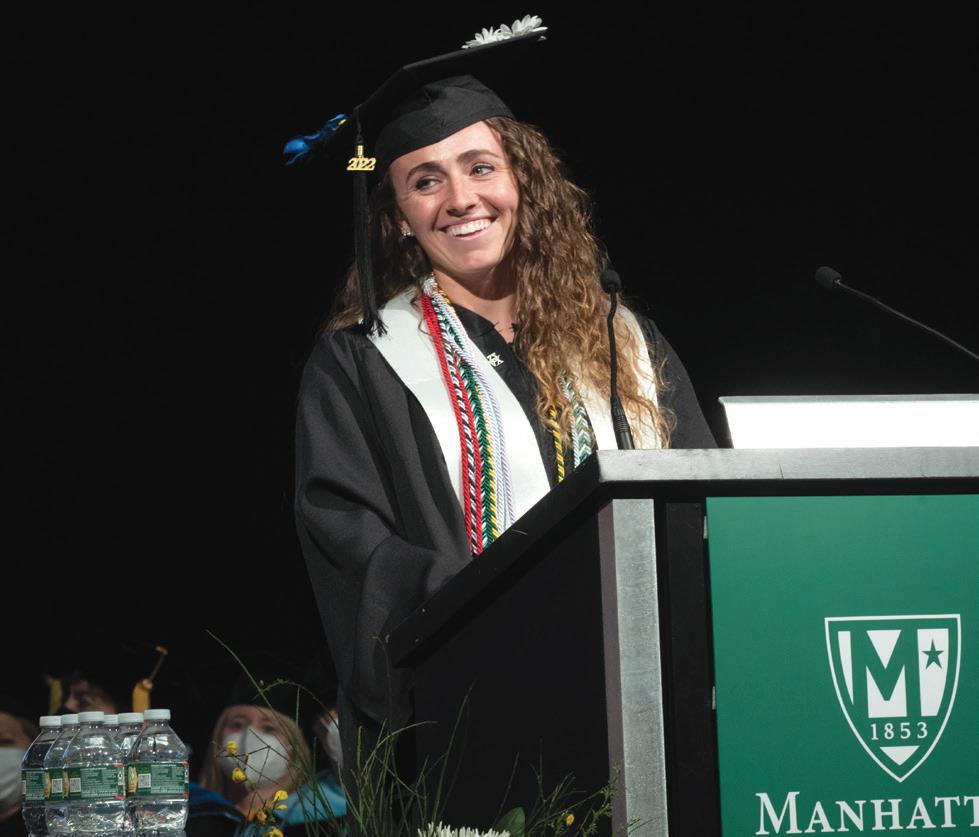
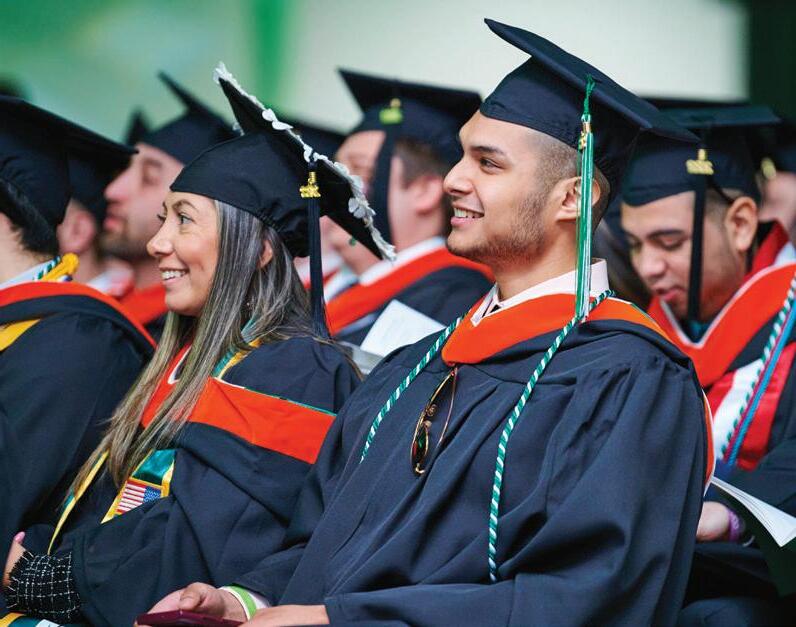
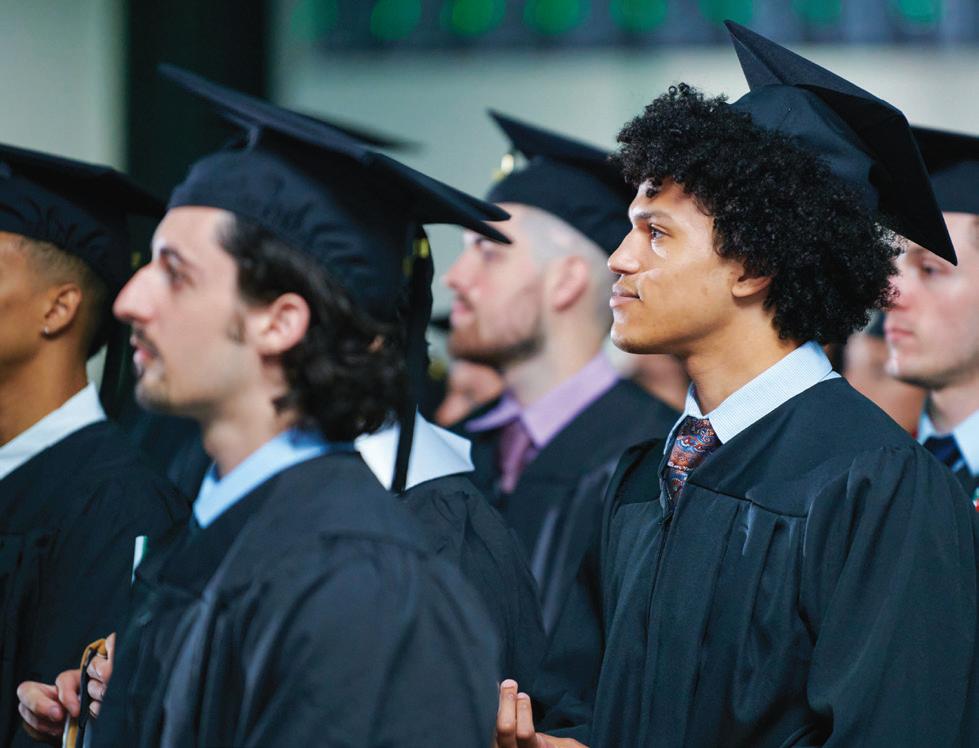

“Set big goals,” she continued. “Set goals that are so big that they scare you, and then chase those goals one little victory at a time.”
Commencement speaker Sister Norma Pimentel, MJ, executive director for Catholic Charities of the Rio Grande Valley, received an honorary doctorate in humane letters for her work providing ministry and outreach to immigrants. She challenged her listeners to be instruments of good “in times of suffering and of joy.”
People of faith, she said, should be guided by the Holy Spirit. “It is the spirit of God that will make you feel the fire within to act, to speak, to not be afraid,” she continued. “It will free you so that you are not paralyzed and indifferent, so that you do not ignore human suffering and injustice.”
Sr. Norma urged listeners to be a voice for the voiceless, “so that you can offer help where help is needed. This is how we begin the work for justice.”
MANHATTAN.EDU N 27
Celebrating on the Quadrangle after the Spring Honors Convocation.
Valedictorian Jessie Rising ’22 encourages grads to set big goals.
Sister Norma Pimentel: Raising Her Voice for Asylum Seekers
WHEN
SISTER NORMA PIMENTEL
RECEIVED HER HONORARY DOCTORATE in humane letters from Manhattan at the 180th Commencement ceremony, she was already a friend of the College, having visited campus in February 2020. At that time, she received the Manhattan College Peace and Justice Medal in recognition of her commitment to providing food, shelter, counsel and other forms of humanitarian relief to thousands of migrants at the U.S. southern border. As executive director of Catholic Charities of the Rio Grande Valley, the charitable branch of the Diocese of Brownsville, Texas, she leads the agency’s initiatives to assist those in need throughout the region.

In her remarks, she discussed her work helping asylum seekers at the TexasMexico border. “The migrants are human beings, and treating them this way will help us reclaim our humanity,” she said. “The people I see coming through the border are here to work and provide for their family. Our job as Catholics is to
respond by caring for them, raising our voices and spreading the message of faith, hope and love for all.”
Raised in Brownsville, Sr. Norma originally planned to pursue the life of an artist, earning a Bachelor of Fine Arts at the University of Texas Rio Grande Valley. She was considering graduate school when a friend invited her to join a prayer group. The experience proved transformative: “Something changed in me,” she has said of that time. She entered the Missionaries of Jesus in 1978 and went on to earn a master’s degree in theology from St. Mary’s University and a master’s in counseling psychology at Loyola University.
In 1980, in response to the surging numbers attempting to cross the border, Sr. Norma helped establish Casa Oscar Romero, a shelter in Brownsville. Her work gained momentum when she assumed her current role in 2004. She helped found the Humanitarian Respite Center in McAllen, and spoke out against policies that separate
THE GRADUATE CEREMONY, held later in the day, also featured speakers who offered words of inspiration while addressing the unique circumstances under which the graduates earned their degrees. Valedictorian Rachel Bowers ’22 (M.A.) earned a master’s degree in school counseling. She praised her classmates’ fortitude during the pandemic.
“Our creativity was tested in developing safe ways to connect with professors, friends and loved ones while simultaneously managing our own health and well-being,” she said, noting that “we didn’t skip a beat.”
Bowers, who served three years as a Lasallian volunteer in Tulsa, Oklahoma, and Tucson, Arizona, also highlighted the uniqueness of the Manhattan College experience. “I encourage you to let your Lasallian educational experience link your passions and joys within your career with the skills and talents that you have cultivated on your individual scholastic journey as you venture into this new chapter,” she said. “Acknowledging one’s career as a vocation is a beautiful reminder to go beyond the traditional work day and the expectations that come along with that.”
migrant children from their families.
Throughout the years, her efforts have drawn international acclaim. She has received the University of Texas Rio Grande Valley’s 2019 Distinguished Alumni Award; the 2018 Hispanic Heritage Award for Service; and Catholic Charities USA’s 2015 Martin Luther King Jr. “Keep the Dream Alive” Award; among others. In 2020, Time magazine named her among its 100 most influential people of the year, and in 2022, she received the Pacem in Terris Peace and Freedom Award. Pope Francis has publicly thanked Sr. Norma for her work, and in 2015 she addressed the United Nations at the invitation of the Permanent Observer of the Holy See.
The graduate Commencement speaker, James McCann, founder and executive chairman of 1-800-Flowers.com, was the recipient of an honorary doctorate of humane letters. McCann shared a major takeaway from his 40 years as a florist, most especially during the COVID-19 pandemic: the importance of relationships throughout life. He encouraged the graduates to nurture existing relationships, rekindle old ones, and create new ones.
“We all have this amazing power to change the way people feel,” he said. “And I’m here to tell you that I’ve never in all my years alive, in all my years in business, heard someone say, ‘I have way too much love, way too many good relationships in my life.’ I’ve never heard it, and don’t expect I ever will.”
The 2022 Commencement ceremonies were also the final ones of Brennan O’Donnell’s 13-year tenure as president of the College. He sent graduates forth with a benediction that asked of God, “… to keep alive through your life your love of learning, your passion for justice and your imaginative engagement with the world … and always and ever to lead you through your heart and mind to ever-clearer understanding of what you are called to do; and to give you the faith and the courage to do it.”

28 N winter 202 3 COMMENCEMENT
James
McCann:
Making a Life’s Work of Delivering Smiles
AS THE FOUNDER AND FORMER CHIEF EXECUTIVE OFFICER of 1-800-Flowers. com Inc., James McCann has been a revolutionary force in the floral industry. A pioneer in using tollfree numbers and the internet to reach customers and build sales, 1-800-Flowers.com today ranks among Fortune’s list of the 100 fastestgrowing companies.
McCann earned a bachelor’s degree in psychology from the John Jay College of Criminal Justice in 1974 and went on to serve as a program administrator at a group home for boys. To support his growing family, he also tended bar on the weekends and ended up purchasing the florist across the street.
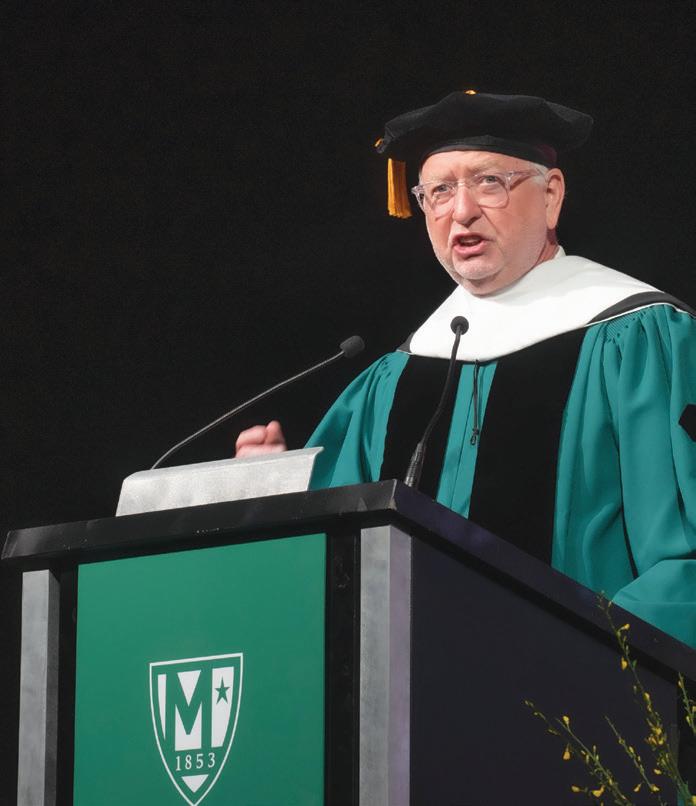

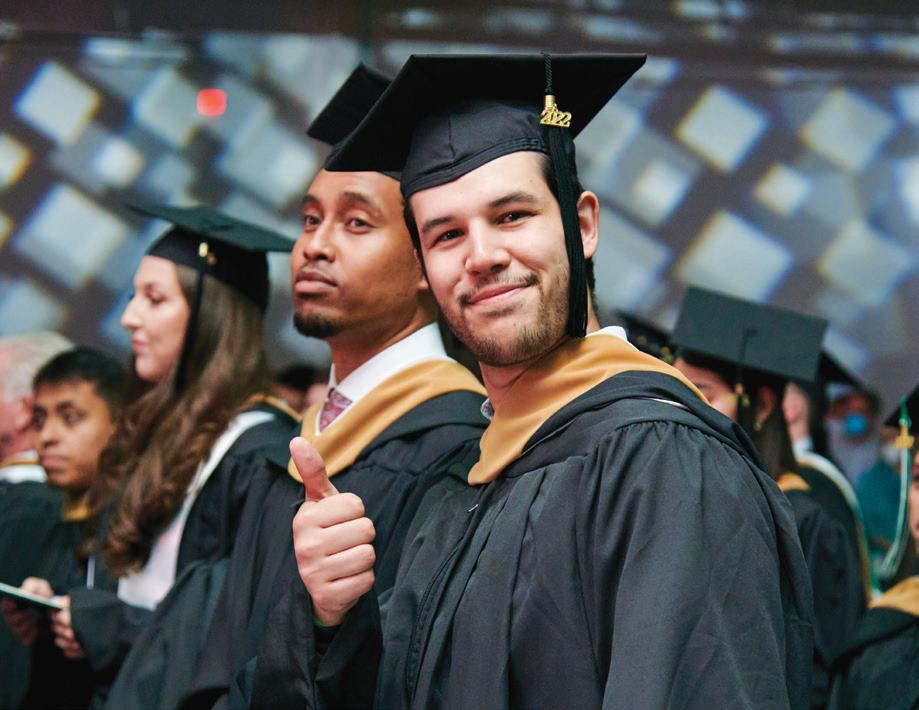
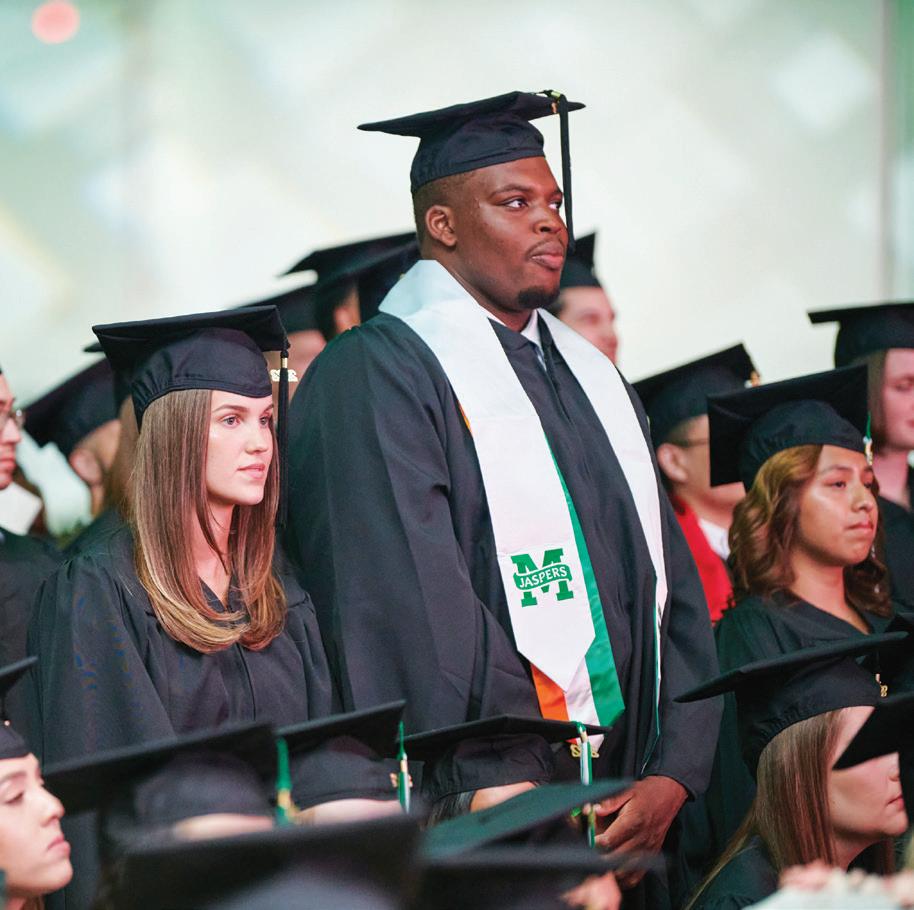
That decision led to the billiondollar enterprise of today. McCann enjoyed building relationships with customers, helping them to mark many of life’s most significant occasions. He bought more shops, including one that owned the famed telephone number that became the name of his business. In the 1990s, the emerging internet brought new opportunities, which McCann quickly adopted, making 1-800-Flowers one of the first retailers with an online presence. In 1999, the company went public.
Throughout his career, McCann has been an advocate for adults with developmental disabilities. In 2015, the McCann family founded the nonprofit Smile Farms Inc., which provides
developmentally disabled adults with meaningful work opportunities at farms, urban gardens, greenhouses and farm stands. Smile Farms has become the signature philanthropic partner of 1-800-Flowers.com.
In 2016, McCann stepped down as chief executive officer of the company. He continues to serve as chair and remains active in philanthropic causes.
MANHATTAN.EDU N 29
Valedictorian Rachel Bowers ’22 (M.A.) praises her classmates.
In a Record Year for Giving, De La Salle Dinner Raises $1.3 Million for Student Aid

PRAISING HIS ALMA MATER for always providing students with the skills “to succeed at the next level” in all their endeavors, attorney and business leader John Desmarais ’85 served as the guest of honor at Manhattan College’s 2022 De La Salle Medal Dinner, which raised more than $1.3 million for student aid.
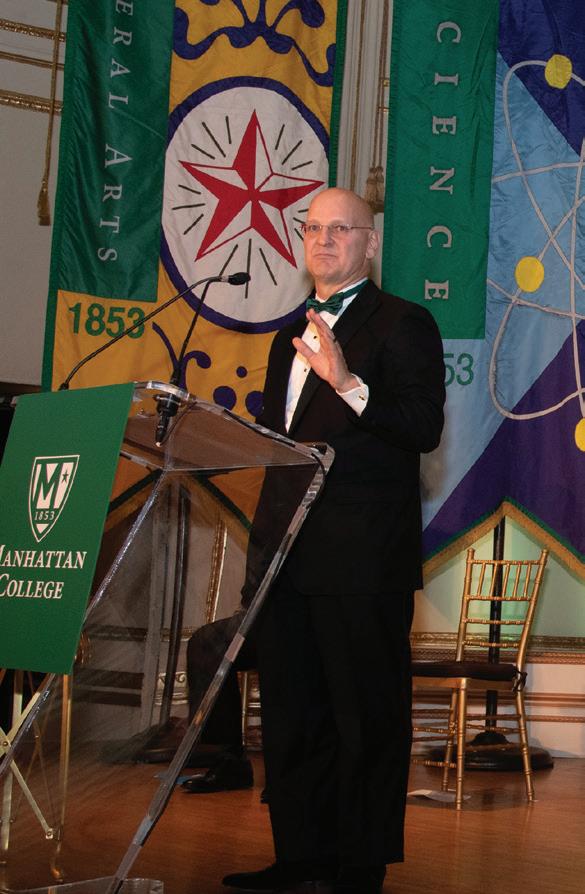
“Manhattan is a special place with a special mission,” said Desmarais, founding partner of Desmarais LLP, an intellectual property law firm. “The College changed the trajectory of my life — as it has done, and still does, for so many others.”
The De La Salle Medal Dinner is Manhattan’s principal fundraising event. Established in 1951 and held annually since 1977, it honors outstanding corporate leaders who embody Lasallian Catholic values. Proceeds support scholarships and other forms of undergraduate assistance.
This past year’s dinner took place at The Plaza New York in April. Mary Beth McDade ’93, an Emmy Award-winning anchor and reporter at KTLA 5 News in Los Angeles, served again as the master of ceremonies. McDade opened the evening by noting the honoree’s extensive contributions to the intellectual property field, as well as his leadership as a Manhattan trustee.
Brother Daniel Gardner, FSC, who had been appointed interim president at the time of the dinner, offered the invocation. Manhattan trustees Thomas Meloro ’86, a partner at Willkie Farr & Gallagher LLP, and Noreen Krall ’87, retired vice president and chief litigation counsel at Apple Inc., served as dinner co-chairs.
Krall spoke of her long friendship with Desmarais. “When I think of
John,” she said, “the words that come to mind are ‘care’ and ‘compassion.’ His work ethic, passion for his clients and his craft are among the top in the legal profession.” In addition, “John demonstrates Lasallian principles such as concern for the poor and social justice, respect for all persons and a commitment to quality education.”
President Emeritus Brennan O’Donnell then presented the medal to Desmarais. “In honoring him tonight, his alma mater truly takes pride in his professional accomplishments,” O’Donnell said. “We also take pride in his reputation as a really great human being — something I can testify to personally.”
Delivering his remarks with humor and humility, Desmarais used a presentation he created especially for the occasion. He described the transformational impact the College has had on him. “I grew up in a working-class family,” he said, “Italian immigrants on one side, French Canadians on the other. Manhattan was the perfect choice for a firstgeneration student.”
The College, Desmarais observed, shapes lives in two distinct ways. First, there is the high academic quality and strong personal support for which Manhattan is so well known. In addition, the strong alumni network benefits Jaspers long after they graduate.

“Class sizes are small,” he explained. “Professors know you by your first name. If you’re struggling, they help you. If you’re succeeding, they encourage you. I had many job offers upon graduation. So did all of my friends — and they were well-paying jobs.”
After earning his degree in chemical engineering, Desmarais went on to New York University and received his J.D. degree in 1988. As a young lawyer, he personally witnessed the benefits of Manhattan’s close-knit alumni network.
“I wanted desperately to get into the United States Attorney’s office here in New York,” he recalled. “I applied for the job, interviewed, and my application sat there — not rejected, but also not completed.”
That was until he received a call from John F. Keenan ’51, then a federal judge in the Southern District of New York, who heard that “a Manhattan College kid was trying to become an assistant U.S. attorney.” Desmarais was offered the job the next day.
In the years since, Desmarais has emulated Keenan’s example. “I enjoy giving back, and I am happy to do what I can for other alumni, as well as today’s students.” That, he said, is an especially meaningful part of the Manhattan College experience: “It doesn’t end at graduation.”
30 N winter 202 3 DEVELOPMENT
John Desmarais ’85, founding partner of Desmarais LLP, is awarded the De La Salle Medal at the College’s annual dinner in April. Desmarais joins College trustees and dinner co-chairs Thomas Meloro ’86 and Noreen Krall ’87 in celebration.
“A Different Kind of Scholarship” Where Donors and Recipients Are Family
When it comes to the Donald R. Broderick Memorial Scholarship Fund, consistency is key. For almost four decades, this Manhattan College scholarship has been making a difference in the lives of young Jaspers due to the large numbers of alumni and friends who support the fund, year after year. Unlike many scholarships that are established via sizable donations, since 1986, the Broderick Scholarship has been sustained mainly by gifts of $1,000 or less.
The endowed scholarship, which currently supports eight students, was created in memory of Fran and the late Raymond Broderick’s son, Donald, who graduated from Manhattan College in 1986 and died in a car accident shortly after graduation. Donald had participated in student life throughout his college career as a member of his fraternity and a four-year player on the College’s football team. The scholarship began small, mainly supported by Donald’s Alpha Sigma Beta fraternity friends and family, and grew over the years. To date, it has raised more than $1.2 million dollars.
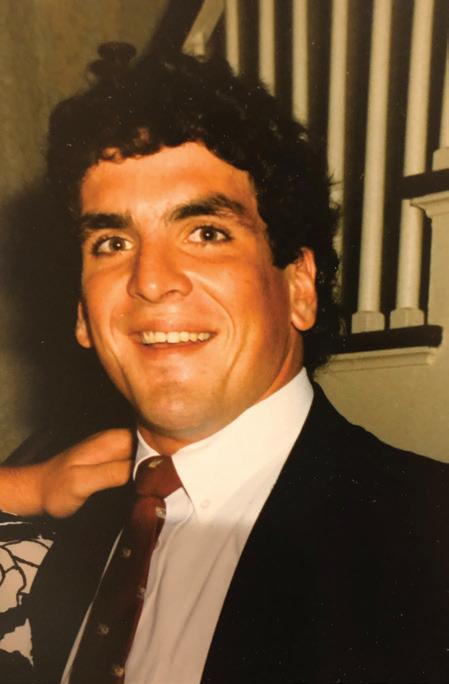
Fran Broderick, a retired faculty member in the Communication department at the College of Mount St. Vincent, says she finds it heartwarming that people come together and create such a strong endowed scholarship.
“The Broderick Scholarship is a different type of scholarship,” she says, noting that recipients “become family.” She continues, “We stay in touch while they’re in college and when they graduate. We go to their weddings, graduations, family events. Ray and I lost a son, and Russell and Edward ’82 lost a brother, but we gained another big family.”
Many members of that larger family gather annually at a fundraising golf outing and dinner, which is held each fall at the Westchester Hills Golf Club in White Plains, New York. This event, which has a dedicated committee led by Tom Avezzano ’84, serves as one of the major ways to consistently
raise funds each year. The goal is to bring the endowment portion of the fund up to $2 million so that a student at every grade level is able to receive a partial scholarship.
Terrence Tunnock ’21, who was a Broderick Scholar, graduated magna cum laude from the O’Malley School of Business with a Bachelor of Science in Computer Information Systems (CIS). He was also awarded the Professor William P. Cain Medal for Computer Information Systems. Currently, he works as a financial institution specialist with the Federal Deposit Insurance Corporation.
“The Broderick Scholarship not only eased the financial burden of my education but welcomed me into a community whose support and guidance were mainstays of my academic career, and which I am privileged to remain a part of,” he says. “Meeting with current and former Broderick Scholars at events like the annual dinner and golf outing helped me chart a course for success in my future career. I would not be where I am today without the Broderick family’s dedication and generosity, for which I will always be grateful.”
John Howard ’24, a junior studying accounting, also points to the strong network the scholarship provides. “The Donald R. Broderick Memorial Scholarship creates a strong network of recipients that share this extreme honor, always remembering
Donald and his impact as a student and an athlete,” he says. “I am extremely grateful for this generous gift, which helps further my academic endeavors. I am excited to see what the next two years bring as a Jasper.”
An active participant in campus life, Howard is a member of the Beta Alpha Psi Business Honor Society, treasurer of the Delta Kappa Epsilon Fraternity, a bagpiper for the Manhattan College Pipes and Drums Band, a member of the Gaelic Society, and plays intramural flag football and soccer.
Involved students and successful alumni like Tunnock and Howard exemplify the high caliber of Broderick Scholarship recipients. At this time, preference is given to students who are graduates of Donald’s high school alma mater, Archbishop Stepinac High School in White Plains, New York. Applicants should be in the top half of their class and have high ethical standards, with the expectation that they will put superior effort into their college preparatory studies. Fran Broderick hopes to grow the endowment enough to also give scholarships to young women who have graduated from Maria Regina High School in Hartsdale, New York.
She often points to faith in God as one of the ways her family continues to celebrate Donald’s life, rather than mourn. It is, she says, “his legacy.”

MANHATTAN.EDU N 31
(From left to right) Donald Broderick ’ 86. Fran Broderick (front row, center) joins a group of Broderick Scholars at the 2022 Donald R. Broderick Golf Outing and Dinner in September at the Westchester Hills Golf Club, including current scholar, John Howard ’ 24 (back row, second from left) and alum, Terrence Tunnock ’ 21 (first row, third from the right).
Cohen Foundation Awards $828,000 to Five STEM Students
The Steven & Alexandra Cohen Foundation has awarded Manhattan College an $828,000 grant in support of the Steven & Alexandra Cohen Scholarship Fund. This scholarship program was created specifically for underserved students with outstanding high school academic accomplishments who commute to the College from in and around New York City. It is the largest donation the Cohen Foundation has given to the College and covers nearly 90% of student tuition and fees throughout their four years.
Manhattan College holds a special place for members of the Cohen Foundation. Alexandra Cohen, the foundation’s president, was a communication major who commuted to the College from her home in Washington Heights. Jeanne Melino, the foundation’s executive director, majored in government and also commuted to the College.

“For all of the students selected as Cohen Scholars, a college education seemed financially out of reach,” Alexandra Cohen says. “We are proud to partner with Manhattan College and support highachieving students fulfill their dreams of attending college.”
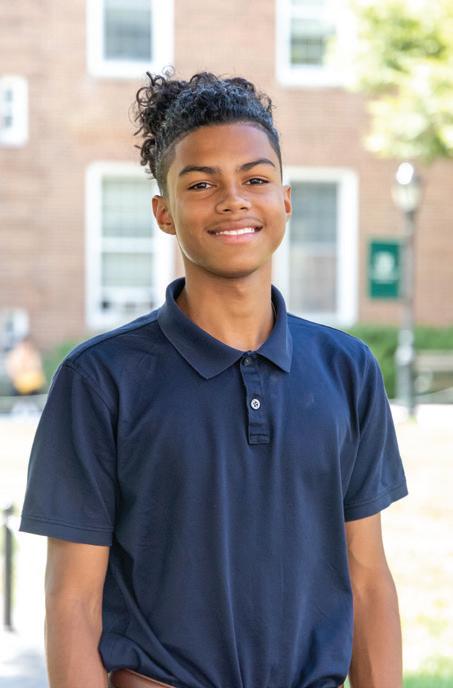

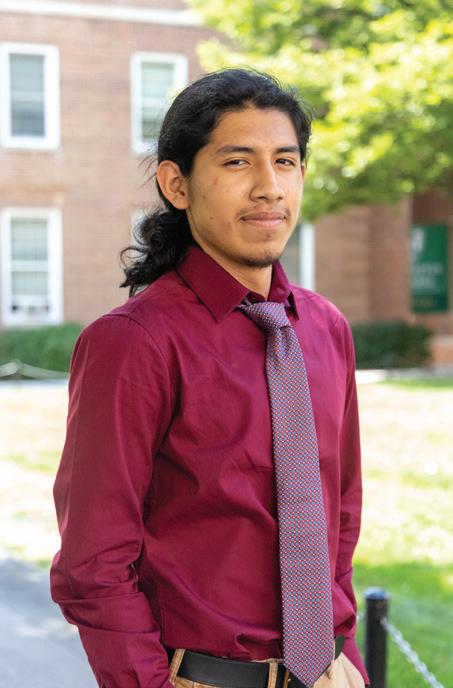

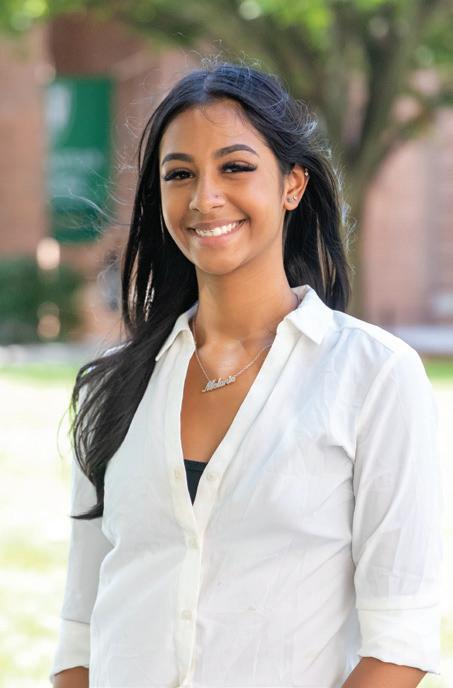
Five first-year science and engineering students have been selected as Cohen Scholars: MELANIE BEHARRY ’26, who attended Cathedral High School in Manhattan and is studying biology on a pre-health profession track; RODRIGO BARBERAN ’26, who attended Cardinal Spellman High School in the Bronx and is studying biochemistry; JARED BRAVO ’26, who attended Brooklyn Latin High School and is studying civil engineering; JULIO MARMOL HERRERA ’26, who attended International Leadership Charter High School in the Bronx and is studying computer science; and ETHAN PEREZ ’26, who attended All Hallows High School in the Bronx and is studying computer science.
The students selected for this scholarship worked closely with the College’s admissions team since the beginning of their senior year.
“We’d like to thank the Steven & Alexandra Cohen Foundation for this generous and consequential gift,” says Brother Daniel Gardner, FSC, president of Manhattan College. “The gift offers five deserving New York City commuter students the opportunity to attend Manhattan College and to take the first steps toward achieving their dreams in a caring environment of excellence.”
The Steven & Alexandra Cohen Foundation is committed to inspiring philanthropy and community service by creating awareness, offering guidance, and leading by example to show the world what giving can do. The Foundation’s grants support nonprofit organizations based in the United States that either help people in need or solve complex problems. The Foundation also spearheads grassroots campaigns to encourage others to give.
32 N winter 202 3 DEVELOPMENT
“For all of the students selected as Cohen Scholars, a college education seemed financially out of reach.”
– Alexandra Cohen
First-year students Melanie Beharry, Rodrigo Barberan, Jared Bravo, Julio Marmol Herrera and Ethan Perez have been selected as the first group of Cohen Scholars at the College.
With Help from a Patterson Scholarship, Education Major Is Working to Make an Impact in the Classroom
ANGELA MEISTER ’25 HAS ALWAYS BEEN AN AVID READER. She estimates that her personal home library has about 700 books, and counting.
“Growing up, I loved reading and writing,” she says. “I had great English teachers. There was nothing about English that I didn’t like.” Another notable influence was her mother, a special education teacher in Dutchess County, New York. “She absolutely loves it — she finds the work so rewarding.”
So it stands to reason that upon enrolling at Manhattan, Meister chose to major in adolescent education, with a concentration in English. In pursuing a teaching career, she has set her sights on one goal in particular — to instill in young people a love of reading. Her ambition springs from an observation she made in high school.

“When I decided that I wanted to be an English teacher, one of the things I noticed among my peers was that almost no one was actually reading the books that we were assigned,” she says. “Many students — I want to say 80% — were using online study guides like SparkNotes and Schmoop. For instance, when Shakespeare was assigned, I asked students if they were reading it. No one was.”
Meister is determined to change that. Along with the classic literature that is a standard part of school curricula, she hopes to introduce students to contemporary works that are more plotcentered. She cites The Selection Series of young adult novels by Keira Cass, which explore themes like class, power and poverty. “I think that there could be a real difference in reading levels if we as future educators acknowledge that students don’t always connect with older works,” she asserts.
It’s a happy coincidence, then, that Meister is the recipient of a James Patterson ’69 Scholarship, gifted by its namesake, the powerhouse bestselling author (see profile on page 47). Established by Patterson in 2015, the scholarship provides tuition assistance to students enrolled in the School of Education and Health, primarily education majors. It came just in time for Meister, as due to the pandemic, her father had been laid off from his job.
“During that time, [my attending] college was in question,” she says. “To get a scholarship from a writer whose books I’ve read and liked was so amazing and encouraging. My family was really ecstatic.”
While working toward her degree, Meister has benefited from the “family-like” atmosphere at Manhattan and the dedication of professors like Tracy Lahey, assistant professor of education. Lahey made class “fun and engaging,” she says. “For my first semester here at Manhattan, she provided an amazing introduction to my major and helped me be secure in the knowledge that I wanted to pursue it further.”
Teacher preparation programs in the School of Education and Health require students to complete 100 hours of observation during the first three years of study, followed by student teaching in their senior year. For three semesters, Meister has been working every day at the after-school program at Amber Charter School in the Kingsbridge section of the Bronx.
“I usually supervise between 20 and 25 third graders,” she explains. “We go through their homework — the students come up with the answers. I try to structure things like their day-school program.”
In order to increase motivation and foster acts of kindness in the classroom, Meister developed a punch-card reward system that recognizes students for “going above and beyond.” She smiles when describing positive outcomes, such as the time one student offered his jacket to a classmate who was feeling unwell. “I think the best thing is to provide acknowledgement and explain to the other children why a reward was earned,” she says. Her system, in which a goody bag is earned for every 10 rewards, has proved so popular that it has been adopted in many other classrooms at the school.
One of the things Meister looks most forward to in her teaching career is being able to answer students’ questions and “seeing it click” when they grasp the material. The Patterson Scholarship is helping her achieve that vision.
“It’s great to know that you’re making a difference by teaching kids, and that they’ll carry what they’re learning into the future,” she concludes. “It’s so important for growth of any kind, and just inspiring to me.”
MANHATTAN.EDU N 33
Hall of Fame Inducts Athletic Stars Spanning Four Decades
AT THE 43RD ANNUAL CEREMONY AND DINNER in November, eight individuals were inducted into the Manhattan College Athletic Hall of Fame Class of 2022, and two outstanding teams were selected for special recognition. This year’s class features athletes and coaches in eight sports whose contributions to the College span nearly 40 years.
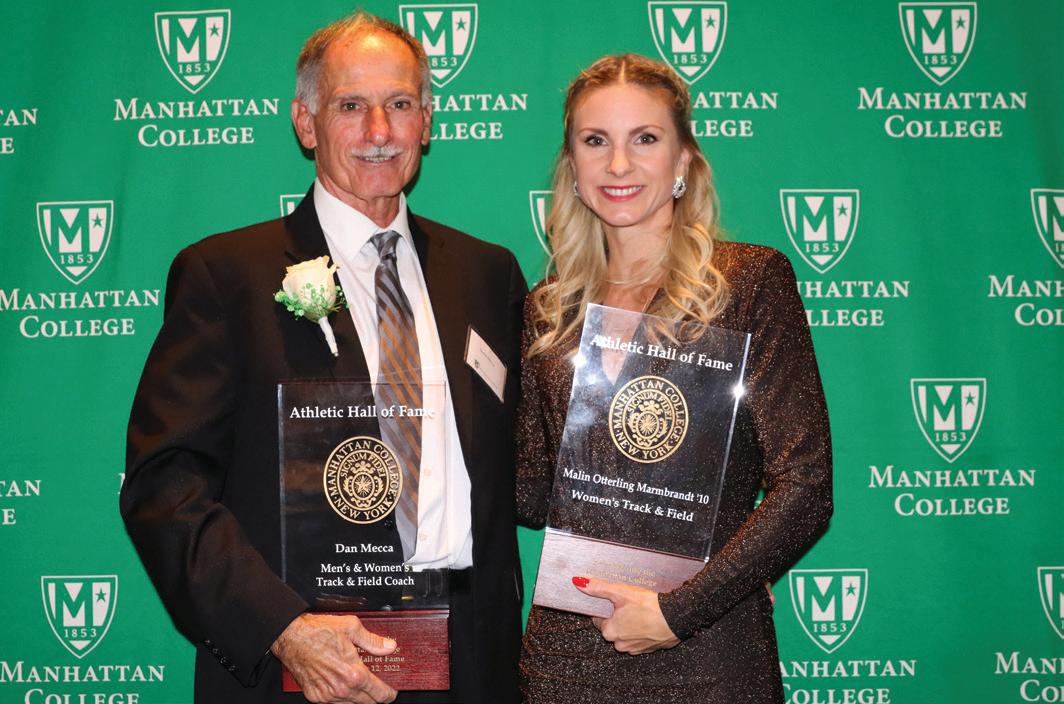
Jeanine Hanratty ’95 was an All-MAAC volleyball honoree as a senior and was named to the MAAC All-Tournament Team in 1994. During her time on the team, Hanratty helped lead the Jaspers to the semifinals. Individually, she holds the Manhattan record for assists in a single season with 1,302 and sets played at 142. Hanratty is among the Jaspers all-time top 10 in assists, hitting percentage, and solo blocks. Academically, she was a three-time MAAC All-Academic Team member and earned the Jasper Award in 1994-95. She was also a two-time Outstanding Performer Award winner for volleyball.
John Kennelly ’78 helped Manhattan go 8-0 in league play to win the title as a freshman. He was a three-time tennis team captain during his sophomore through senior seasons. He recorded a 10-match winning streak as a junior while playing first singles and first doubles and helped the Jaspers post a winning record in three of his four seasons. Kennelly was also named team MVP as a junior in 1976-77 and a two-time most outstanding performer for the Jaspers.
Malin Marmbrandt Otterling ’10 left her mark in the long and triple jump for the Jaspers. In 2010, Marmbrandt became the lone female student-athlete to win the long jump and triple jump at the ECAC Championships. She still holds both the indoor and outdoor school record in the long jump and placed second in the triple jump. During her athletic career, Marmbrandt was a 10-time MAAC Champion, a four-time ECAC long jump champion, and a two-time ECAC triple jump champion. At the Metropolitan Championships, she won the long and triple jumps eight times.
Dan Mecca, head coach, men’s and

women’s track and field, was promoted to men’s and women’s cross country and track and field coach in 1993 after coaching the men’s field events since 1986. During his 36 years at the College, Manhattan won 17 MAAC men’s indoor team titles, 14 men’s outdoor titles, 13 women’s indoor titles, 11 women’s outdoor titles, five MAAC women’s cross country titles, and one IC4A men’s indoor title. Manhattan won the MAAC indoor men’s team title every year from 1997 to 2013 and the women’s indoor title every year from 1999 to 2006. He coached a total of 40 All-Americans and five NCAA Champions, and won 33 MAAC Coach of the Year Awards. In addition, athletes trained by Mecca have competed at the Olympics, World Championships, European, Pan American and Caribbean Championships.
Jaci Rahey ’11 was a two-sport athlete for the Jaspers, playing softball and volleyball. On the diamond, Rahey was a two-time first team All-MAAC selection and a First-Team, All-Region selection in 2010. She finished her career second all-time in MAAC history in both home runs and RBIs, and helped the Jaspers make the MAAC Tournament all four years. On the volleyball court, she finished her career with 865 kills (2.28 per set), 118 blocks (0.31 per set), and 962 points (2.53 per set). Rahey and her teammates qualified for the 2010 MAAC Tournament, and in her junior and senior years, she tallied more than 300 kills per season.
Tiffany Schettig ’03 donned the green and white from 1999-2003 and is considered one of the best three-point shooters in program history. Her 246 three-pointers rank second all-time, and she is also the all-time leader in three-point attempts, with 786. Schettig was named MAAC Co-Rookie of the year and a member of the All-Rookie team in 2000. As a freshman, she averaged 10.4 points, 2.9 rebounds, 2.9 assists, 1.2 steals, and 2 three-pointers per game. As a senior, Schettig picked up Third Team All-MAAC honors and concluded her career with 1,176 points (13th all-time) and 282 assists (14th)
during 116 games played with 112 starts.
Steve Trimper was the head coach of the baseball team for seven seasons from 1999 to 2005. During his time, Trimper compiled a 172-174-2 record, with three seasons at .500 or better. Before his arrival, the Jaspers had never qualified for the MAAC Tournament, but under his leadership, they made the MAAC Tournament in 2003, 2004 and 2005. It was the start of a 10-year run of making the conference tournament. In 2002, Trimper guided the Jaspers to a 32-19 record, which qualified as the College’s first 30-win season. Earning MAAC Coach of the Year honors in 2002, Trimper coached three major award winners and 20 All-MAAC honorees.
Conrad Weiden ’80 set three school records as a freshman swimmer, six as a sophomore, five as a junior, and five during his senior campaign. Four individual records and two relays made up the six school records Weiden set as a sophomore. The 10 school records that fell during his junior and senior seasons featured five individual and five relay events. At the Metropolitan Championships, Weiden won six medals at the Division II meet, and also won six medals at the Division II meet as a senior. He was named team MVP three times during his career with the Jaspers.
The 1973 NCAA National Championship Men’s Indoor Track & Field Team is the lone Division I National Championship team in Manhattan history. In 1973, the Jaspers also won the IC4A championship and the Metropolitan Championships for the thirdstraight season.
The 1991-92 Men’s Basketball Team was the first regular-season MAAC Championship and top seed in the MAAC Tournament. They won 25 games, which at the time was the most in the College’s history. The team won two postseason games — the most in a single postseason in program history.
ALUMNI 34 N winter 202 3
Dan Mecca, track, field and cross country coach, and Malin Marmbrandt Otterling '10, long and triple jump champion, are inducted into the College's Athletic Hall of Fame Class of 2022.
Whatever Happened to … the Class Ring?

REMEMBER THE ICONIC DRIVE-IN SCENE FROM THE 1978 HIT MOVIE GREASE? Danny Zuko tries to win over Sandy by giving her his class ring (only to have Sandy throw it back in his face soon after; thus, leaving him stranded. Cue the music). In the 1950s, giving your sweetheart your beloved class ring was a pretty big deal. It represented commitment, dedication and real affection. So, what is it about the class ring that accords it meaning? And why does this traditional keepsake and quintessential symbol of Americana seem to exist now only on film? Whatever happened to the class ring?
The class ring tradition began with the class of 1835 at the United States Military Academy. At graduation, cadets were given a class ring as a symbol of unity and a reminder of the values they had learned in their four years at the school. The practice eventually spread to other colleges and universities, and by the 20th century, class rings became an important acquisition and emblematic custom at schools nationwide. At the turn of the last century, the majority of Manhattan College graduates eagerly purchased class rings. Throughout the years, designs changed subtly along with the manufacturers, but the appeal of the Manhattan College ring remained exceptionally high until the 1990s.
This school ring serves as a personal relic, esteemed because of its association with a special time and place. It represents school pride, a feeling of ownership and a profound sense of belonging. Wearing the Manhattan College class ring means celebrating the conviction that Manhattan is worthy of your time, commitment and support, and that you are equally deserving of the school’s values and education. The Manhattan College ring displays one’s personal achievement and illustrates Jasper pride. Second only to perhaps a wedding band, the school ring remains a prized possession for those who have one.
While the class ring has not gone away entirely, it is significantly less popular than 50 years or even 30 years ago. Some argue the price of the ring is prohibitively expensive, while others claim that aesthetic styles have changed, and the class ring is no longer fashionable. Times have certainly changed. Many Jaspers prefer to simply show Manhattan pride by sporting less-formal sweatshirts, shorts and tees.
Throughout the years, the Manhattan class ring has proven incredibly helpful at identifying alumni in two unsolved “cold cases.” During World War II, in the Allied invasion of southern France, one of our heroic Manhattan graduates was killed and buried in the Rhone American Cemetery in France, becoming one of thousands of American soldiers classified as “buried unknowns.” His badly burned and fragmented remains made identification almost impossible. Fortunately, his college ring was also recovered at the battle site. The “Manhattan College” inscription remained prominent and through research and investigation, our gallant fellow Jasper was named and appropriately memorialized.
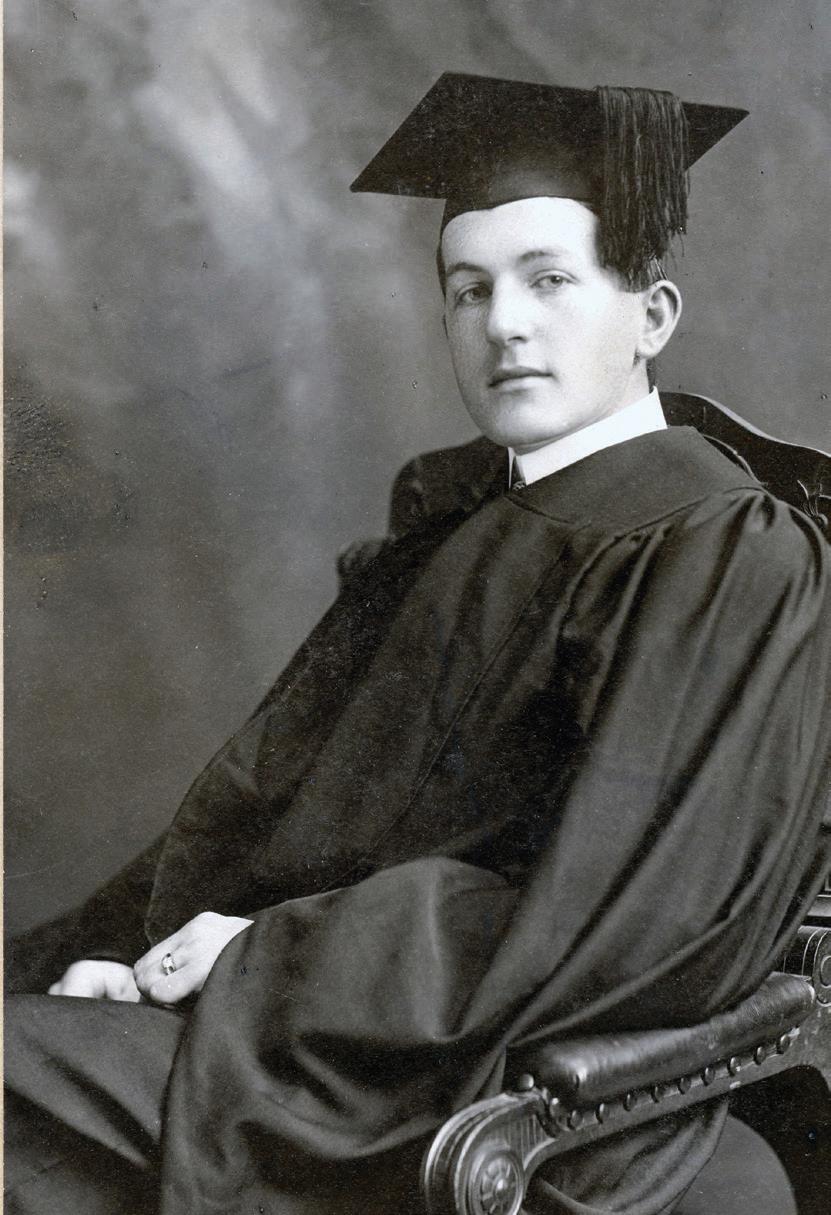
In an earlier case, a 1904 class ring was found with the remains of a body in the bed of the empty Mountain Lake in Giles County, Virginia. This was a widely popular resort with New Yorkers in the 1930s. Other personal effects located with the remains included shoes from a New York department store, a belt buckle and a silver cigarette case inscribed with initials matching the class ring. Again, the “MC” monogramed on the class ring coupled with the additional evidence led to the conclusion of a mysterious cold case.
It is clear that the Manhattan College class ring has lost much of its popularity with more recent graduates. Millennials and Zoomers associate the traditional class ring with their parents’ and grandparents’ generations or even from iconic movie scenes. Even though interest in the class ring continues to decline, each spring, a distinct number of Jaspers proudly place their orders. Thankfully, the beauty, romantic symbolism and nostalgia evoked by the class ring live on.
FROM THE COLLEGE’S
MANHATTAN.EDU N 35
ARCHIVES
ALUMNOTES

1954
Richard Cox and his wife, Nancy, of Cass Township, Pennsylvania, celebrated 60 years of marriage on Sept. 29, 2022. After graduating, Cox served in the U.S. Army at Aberdeen Proving Ground, Maryland, from 1955-1957. He was employed as an electrical engineer at Frankford Arsenal, Philadelphia, and then at the Naval Air Development Center in Warminster, Pennsylvania.
1957
John Murray has been married to his wife, Helen, for 62 years. Together, they have four children, 13 grandchildren and 14 greatgrandchildren. He retired as a school administrator from Massena Central School District in New York.
1961
Robert Cantwell and his wife, Claire, celebrated 65 years of marriage on June 9, 2022. Together they have five children and five grandchildren, who reside with them in South Carolina.
Salvatore Monte was inducted into the Plastics Hall of Fame on May 2, 2022 — one of only three people chosen globally each year. He is currently the president of Kenrich Petrochemicals Inc. His work is in the sustainability space, providing a new way to advance mechanical recycling.
1963
Thomas Brynes now has two grandchildren, James Vernice ’23 and Thomas Brynes ’24, attending Manhattan College in the School of Engineering. His son, also named Thomas, graduated in 1988.
Michael D’Amico lives in upstate New York and coaches track and field. He enjoys relaxing and spending his winters in Cabo San Lucas, Mexico.
1964
Louis Fiore has been honored for his lifetime contribution to The Monitoring Association (TMA), an internationally recognized nonprofit trade association that represents professional monitoring companies, security system integrators, and providers of products and services to the industry. TMA announced the establishment of the Louis T. Fiore Electronic Communications Scholarship to honor Fiore’s enduring contributions to the alarm industry and the Alarm Industry Communications Committee (AICC) and is intended to promote careers in electronic
Milo Riverso ’81 Heads the National Academy of Construction
MILO RIVERSO ’81, P.E., RETIRED CEO AND PRESIDENT OF STV GROUP INC and a current Manhattan College trustee, began a two-year term as chairman of the National Academy of Construction (NAC) in October.
“I was truly honored and humbled but also very excited by the opportunity,” Riverso says.
Joining the academy in 2014, he has been actively involved during the past eight years, including serving on the Membership Committee and chairing the Annual Meeting Planning Committee in 2015. Having served as the first vice chair since 2020, he now leads the academy and its executive committee.
In his new role, Riverso is most looking forward to furthering the mission and goals of the NAC, an organization of industry leaders who have made outstanding, lifelong contributions to the design, construction and engineering industries.
“The academy’s mission and vision is to honor our industry’s best and to serve the nation,” he says. “I would like to broaden the awareness that the academy exists and the large body of knowledge and expertise that exists within it are available to the government and the people of the United States as required to serve the nation.”
Elected to the academy for his “commitment to maintaining high standards throughout the industry and for avid mentorship to young people,” Riverso brings considerable executive and industry experience to the organization.
Retiring in 2020 from STV, a professional services company specializing in architecture, engineering, construction management and planning, along with building and facilities services, transportation, energy, and infrastructure market sectors, Riverso’s responsibilities included oversight of the firm’s daily activities and overall management of its corporate, technical, financial and administrative activities.
He previously served as president and CEO of the New York City School Construction Authority. Riverso has been active in leadership roles in several industry associations, chairing both the New York chapter of the ACE Mentor Program, the Construction Management Association of America, and the New York Building Congress. An active alumnus and generous donor to the College, he is also a member of the American Society of Civil Engineers and the National Society of Professional Engineers, and is a fellow of the Construction Management Association of America.
Riverso has been widely recognized for his leadership and service, including being named the recipient of the College’s De La Salle Medal and the New York Building Congress’ George A. Fox Public Service Award. He holds a bachelor’s degree in civil engineering from Manhattan College and master’s and doctorate degrees from Purdue University.

ALUMNI
36 N winter 202 3
communications. Fiore has served the alarm industry in many capacities and has been chair of the AICC for 30 years. Gerald Reidy has been selected to be the grand marshal of the greater Bridgeport, Connecticut, Saint Patrick’s Day Celebration in 2023.
1965
Edward Miller writes that his grandson, Jack Miller, will join the class of 2027 and play on the lacrosse team. He will continue the tradition of family members attending Manhattan College.
1968
Robert Cronin is happily retired in Wilmington, North Carolina, near his daughters and grandchildren. He and his wife celebrated their 50th wedding anniversary in August 2022.
1970
George Binninger received a bronze medal in the discus event and a silver medal in the high jump at this year’s California Senior Games. He continues his work on the board of American Lithium, which is developing two of the largest lithium resources in the world. He also works as an extra for movies and TV shows in the Los Angeles area, where he resides.
Eugene Ciccone is an infectious disease specialist in Connecticut. He specializes in infections that are difficult to diagnose or unresponsive to treatments, such as HIV or airborne infections from a foreign country. Richard Colarco is a professor of mathematics and space mission design.
Rocco Marotta is a board-certified psychiatrist and a director of a neuropsychiatric program in Connecticut.
Albert Natoli is a utility rates and corporate attorney. He represents and advises developers, privately owned utilities, municipalities, corporations and individual customers.
Raymond Valenti has had a rewarding career in teaching mathematics and business. Prior to teaching, he held tax and budget jobs in private and public organizations.
1972
Bill Drexler retired after being an educator for 40-plus years. He now resides in Gulfport, Florida.
1973
Todd Kristian is a retired teacher and has lived in Hilton Head, South Carolina, for 23 years. Kristian is the general manager of the planned community Hilton Head Plantation. He has an extensive background in public service, including past chairman of the town planning commission, a past chair and present member of the town zoning board of appeals, and works on the town’s comprehensive plan.
1974
Kevin Fitzpatrick, after teaching high school and college mathematics since 1975, finally celebrated his retirement in June 2021. He and his wife, Sue, uprooted to Bluffton, South Carolina. He now spends his time happily relaxing on the beach, surrounded by his family.
1975
John Reilly has been honored by Enterprise Community Partners, a national nonprofit that makes good homes possible for millions of families, as an impactful leader in affordable housing development for the past 40 years. Reilly and his neighbors founded the FordhamBedford Housing Corporation to assist tenant leaders in their battle to save their homes from deterioration and abandonment. He served as executive director of the organization from its founding until his retirement in 2022. Reilly’s work at Fordham-Bedford Housing Corporation included the opening of Concourse House, a shelter for homeless women and children, and the founding of FordhamBedford Community Services, a subsidiary providing services to hundreds of families and their children.
1977
William Bryk was appointed as administrative assistant to the Land Use Boards of the Town of Antrim, New Hampshire.
He will be helping the board members with governing, zoning and land use questions.
1978
Tom Pedulla works as a sportswriter and was recently awarded the 2022 Walter Haight Award for excellence in turf writing. Throughout his career as a reporter, Pedulla has covered six Olympic Games, every Super Bowl from 1995 to 2012, and every World Series from 1985 to 1995. Since 1997, he has covered every significant horse racing event. He is committed to writing articles for the nation’s top newspapers that make sports, particularly horse racing, interesting for everyone.
1979
Kevin Bolger retired after 36 years as a regional quality assurance manager with the U.S. Environmental Protection Agency in Chicago.
1980
Normand Long served four years in the Air Force as a design engineer in facilities management at Andrews Air Force Base in Maryland. After four years of active duty and achieving the rank of captain, Long received an honorable discharge and went to work for the Washington, D.C., Trane franchise as a sales engineer in the commercial HVAC industry. Long joined Havtech (the largest commercial HVAC representative organization in the D.C. area, and one of the largest in the United States) in 1993, became a partner in 1997, and a majority owner in 2008. He has been instrumental in its management and growth during the past 29 years and is currently chairman. He resides in Naples, Florida, with his wife.
George Wall has been the president of global supply and trading at Chevron Corporation, and is retiring from the company after 41 years of dedicated service. Wall began his career with Texaco in 1981, and since then, has held numerous leadership roles in the industry of increasing responsibility, including vice president of U.S. East and Latin America; general manager of Americas Marketing
MANHATTAN.EDU N 37
Sales and Services in San Ramon, California; vice president of global logistics in San Ramon, California; vice president of the supply and trading asphalt business unit in New York; manager of Europe’s commercial fuels business, and the general manager of retail in Belgium, Luxembourg and the Netherlands. He is currently a member of the American Petroleum Institute’s Midstream Committee and is on the board of the Chevron Political Action Committee.
1981

Peter Cordovano writes that his daughter, Theresa Loucanides, recently celebrated her marriage to Nicholas at the Smithville Inn in Absecon, New Jersey.
Julienne Ryan was named a Power Woman of Queens 2022 by Schneps Media, which honors impactful women who make the borough such a great location to live, work and conduct business. Ryan earned this title in honor of the publication of her book, The Learned-it-in-Queens Communications Playbook: Winning Against Digital Distraction (J. Ryan Partners, 2020). Currently, she is speaker, writer, trainer and coach at her publishing firm, J. Ryan Partners.
1982
Robert L’Insalata is the engineering practice lead for AKF Group’s critical space division. AKF Group is a full-service consulting engineering firm serving public and private sector clients. L’Insalata is currently working on expanding his energy and sustainability expertise into the critical space market.
Owen O’Connor has been recognized by Continental Who’s Who as a Top Pinnacle Achiever for developing numerous drugs for the treatment of blood cancers and his remarkable work for more than 25 years in both academic medicine and the private sector. He is known for his expertise in drug discovery and development, and in diagnosing and treating all forms of lymphoma. He also developed several first-in-class drugs to treat blood cancer, including one he co-invented for T-cell lymphoma that has been approved in more than 35 countries worldwide. He has published more than 250 articles in peerreviewed journals, books and reviews on managing lymphoma and drug discovery.
Michael Sweeton was named Citizen of the Year of Warwick, New York. He was acknowledged for his accomplishments as a 60-year Warwick resident, businessman and town supervisor.
1983
William Bender works for Leidos, an engineering company that provides technical services. Before joining Leidos, he was the chief information officer in the Office of the Secretary of the Air Force. Additionally, Bender served as the senior authority for IT investment strategy and oversaw the networks and network-centric policies, communications, information resources management and information assurance for the agency. Previously, he was deputy chief for the Office of Security Cooperation-Iraq, an organization that performs security cooperation and assistance activities in support of U.S. diplomatic relations with the Iraqi government.
Jim Malone retired from the New York City Department of Education as a basic skills teacher and administrative dean after 26 years. In the spring, Malone started his new job and career as a sales associate selling marine and recreational supplies. He has enjoyed sailing in Maine for 22 years. Anthony McElroy is a partner at Resolution Real Estate Partners, a fully integrated, full-service real estate firm in New York. He concentrates on the company’s organic growth, potential acquisitions, and maintaining the best services possible while broadening its offerings.
1984
Maureen Regan was named as a 2023 inductee to the Medical Advertising Hall of Fame, which honors retirees who have made significant contributions to the medical advertising profession. After working as a registered nurse, Regan entered the business as a pharmaceutical salesperson. She became the president at Lally, McFarland & Pantello (LMP), a health-care agency, and ultimately became the first woman to head up a large healthcare agency. During this time, she established the Women’s Healthcare Leadership Forum. Following her LMP tenure, Regan co-founded Regan Campbell Ward, a full-service advertising and
communications agency devoted exclusively to the marketing and promotion of pharmaceutical, medical and healthcare products and services.
1987
John Deerkoski joined Thornton Tomasetti as senior principal and transportation practice co-leader. He will be partnering with Sam Summerville ’80, who is also a senior principal and transportation practice co-leader, on the strategic growth and overall management of the transportation and infrastructure groups.
Nikolaos Papanikolaou has been an associate professor of biological chemistry at the Aristotle University of Thessaloniki (Greece) School of Medicine since 2009. Papanikolaou spent a year at the department of biological chemistry at the Johns Hopkins University School of Medicine as a Hopkins-Libra fellow. He also worked at the Ludwig Institute for Cancer Research branch of Memorial Sloan Kettering Cancer Center and at Columbia University College of Physicians and Surgeons. He earned his M.S. and Ph.D. in biochemistry and molecular biology from New York Medical College.
Peter Webner has joined SpectronRx, a leading radiopharmaceutical contract development and manufacturing organization, as chief operating officer. Webner brings more than 35 years of nuclear medicine and radiopharmaceutical industry experience to SpectronRx, along with a track record of building and leading industry-focused companies through periods of tremendous growth and profitability. Prior to joining SpectronRx, Webner served as general manager of Breast Oncology U.S. and global executive adviser at GE Healthcare.
1988
Brian Fedigan accepted a new opportunity with KPMG in Lake Nona, Florida, as managing director of Lakehouse, a state-of-the-art learning and innovation center.
Kathleen Naasz has been hired as vice president of strategic partnerships at New Jersey Institute of Technology’s New Jersey Innovation Institute (NJII). She will focus on analyzing current and future market opportunities, developing an effective partnership strategy, and cultivating strategic relationships that
ALUMNI 38 N winter 202 3
deliver on NJII’s mission. She has launched five businesses, led teams in more than 14 countries, and speaks three languages. Linda Parisi and Frank Parisi are celebrating their 30th wedding anniversary this year. Linda has been a physician assistant for 32 years, and Frank has been an ophthalmologist for 30 years.
1989
MaryAnn McCarra-Fitzpatrick contributed an audio recording of a poem written in response to John Wesley’s painting Guinness, 1989 to How We Live, Part II, a joint project of Hudson Valley MOCA and Studio Theater in Exile. Two of her mixed media collages were included in the New in 2022 group exhibit at the Field Gallery in Peekskill, New York, sponsored by the Peekskill Arts Alliance.
1991
Eric Borin was named president of Medication Delivery Solutions (MDS), the largest revenue-generating business unit at BD (Becton, Dickinson and Company). The multinational medical technology business produces and markets consumables, instrument systems and medical devices. Borin is responsible for driving global strategic, operational and commercial performance of the MDS business.
John Dinelli is the nuclear chief operating officer and has been serving as vice president of nuclear independent oversight at Entergy Nuclear, a business unit of Energy Corporation that owns and operates nuclear power plants across the nation. Dinelli has overall responsibility for the nuclear plants Arkansas Nuclear One in Arkansas, the Grand Gulf site in Mississippi, the River Bend Station in Louisiana, and the Waterford 3 station in Louisiana. Previously, he has held several senior leadership assignments, including site vice president at the Arkansas Nuclear One and Waterford 3 stations. Dinelli has more than 30 years of experience in the nuclear industry.
Peter Pappas, a licensed professional engineer, is vice president and business unit leader at STV Inc. He is responsible for the direction, growth and operation of STV’s program and construction management services within transportation throughout the New York metropolitan area. With more
JASPER BOOKSHELF
Richard Curtin ’61 published the 10th book in his Manny Rivera Mystery Series, Cast a Cold Eye (Monticello Press, 2021). It follows the story of a young man pursuing his dream of authoring an important work of history. The young man sets out to uncover and record the historical past of the Whitmire Ranch since its founding in 1890. However, four months into his research, he is found dead in the backcountry, and Deputy Sheriff Manny Rivera is assigned to solve his case. Curtin is a retired executive vice president of Southwest Research Institute.

Henry Petroski ’63 recently published FORCE: What It Means to Push and Pull, Slip and Grip, Start and Stop (Yale University Press, 2022). The remarkable forces at work when people interact with the world on a daily basis are explored in this book. Petroski questions those forces such as when we carry out everyday activities like using a pencil, going to the supermarket, wearing a mask, or hugging one another. The importance of force in forming civilizations and cultures is also discussed. He underlines that we become more conscious of the world and our place in it when we learn to perceive force. Petroski is a prominent professor at Duke University and the author of 19 prior nonfiction trade publications.

Peter Quinn ’69 released his sixth book, Cross Bronx: A Writing Life (Fordham University Press, 2022), which chronicles his 1950s childhood in the Bronx, New York, his time as a political and corporate speechwriter, and his eventual emergence as a novelist. In the prologue, Quinn notes that he “never planned to write a memoir” but “the involuntary idleness brought out by the pandemic” gave him the time to “ruminate” and to write. The story follows his evolution from a childhood in a now-vanished Bronx, to his exploits in the halls of Albany, New York, and swish corporate offices, to then walking away from it all. Cross Bronx is full of witty, captivating stories about Quinn’s personal experiences. While his book is an account of his upbringing and career, it is also a story about the evolution of a writer.

than 30 years of experience, Pappas’ career includes some of the region’s most iconic projects, such as the Grand Central Terminal Train Shed. He has also served agencies throughout New York, including Metro-North Railroad, Long Island Rail Road and New York City Transit.
Sean Powers was appointed senior vice president and commercial relationship manager at Gulfside Bank in Sarasota, Florida. Previously, he was a senior vice president at Sabal Palm Bank for five years.
1992
Michael Ferrarese has been selected to serve on the board of directors for the District Attorneys Association of the State of New York. In addition, he has been selected to serve on the board of directors for the National District Attorneys Association. Donna Reimers is an associate technical
fellow at Boeing in Seattle, Washington. She enjoys her role as a product development expert, mentor and technical council co-chair in commercial and military aircraft design. William Tobin has retired from his position as director of radiology at the University of Texas in Tyler, Texas.
Christian Wallace works at Robert Martin Company, a fully integrated real estate company. Since 2009, he has worked as a controller and has enhanced the company’s accounting capabilities, enabling high-quality reporting for the companies’ entities and partnerships. In addition to his accounting role, he oversees the company’s tax returns, as well as the partners’ family office.
1993
Maureen Evers-Willox is a managing partner of the Long Island office of the accounting firm KPMG. She oversees
MANHATTAN.EDU N 39
audit, tax and advisory professionals and was recently featured in Long Island Business News
1994
Erika Duthiers has been appointed to the Canandaigua National Corporation (CNC) board of directors. Duthiers serves as the assistant vice president for compliance and ethics, and deputy general counsel at the Rochester Institute of Technology, New York. She led the university’s compliance with laws, regulations and internal policies, and assisted the general counsel with legal matters. Duthiers is involved in the Rochester community and has served in executive capacities on boards of many nonprofits and professional associations. She received recognition as one of the 2017 Top Women in Law from The Daily Record, as a finalist for the ATHENA Young Professional Award in 2015 by ATHENA International, as a Forty Under 40 honoree in 2011 by The Rochester, New York Business Journal, and was selected by the Democrat & Chronicle as one of Rochester’s Emerging African American Leaders in 2009.
Jose Minaya was appointed to the board of directors at Moody’s Corporation and will join its audit, governance and nominating, compensation and human resources committees. Since 2020, Minaya has served as CEO of Nuveen, one of the world’s largest asset managers. Prior to Nuveen, he led Teachers Insurance and Annuity Association of America’s (TIAA) global real assets division, setting strategy and developing investment capabilities across real estate, agriculture, timber, infrastructure, energy and alternative credit strategies. He also was recently elected to the College’s board of trustees. Richard Zapolski was named partner of civil engineering, site development, landscape architecture and planning at Cameron Engineering, a full-service consulting engineering and planning services firm in the New York metropolitan area. Zapolski has more than 32 years of experience and is a professional civil/site engineer and planner. He has been an associate partner with the firm for the past year, concentrating his practice in both the planning and construction aspects of civil engineering. Before joining Cameron Engineering, Zapolski served as town commissioner with the department of plan-
ning and development in Islip, New York. Currently, he supervises a team of civil and traffic engineers, planners, and landscape architects in the design of civil engineering and site development projects, as well as the construction administration and project management of those projects.
1995
Stephen Famularo, a marine engineer and certified commercial diver, joins Williams Sale Partnership (WSP), an engineering professional services firm, as the firm’s Maritime East leader. Famularo brings more than 25 years of international maritime leadership and experience in waterfront engineering, underwater inspections, marine structure rehabilitation, service life evaluation, asset management, coastal engineering and climate resiliency planning. As a vice president, he is responsible for strategic hires, business development, identifying and pursuing project opportunities, managing client relationships, tasks and staff for coastal and marine engineering projects, primarily across the Eastern U.S.
Christine Oates became the new chair of the board of directors of the Construction Management Association of America (CMAA) at its 2022 national conference in California. Oates has more than 25 years of experience in construction management, leading critical public and private sector buildings, infrastructure projects, and providing sales and business development services. She started with CMAA, a nonprofit professional association serving the construction management industry, about 20 years ago and volunteered in a variety of roles including newsletter, student scholarship and outreach, and support of the annual awards banquet. During this time, she became a Certified Construction Manager (CCM) and an instructor for the cost management module of the standards of practice course. She is excited for her new role as chair and looks forward to promoting CMAA and all of its benefits.
1996
Anthony Jamsek has been promoted to director of information systems at Syska Hennessy Group, an international engineering firm. In his new role, he will oversee all software platforms and lead
the project management oversight team, which assists with internal oversight and management of client projects. Jamsek, who is based in New York City, has worked at Syska for more than 25 years. He is an active member of Syska Innovations, a subsidiary that invests in seedstate companies, pilots their software and products, and promotes ideation and technology development.
1997
Susan Cherepon is the statewide director of the South Dakota Braille and Talking Book Library. She earned her master’s in library science from the University of Arizona in 2016. In October 2021, she married her husband at Boldt Castle in Alexandria Bay, New York.
1998
Lynn Martin was included among Crain’s New York Business Notable Diverse Leaders in Banking and Finance for 2022. She is the 68th president of the New York Stock Exchange and the second woman to lead the exchange in its 229-year history.
2000

Kazimierz Borawski joined North Brookfield Savings Bank as senior vice president, chief financial officer, and treasurer of the bank’s corporate headquarters in Brookfield, Massachusetts. He is responsible for the planning, setting and directing of the bank’s financial strategic direction.
Tanya Eastman has been hired as director of partners for Education & Business Inc., an affiliate of Manufacturers Association of Central New York (MACNY). Eastman comes to MACNY with extensive experience in the nonprofit and for-profit sectors in New York State. Previously, she served as the director of education and training at United Way of Northern New York. Eastman continues to serve as the foundation administrator for the Syracuse City School District (New York) educational foundation and as an adjunct instructor in the St. John Fisher University Ed.D. program in executive leadership. She has been actively involved in the community as a member of several professional and civic organizations, including the North Country Human Resource Association, Society of Human Resource Management, Central New York Association of Talent Development, and Hiscock Legal Aid Society.
ALUMNI 40 N winter 202 3
MARRIAGES
2013
Robert Fiore and Carly Dane Cerbone, 7/16/22
2014
Andrew Goreck and Sabrina Rocha ’15, 11/21/21
Christopher Kalousdian and Meghan Hayes, 8/5/22
2015
Meaghan Fenton and Lance Neuendorf ’16, 11/19/22
BIRTHS
2007
Suzanne Katz and Marco DeRose ’08 Son, Maxwell Ellis, 7/9/21
2010
Eileen (Veith) Leboff and Kevin Leboff Daughter, Frances
2012
Caitlin Sweetapple-Salogub and Michael Salogub ’13 Son, Patrick, 1/12/23
ADVANCED DEGREES
2012
Nick Miras earned his doctorate in government and politics from the University of Maryland, College Park, in the summer of 2021. Caitlin Sweetapple-Salogub earned her Doctor of Education in Educational Leadership for Diverse Learning Communities from Molloy University in 2022.
2015
Nelson da Luz graduated with his doctorate in civil engineering from the University of Massachusetts Amherst in May 2022.
2019
Jeanine Perrelli received her doctorate in physical therapy from New York University in the summer of 2022.
RikkiLynn Shields graduated from Dominican College with a Doctor of Physical Therapy in 2022.
Lisa Edwards holds Manhattan College’s women’s record in the 400-meter hurdles event. She coached at the Division I University of Texas and for the U.S. at the Pan-American Games in 2001 before coaching at Wagner College for a couple years. In 2005, she joined her mother, Sandra, as a track official at The Armory and myriad other local venues in New York. To this day, Edwards regularly trains — doing everything from cycling, to treadmill miles, to rail train runs — before or after the meets she officiates. She currently works as a teacher’s assistant in Westchester County, New York.
2004
Mark Blenner joined the University of Delaware’s Chemical and Biomolecular Engineering department as a tenured associate professor. In the past two years, he has won several awards, including the American Institute of Chemical Engineers Food, Pharmaceutical and Bioengineering Division Early Career Award (2022), Biochemical Engineering Journal Young Investigator Award (2022), and the American Chemical Society Biochemical Technology Division Young Investigator Award (2021). He is also advising a recent Manhattan College graduate as she pursues her Ph.D. Erin Brennan was promoted to Americas Region knowledge manager at Arup.
2005
Charlie Marino has been named partner of AKF’s Energy + Performance Group. He has dedicated the past decade to the development and growth of AKF’s Energy + Performance team, and focuses on strategies to reduce carbon emissions and improve energy efficiency.
2006
Alexandra Nigolian was mentioned in the Long Island Business News as one of the Most Powerful Women for her efforts in supporting the Nassau County Police Department Foundation. Founded in 2009, the foundation provides financial support to the Nassau County Police Department, helping them serve the Nassau community and provide an improved quality of life for the surrounding areas. Nigolian has been the executive director of the Nassau County Police Department Foundation since 2011 and is currently the chairwoman of the Police Foundation’s section of the In-
ternational Association of Chiefs of Police.
2008
Osama Abdelfatah is associate vice president and regional program controls director at AECOM Technology, a multinational engineering firm. Throughout his 22-year career, Abdelfatah has managed projects and program lifecycles of complex multidisciplinary initiatives. He previously served as the senior controls lead for the LaGuardia Airport redevelopment program and has also worked on the Second Avenue subway expansion, the new Mario Cuomo Bridge, and major programs in the Middle East, including Libya and Qatar.
Dexter Jules recently took a position as vice president of digital content and strategy at Edelman, a public relations and marketing consultancy firm.
Siobhán Keane-Revie received the 40 Under 40 Award from the Irish Echo. She works as a project specialist in Substation and Transmission Engineering at Orange and Rockland County Utilities, New York. Keane-Revie also serves as a vice president of the Con Edison Emerald Society and participates in charity events through the Rockland Gaelic Athletic Association and the Ancient Order of Hibernians. Christina King is an assistant professor at the University of California, Irvine. She recently won the National American Society of Biomechanical Engineering Education Teaching Award.
2009
Frank Caramanica was sworn in as lieutenant for the Amityville Police Department of New York on Sept. 20. He earned the rank of sergeant in 2018 and then became administrative sergeant in 2020. For his new role, Caramanica hopes to develop a closer working relationship with other members of the department to help it be the best it can be.
Michael Fitzpatrick was appointed chief privacy officer for the City of New York.
Amanda Genovese has returned as a partner to Troutman Pepper’s consumer financial services group. She plays a key role in defending complex litigation matters in courts throughout the United States.
Michael Lawler won New York’s 17th Congressional district election and looks forward to representing his constituencies. Previously, Lawler represented New York’s 97th district in the State Assembly. He also has served as Orangetown deputy town
MANHATTAN.EDU N 41
Alumna Honored for Making Workplace More Inclusive
ELVIMAR RIVAS ’19 (KNOWN AS ELVI) was named Con Edison’s 2022 ASPIRA Circle of Latino Achievers Honoree at the ASPIRA annual dinner last spring for her outstanding work promoting diversity, equity and inclusion. The organization, which was founded 61 years ago by Antonia Pantoja, an educator and social worker who received the Presidential Medal of Freedom in 1996, helps young people develop leadership skills and advocates for improving education in Latino communities.
In recognizing Rivas, ASPIRA wrote, “Elvi’s passion for advocating for marginalized groups to experience true inclusion in the workplace is extremely commendable and inspirational.”
Rivas was recognized for her work with Con Edison’s CapeABLE (Advocating, Belonging, Leading, Engaging) Employee Resource Group, a resource that supports the greater involvement, organization and inclusion of individuals with disabilities and those who support them within the workplace. She founded it in 2021, and currently, the group includes 45 subcommittee members and 165 general members.
“I am passionate about diversity and inclusion because seeing different perspectives makes us a stronger company,” she says. “We serve New York City, one of the most diverse places in the world, and we should reflect that in our workplace.”
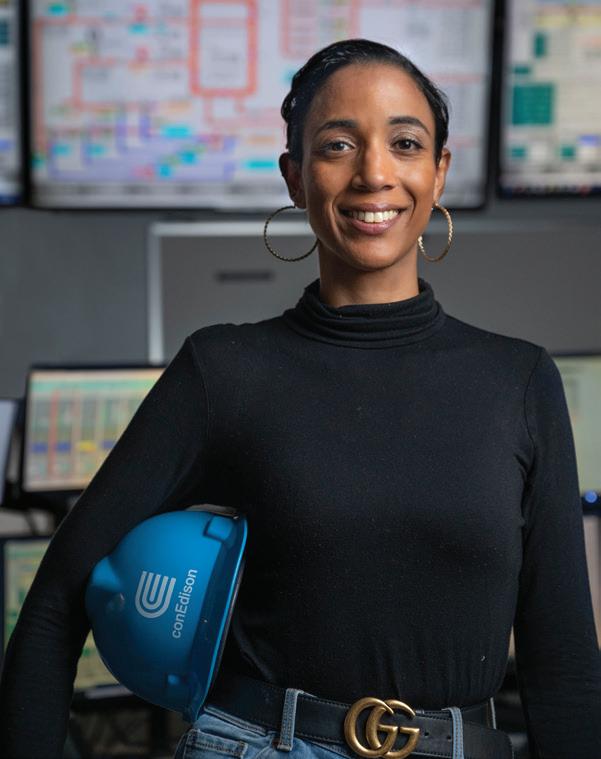
Rivas is heavily involved in diversity, equity and inclusion work across Con Edison. She is a board member of the LGBTQ+ Employee Resource Group and a committee member of the Hispanic Resource Group CLARO (Cultivating Leadership and Actively Realizing Opportunities). Employed at Con Edison since 2013, Rivas is a senior analyst in its Steam division within the Technology Applications and Cyber Security department.
“Getting an award was inspiring and made me feel like I needed to continue to do the work, learn and grow in order to continue to give back to my community and inspire others,” Rivas says. “It’s important to always help people along your career trajectory. Success to me is the ability to uplift and give back.”
Reflecting on who inspired her along the way, Rivas says that when she first began at Con Edison one of her mentors, Sylvia Meza, executive assistant to the president, told her about the graduate program in organizational leadership at Manhattan College and encouraged Rivas to look into it. Rivas, who earned her bachelor’s degree from Monroe College, thought it might be a good fit, considering her busy schedule.
“The program allowed me to be a full-time employee and mother of three while taking classes online,” Rivas says. “I enjoyed the topics, such as ethics and spirituality.”
Looking ahead, Rivas would like to “continue to push the needle forward toward a more inclusive world by continuing my work within the DEI space,” she says. “I hope to someday write a book and perhaps pursue a doctorate.”
supervisor, senior advisor to the Westchester county executive, and executive director of the New York Republican State Committee. In 2018, Lawler was recognized as a “rising star” by Campaigns & Elections. He lives in Rockland County, New York, with his wife and daughter.
2010
Eileen (Veith) Leboff and Kevin Leboff welcomed their third daughter, Frances, into their family. She joined big sisters Joanne and Dorothy.
2011
Andrew Gabriel has worked in federal, state and city legislative affairs to identify and mitigate the everyday challenges faced by New Yorkers. Currently, Gabriel
is the vice president of Intergovernmental Affairs for CAMBA, a Brooklyn-based nonprofit organization that provides social services to New Yorkers in need.
2012
Brianne Carroll studied at Hunter College and graduated with a doctorate of physical therapy in 2015. Carroll currently works as a physical therapist at NYU Langone.
Nick Miras started a new position as an associate manager for strategy and consulting at Accenture Federal Services and is also a faculty member at George Mason University, where he teaches a course on the U.S. Congress. He earned his doctorate in government and politics from the University of Maryland, College Park, in the summer of 2021.
Susan Fiorentino was given one of Staten
Island Economic Development Corporation’s 20 Under 40 leadership awards.
Maria Jangsten obtained her M.S. in sustainable energy systems in 2016 and defended her Ph.D. in district cooling from Chalmers University of Technology in Gothenburg, Sweden, in October. She says that pursuing her Ph.D. was initiated during her studies at Manhattan College and vividly remembers one of her professors encouraging her and her classmates to “find their niche.” She has also worked at an HVAC company located in New York City.
2013
Robert Fiore got married this past summer. He earned his Ed.D. from St. John’s University in 2020.

ALUMNI 42 N winter 202 3
Nicole Vacca recently co-wrote a devotional book entitled The Portion (Chosen People Ministries, 2022), which introduces the Torah and its connections to the New Testament. It explores how the Torah lays the foundation for the rest of Scripture and serves as a guide for many lives today. Vacca currently works as a social media specialist at Chosen People Ministries, where she manages social media coverage for live events, manages content and planning across all social accounts and co-produces and writes scripts.
2014
Gillian Carzzarella was mentioned in the San Diego Business Journal magazine for her accomplishments as a senior engineer at NOVA Services. She has 20 years of experience in the industry and is a licensed professional engineer in California. She oversees geotechnical construction and was part of the Hurricane Sandy Disaster Relief effort in 2012, performing home and boardwalk inspections.
Christopher Kalousdian and Meghan Hayes were married on Aug. 5, 2022. Meghan ran track for the College, and Christopher was on the baseball team.
2015
Meaghan Fenton and Lance Neuendorf ’16 celebrated their marriage on Nov. 19, 2022 at the Art Factory Studios in New Jersey surrounded by family, friends and more than 30 fellow Jaspers.
2016
Patrick Sheeran and his brother Luke Sheeran ’18 opened a bar in Sleepy Hollow, New York, called Beekman Ale House. They were able to bring their family passion to Westchester County and create an environment that brings people together with good food, drinks and company.
Kevin Sheerin currently works as a project manager for Northeast Structural Steel Inc. in Pelham Manor, New York. One of his accomplishments includes building grandstands at one of the smaller practice stadiums in the complex where the United States Open is played in Queens.
2017
Samantha Bowers is a successful vocalist in a jazz-rock-funk band, Sammy Rae and the Friends. The band has more than 742,000
monthly listeners on Spotify, and their most popular song, Kick It to Me, has been played more than 17 million times. They’ve sold out shows in New York City, Boston, Seattle, Philadelphia and more.
Emily Doherty is a member of the instructional learning team at P.S. 175 and has succeeded in leading the City Island school’s instructional improvement. This year, she received the Big Apple teacher award in New York City.
Kayla Grimme is currently transitioning into a new career as an account coordinator for Spectrum Marketing, a nationally recognized direct marketing company. Previously, she was a closing executive at Hudkins Law & Title real estate.
Kyleigh Panetta joined Spectrum News 1 in Raleigh, North Carolina, in February 2021. Most recently, Panetta worked as a producer and reporter for four years at an ABC affiliate in Salisbury, Maryland. When she is not working on her next story, Panetta enjoys cooking, spending time outside, traveling and reading. She is excited to call Raleigh her new home and explore everything the area has to offer.
2019
RikkiLynn Shields was accepted into Dominican College’s Doctor of Physical Therapy program during her senior year at Manhattan College and began her studies two weeks after graduating in May 2019. At Dominican, she received a leadership award and a clinical education award. Shields expresses her love for Manhattan College and all of the opportunities it brought her. She is grateful that she followed the support, encouragement and guidance she received from her professors.
2020
Miguel Díaz-López is a third-year doctoral student in the department of Mechanical Engineering at Johns Hopkins University. He has been awarded two national research fellowships: the National Defense Science and Engineering Graduate Fellowship and a NASA Space Technology Graduate Research Opportunity (see story on page 16).
2021
Alex Schwartz was mentioned in the Movers and Shakers section of the Long Island Business News for his achievement in joining D&B Engineers and Architects water supply division as an engineer. Nicholas Reda serves as an assistant project manager for an HVAC installation firm. Albert Rossi is currently working as a project engineer at Pawling Engineered Products in New York. He is also a volunteer firefighter in Patterson, New York. Courtney Warley has signed with Eurocup Women’s Sport Lisboa Benfica in Lisbon, Portugal. Warley was Manhattan’s NCAA Woman of the Year nominee, as well as a finalist for the Senior CLASS Award. After five years at Manhattan College, including earning a master’s in business management, Warley wanted to explore a new country, all while enjoying the game she loves the most — basketball.
2022
Alex Messina of Dix Hills, New York, has been hired as a marketing coordinator at Tenenbaum Law in Melville, New York.
Pelle Nogueira is a former Manhattan College runner and an all-Metro Atlantic Athletic Conference cross country selection in 2020-21. He was the first runner in the men’s division to cross the finish line in the New York Road Runners 2022 Staten Island Half Marathon in one hour, six minutes and 41 seconds.
CORRECTION
We incorrectly reported that Thomas Foley ’92 received encouragement from professor Jeanette Brown as a student in his profile in the spring 2022 issue. He was referring to William Brown ’54, the late professor emeritus of civil engineering. We apologize for the error.
MANHATTAN.EDU N 43
Lillian Cerza Borrone ’77 Recognized with Lifetime Achievement Award in Transportation
FOLLOWING A STORIED CAREER THROUGHOUT THE FIELD OF TRANSPORTATION that spans nearly five decades, Lillian Cerza Borrone ’77 (M.S.) has been chosen as the 2023 recipient of the Frank Turner Medal for Lifetime Achievement in Transportation.
The medal is awarded by the Transportation Research Board (TRB) every other year to those with a distinguished career within the field and an undoubtedly strong contribution to transportation policy, administration or research — all of which Borrone’s many achievements have encompassed.
“It was a complete surprise,” says Borrone of the phone call notifying her of the decision to name her the recipient. “I was really humbled, I didn’t expect it at all. Neil [Peterson, then-executive director of the TRB] told me as they were considering candidates, I stood out.”
Following her 1968 graduation from American University with a Bachelor of Arts degree in political science, Borrone’s career began at the Council of Governments in Washington, D.C., where she worked as a transportation technician before moving to the United States Department of Transportation (USDOT), joining the Urban Mass Transportation Administration (UMTA, or what is now known as the Federal Transit Administration) as a representative.
Throughout the following years, she found herself in numerous roles at the Port Authority of New York, New Jersey’s Rail Department (PANYNJ) and UMTA, as she continued to rise through the ranks. She retired in 2000 as assistant executive director of the Port Authority.
As if these accomplishments weren’t enough, she was then appointed by former President George W. Bush to serve on the United States Commission on Ocean Policy in 2001. But in the aftermath of the September 11, 2001 terrorist attacks, she answered the call to become a cabinet member at the New Jersey Office of Recovery and Victim Assistance under then-Governor of New Jersey Donald DiFrancesco, which entailed providing official information, counseling and government assistance to relatives of those killed, injured or missing in the attacks.
“I was very fortunate throughout my career to always have men and women who encouraged me, who gave me advice, who let me make mistakes,” Borrone says. “I think I got the opportunities because they saw I was dedicated and committed to doing the best I could.”
As she looks back on the many roles she had ahead of receiving the TRB’s recognition, she thinks fondly of her time with the Port Authority. “I really was very fortunate to work for the Port Authority because it was and is a great organization to be a part of,” she says. “It gave me the opportunity to move between businesses, and to be a bit entrepreneurial, as well as try to achieve change, which is fun.”
Her journey to Manhattan College might seem unconventional to today’s Jaspers, but Borrone began her graduate studies after
helping the College receive grant money for the master’s program in civil engineering back in 1975.
During her time overseeing federal aid at the PANYNJ, she was approached by rail department deputy John Hoban ’51, who had taken note that Borrone was working on grants for university programs focusing on transportation. “He said, ‘Manhattan is interested in applying for it. Would you work with them on writing the application?’ So I said sure, why not?” Borrone says.
After the College received the funds from the UMTA, Hoban urged Borrone to apply. Although hesitant at first, she eventually became a Jasper in the inaugural program, which she used to her benefit throughout her career.

“Just having the degree gave me a level of credibility that I think was important in my career,” Borrone says. “I hold Manhattan in high regard. In fact, I try to make sure I go to my Jersey Shore alumni gathering that’s held every summer.”
She keeps in touch with a few of her classmates, alumni and even professors from the program, most of whom were adjunct faculty working in the field when they weren’t teaching.
“Some of them really became very important mentors and people within our networks that we could call on over the years, and I did,” Borrone says.
She has also served as a mentor throughout her career. Borrone co-chaired the Task Force on Involvement of Women and Minorities within the TRB, became the national president for the federal government’s Women’s Transportation Seminar, and helped create a women’s equity organization in the Port Authority.

In the TRB’s announcement of Borrone’s selection for the Frank Turner Medal, she is praised as a trailblazer.
“I don’t often think of myself that way, but I guess, if I stepped back and looked, and said ‘you know what? You went and did things other people hadn’t yet done.’ So I guess I am a trailblazer,” she says with a laugh.
ALUMNI 44 N winter 202 3
It’s a New Space Age, and This Jasper is All In
JAMIE FOLEY ’21 IS PRESSED FOR TIME
At the moment, he’s multitasking conducting a phone interview and driving his car near Austin, Texas. Foley’s limited downtime stands to reason once you know what he does for a living: He’s a fluid propulsion system engineer for Firefly Aerospace, a space transportation company that develops launch vehicles and in-space vehicles and services. In fact, when he shares a few facts about his current project, it’s a wonder he has time to chat at all.
But first, some background. Born in Calgary, Canada, Foley moved often during his formative years. Joining the Army right after high school, he served for eight years as a combat medic specialist, or 68 Whiskey, mainly on active duty. For two years, Foley was deployed overseas to several countries including Iraq, Djibouti and Kenya. On leaving the Army, he joined friends in New York City.

“I was not planning to go to college ever. I was planning to be a lifer in the military,” he says, reflecting on his decision to pursue a degree in mechanical engineering. “The school that offered the degree I was interested in that was nearby was Manhattan.” Once he heard about the resources the College offers for military veterans (see page 5 to read more), Foley was sold. “It sounded almost too good to be true.”
Returning to school after military service was “a shock in academics and a culture shock as well,” he says. Fortunately, he became involved in the Student Veterans Organization (SVO), eventually serving as the vice president and then president.
“[The SVO] truly is a gem that sets Manhattan apart from many other schools in terms of student veteran success,” he observes. “The faculty involvement from day one made what otherwise would have been an astronomical transition to make, so much easier.”
He also encountered his “ace in the hole” — Bahman Litkouhi, professor of mechanical engineering. Foley recalls: “I remember
the first lecture in thermodynamics I had with Dr. Litkouhi, and he asked, ‘What kind of engineer do you want to be?’ And everyone’s answering that they want to be a space engineer, or this or that engineer. Of course, [Litkouhi] was looking for, ‘I want to be a good engineer.’ That set the tone of my interactions with professors in the mechanical engineering department. They truly care about what they’re teaching.”
After graduating, Foley was offered several engineering positions, but the prospect of working as a design engineer at Firefly Aerospace held the most allure. “There is an appeal to new space companies in general,” he says. “They’re notoriously ambitious and hardworking.”
At first, Foley worked on Firefly’s first-stage engine, Reaver, four of which powered the company’s Alpha rocket to its first successful test flight in October 2022. He then moved to his current role as a fluid propulsion system engineer with the Blue Ghost Lunar Lander team, which was recently awarded nearly $100
million in funding from NASA to deliver science investigations and technology demonstrations to the moon in 2023. Such projects will help prepare for human missions to the lunar surface — the goal of NASA’s Artemis program.
“Blue Ghosts will ride on a Falcon 9, a SpaceX rocket, which will put it into a lunar insertion orbit,” Foley explains. “Then we’ll do the final maneuvers — the entire mission is over a period of about two months — and do the landing propulsively.”
Foley has a hand in the sourcing, manufacturing and integration of components, and will “hands-on” every fluid and propulsion system component on the lander throughout its lifecycle prior to flight. Currently, he works daily in a cleanroom to integrate components, build weldments, and ensure everything is built as designed and prepared to fill its role on the lunar lander.
“So much of this technology and our propellants in particular are very niche,” he continues. “They’re incredibly hard to work with, notoriously reactive, and the stakes are high, so the pressure is also significant.”
That said, Foley embraces the challenges of playing a part in the entrepreneurial space age.
“I don’t think anywhere will push me quite as hard as Firefly Aerospace has,” he says. “It also served as a crucible of sorts to force me to learn a lot really quickly and already put me in a role of responsibility that I would never have expected in my life.”
Spoken like, as Litkouhi would say, a good engineer.
MANHATTAN.EDU N 45
Navigating it Together: Longtime Friends Become Colleagues in Mental Health Careers
is extremely diverse,” she explains. “A lot of [my work] was traumafocused crisis management. I did a lot of connecting to outside agencies, referrals, some counseling. The main issues involved were domestic violence, homelessness, child abuse, medical neglect, and children with more medical complex needs.”
Meanwhile, Tassiello worked as an art therapist in a variety of healthcare settings, most recently in the department of hematology and oncology at Komansky Children’s Hospital, part of New YorkPresbyterian/Weill Cornell in New York City. There, she provided art therapy to children, teenagers and young adults who were diagnosed with cancer and blood disorders.

JAQUELINE TASSIELLO ’10 AND MEGAN LEE ’10 have been close friends ever since their freshman year at the Academy of the Holy Angels in Demarest, New Jersey. Their bond remained strong during all that followed: four years at Manhattan College, where they both pursued undergraduate degrees in psychology and discovered similar aspirations to help others, and in graduate school and careers in the field of mental health — Tassiello as an art therapist, and Lee as a social worker. When they eventually made the decision to start a private practice, they took that step together.
Both point to experiences as Manhattan students that helped shape their careers. For Lee, an Introduction to Social Work course that she took as an elective her senior year was helpful at a time when she was still, as she says, “trying to figure out where I fit in” in terms of a psychology career. The course highlighted the options available to her as a social worker. “You could apply the degree to work in a school, in a hospital, in an agency,” she says.
Tassiello recalls participating in a community-engaged learning religion course through which she regularly visited a women and children’s shelter and worked with the children using art. “Along with my art classes, that class was very pivotal for me because I got handson experience, but it was also this intersection between social justice and community outreach,” she says. “I remember doing art with the children, and the way that they used it was so powerful because there was definitely something therapeutic happening.”
After Manhattan, Tassiello earned a Master of Professional Studies in art therapy from the School of Visual Arts in 2013, while Lee graduated from Fordham University with a Master of Social Work. From there, they joined the healthcare field. Lee spent seven years working on the maternal child health unit at Elmhurst Hospital in Queens, New York. She was assigned to inpatient pediatrics and the pediatric ICU, as well as other maternal child units, including labor and delivery and postpartum care.
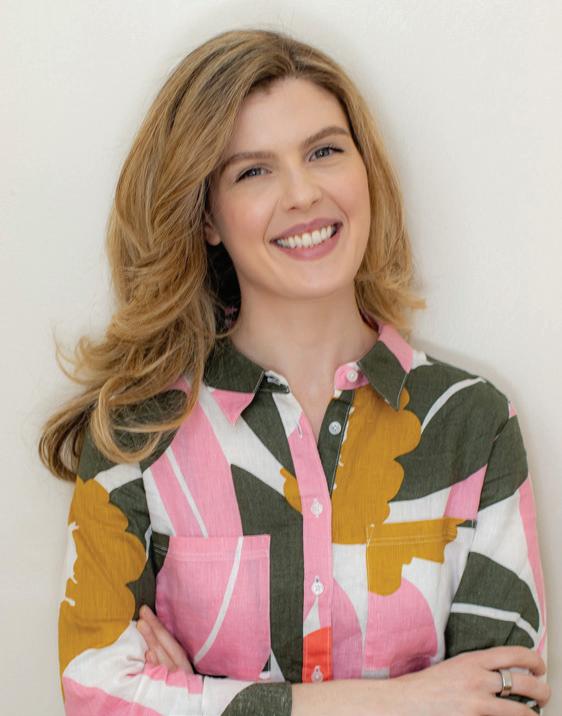
“Elmhurst Hospital is a public hospital, so the patient population

She describes art therapy, which integrates psychological theory, human experience and psychotherapy, as “a wonderful framework to approach people with, because therapy can be scary.” When presenting patients with art materials such as acrylics, oil paint, colored pencils, journals, play techniques, and other creative processes, she continues, “It feels safe for people. You’re engaging alternate modes of communication: kinesthetic, sensory, symbolic, perceptual.”
When the COVID-19 pandemic struck, Tassiello was reassigned to a team that provided psychological and emotional support to frontline health workers on COVID-19 units. Her team brought self-care essential needs carts to the units, which, she says, “provided a necessary break for a lot of people who were working double and triple shifts. And also a sense of connection in the midst of so much chaos, loss and death.”
In the midst of the pandemic’s early days, Lee became a parent. With a newborn at home and in need of a more flexible schedule, she was unable to return to Elmhurst Hospital. In 2021, the two friends decided to launch their own therapy practice. “We really encouraged and supported each other to take that step, and it was nice to have each other to lean on because we were both navigating it together and figuring it out,” Lee says.
While offering virtual therapy sessions, each therapist built up a clientele. After a year of running a practice together, the next step was for each to strike out on their own. Tassiello now operates Art Therapy Source, working with children and adults struggling with emotions like anxiety, grief and loss, while Lee founded Soulutions Therapy and works with women, children and families.
Lee relishes the opportunity to establish rapport and connection with patients, something that was more difficult in her hospital work. “It’s nice to see it through with the clients,” she notes. “To see how they build on their own strengths to create change that they want to see within themselves. I’m honored to be a part of that.”
Although no longer in practice together, the two friends continue to support each other by referring patients and discussing the challenges inherent in their chosen field.
“She’s my friend first and foremost,” Tassiello says of Lee. “But she’s also been a professional support, and I know that she has excellent training and sound ethics. I consider her to be one of the most important people in my life, as a friend and as a fellow therapist.”
ALUMNI 46 N winter 202 3
Patterson ’69 Tells Some of His Best Stories in Autobiography
“HOW DID A SHY, INTROSPECTIVE KID from a struggling upstate New York river town who didn’t have a lot of guidance or role models go on to become, at 38, CEO of the advertising agency J. Walter Thompson North America? How did this same person become the bestselling writer in the world?” asks James Patterson ’69 in James Patterson by James Patterson: The Stories of My Life
He posits this as the “big mystery plot” in the first chapter of his autobiography, released last summer. Yet as one reads his book, in what feels more like a series of interesting conversations with the prolific author, that mystery quickly unravels to reveal the answer. But we’ll get to that later.
Patterson began writing his autobiography during the COVID-19 lockdown, as he notes that he had more time than he’d had in a while.
“I just started writing down some stories,” he says. “I liked doing it. I liked the process. I liked remembering some things. What I wanted to do is a little of what I do in the novels, which is just great scene after great scene, after great scene.”
Patterson has loved storytelling ever since he was a child. He remembers spending time at his grandparents’ house, wandering through their acres of woods and telling himself stories.
“Ever since then, I’ve always told myself stories,” he explains. “I just have a big imagination. It’s a gift. I don’t know where it came from. Part of it maybe is from practicing, practicing, practicing, making up all these stories.”
He keeps a folder in his office, cleverly labeled, “ideas,” Patterson jokes. He just keeps adding to it as ideas come to mind — and they are constantly coming to mind.
“Sometimes it’ll just be a sentence or half of an idea,” he explains. “When I’m thinking about writing another book, I’ll just sit down and pull out the pages, looking for maybe three or four stories that I find interesting, that I think other people would find interesting.”
Patterson recounts in his autobiography that whenever journalists visit his office, they are surprised by the number of manuscripts lining the counters (he notes there are 30 or so, and probably a few screenplays, at any given time). And if one looks at his list of recently published books, or checks out their local bookseller’s shelves, there is a James Patterson book coming out practically every month — sometimes even two books. Since the new year (and at press time), there have been six: The House of Wolves, Walk the Blue Line, and 3 Days to Live, as well as two children’s books and another addition to his Maximum Ride young adult fantasy series.
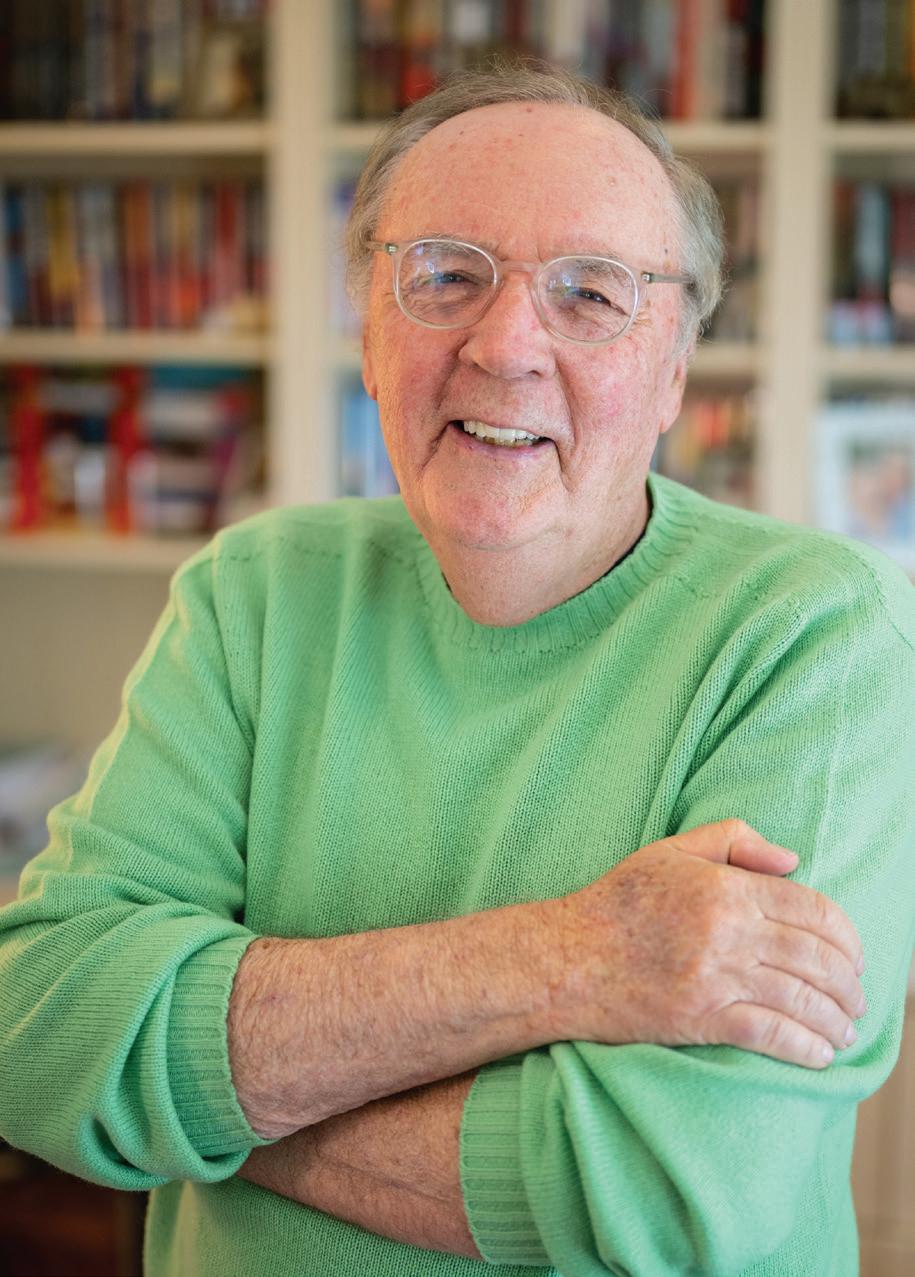
He doesn’t even seem stressed out about all these piles of simultaneous projects.
“I don’t even think about it. I don’t,” he explains. “A piece of it is I was in advertising. When I was running J. Walter Thompson North America, it was just project after project after project. I really learned how to juggle 20, 30, 40, 50, 60 accounts and keep up with it and know what was going on for all the accounts.”
On top of all the books, and the screenplays (“because the Hollywood thing is kind of lively right now,” he mentions), Patterson also manages to find the time to be a champion for literacy, for which he was recognized with the 2019 National Humanities Medal and the National Book Foundation’s Literarian Award for Outstanding Service to the American Literary Community.
In addition to various literacy programs, Patterson and his wife, Sue, are generous benefactors to their alma maters, and have endowed academic scholarships, as well as programs focused on future educators.
“It’s the way I grew up small town, we didn’t have a lot of money,” he says. “Having gone through it, the notion of paying back, to me, is just crucial. That’s just the way my parents and my grandparents were. That’s what you did. You took care of people if you could. We’ve given away
over a $100 million. It’s all directed toward literacy and helping people become teachers, or almost all of it.”
At Manhattan College, where he writes that he had a “terrific experience,” the James Patterson ’69 Scholarship supports 10 juniors and 10 seniors each year, and he’s also established a scholarship specifically for education majors (see story on page 33).
As for his time at the College, Patterson mentions, “I liked it a lot. I made a lot of good friends. It was tough but fair. I did feel I was being prepared for the real world.”
So back to that kid from Newburgh, New York.
“I don’t know how this accident happened,” he says, humorously but also earnestly. “It could have gone off the tracks at any point. Who knows? There are so many places where something could have happened, and everything would’ve changed.”
It’s possible, but in reading his autobiography, it becomes clear that this kid, gifted with ideas, who as an adult couldn’t stop writing, and relentlessly pursued publishing, was well on his way to becoming a bestselling author. Mystery solved.
MANHATTAN.EDU N 47
OBITUARIES
INMEMORIAM
Manhattan College records with sorrow the deaths of the following alumni:
1941
John J. McNally, 2/22/22
1947
John J. Ventosa, 5/6/22
1948
James E. Egan, 8/27/22
1949
Pasquale A. D’Addio, 4/21/22
Andrew G. Schiavone, 4/3/22
1950
George W. Brew, 11/26/22
Joseph A. Byrne, 10/11/22
Denis P. Duggan, 9/5/22
Joseph D. Longobardi, 11/2/22
Harold D. Malone, 2/5/22
Joseph W. Orsene, 10/23/22
William E. Toth, 2/18/22
1951
James W. Boland, 6/20/22
Robert H. Bormann, 11/23/22
Casimer J. Dymek, 10/17/22
James R. Fennell, 10/2/22
Robert J. Gordon, 4/28/22
Roger V. Healy, 8/30/22
Raymond W. Sierk, 11/3/22
1952
Charles E. Baxley, 10/24/22
John J. Byrnes, 11/3/22
Ernest J. Capaldo, 5/13/22
Joseph B. Clark, 4/22/22
Salvatore O. Clemente, 9/18/22
Patrick J. Duffy, 10/28/22
Warren G. Jackson, 3/8/22
William Lucas, 5/30/22
Robert J. Murray, 5/8/22
William J. Urell, 10/10/22
Abraham F. Ward, 5/20/22
1953
Leonard J. Bibbo, 11/21/22
Edmund J. Egan, 3/31/22
Edward G. O’Haire, 5/25/22
Donald E. Sauer, 6/6/22
1954
John J. Dugan, 8/13/22
Eugene B. Kirk, 8/9/22
Thomas A. Lervolino, 4/17/22
Charles D. Naughton, 3/10/22
Clement W. Nerz, 11/1/22
Adrian W. O’Donnell, 11/14/22
Thomas J. Walsh, 5/16/22
1955
Paul R. Denzler, 5/27/22
John D. Galligan, 6/24/22
James M. Harper, 2/10/22
Vincent M. Massina, 1/19/22
Sr. James McDonough, OP, 8/25/22
Salvatore A. Sansone, 8/7/22
Richard G. Van Horn, 6/7/22
1956
Joseph A. Agostinelli, 11/4/22
Arthur N. Capeci, 6/13/22
Michael R. Carey, 8/28/22
Edward J. Cooke, 5/6/22
Mark E. Grieco, 3/5/22
Frederic D. Leary, 7/2/22
Robert A. Maresca, 9/1/22
John A. Sisto, 11/13/22
1957
William E. Burkhard, 6/2/22
Charles R. Dennis, 4/1/22
Andrew A. De Phillips, 6/1/22
John Duffy, 7/6/22
Ronald D. Haggarty, 11/25/22
Arthur M. Kelly, 6/2/22
Edward J. Letscher III, 8/13/22
Norman R. Melbinger, 3/19/22
Arthur R. Taylor, 8/6/22
Paul R. Whalen, 4/23/21
1958
Ronald G. Burk, 4/2/22
Louis P. Correard, 3/17/22
Thomas P. Cullen, 8/13/22
James J. Dell’Orto, 9/10/22
Robert J. Lanahan, 5/22/22
Gerard P. Rooney, 11/16/22
Charles J. Spiegel, 10/13/22
Herman A. Washington, 10/28/22
1959
Francis G. Carey, 11/29/22
Andrew J. Cirincione, 4/23/22
John J. Keegan, 7/2/22
Paul J. O’Brien, 6/6/22
John D. Rehnberg, 10/1/22
George Tamaro, 7/7/22
1960
Stephen J. Fazio, 7/5/22
Msgr. Peter G. Finn, 3/6/22
Thomas M. Milo, 5/8/22
Ronald A. Montana, 4/26/22
John R. Tomassone, 4/3/22
George F. Walsh, 5/16/22
1961
Anthony J. Byrne, 8/14/22
John D. Eshoo, 9/3/22
Anthony G. Giacoio, 9/16/22
Thomas F. Jaworski, 7/28/22
Thomas J. Kelly, 10/13/22
Charles E. McCarthy, 3/29/22
John D. McKenna, 6/14/22
Francis J. Mooney, 6/20/22
Kenneth W. Parr, 11/23/22
Richard J. Prior, 3/21/22
Steven Simonfay, 11/18/22
Gerard P. Worrell, 5/21/22
1962
Joseph B. Clarke, 7/16/22
James A. Ferraro, 11/2/22
John J. Gates, 1/15/22
Thomas J. Kosman, 6/21/22
Robert E. Murray, 10/30/22
George Niemeyer, 3/28/22
1963
Anthony E. Beyer, 6/6/22
Michael J. Broderick, 7/22/22
Benedict J. Costa, 3/13/22
Carmine M. Fiscina, 10/26/22
Gerald W. Fitzgerald, 4/4/22
Richard J. Gaffney, 10/22/22
Daniel P. O’Neill, 3/21/22
Michael Plaviak, 4/16/22
Edward T. Rennard, 12/2/22
1964
James J. Clark, 5/28/22
John T. Daly, 2/20/22
Louis J. Fecile, 10/23/22
William J. Nohilly, 6/14/22
Anthony Sartor, 8/5/22
David P. Thompson, 10/7/22
1965
John P. Lekstutis, 5/30/22
George F. MacLean, 8/26/22
Vincent Murphy, 3/13/22
Gerard D. Robilotti, 5/25/22
William N. Stasiuk, 8/15/22
Thomas J. Welling, 3/26/22
1966
Dominick N. D’Ambrozio, 8/19/22

John C. Elliott, 10/17/22
Vincent R. Fitzpatrick Jr., 8/13/22
Robert P. Maher, 7/12/22
Thomas Maloney, 6/1/22
John T. Monahan, 8/10/22
Thomas M. Tompkins, 10/4/22
48 N winter 202 3
1967
Michael P. De Nigris, 11/6/22
Ernest A. Izzo, 5/18/22
John W. Yates, 2/17/22
1968
Wellington J. Carvalho, 9/10/22
Edward J. Shaughnessy, 4/2/22
1969
Francis J. D’Apice, 3/8/22
Louis J. Della Greca, 10/21/22
Christopher T. Jewell, 7/7/22
Brian T. Kivlan, 4/9/22
Joel J. Mittino, 10/2/22
James Nolan, 11/14/22
1970
Felix Bocchino, 8/13/21
Christopher D. Carlin, 3/26/22
Thomas B. Casey, 10/3/22
Kenneth J. Clifford, 6/28/22
Dennis C. Malaspina, 6/4/22
Mario P. Mazzoli, 9/20/22
David W. O’Connor, 6/13/22
Roger W. Owens, 3/24/22
Stephen P. Pober, 10/15/22
Otto K. Scheible, 6/3/22
John E. Skvarla, 7/19/22
William Wagner, 12/3/22
Alexander C. Witkowski, 9/8/22
1971
Sr. Kathleen A. Carroll, RSM, 4/26/22
Sr. A. Barat Corcoran, RSHM, 5/7/22
Blanche Eisman, 5/17/22
Patrick B. Foley, 3/16/22
Robert Frail, 6/15/22
Rev. Peter Kain, 4/21/22
Ellen M. Leonard, 8/18/22
Philip J. Libraro, 1/29/22
William D. Marino, 7/31/22
Katherine E. O’Neill, 4/16/22
Peter T. Woods, 5/29/22
1972
Richard W. Borachowski, 6/9/22
Edwin P. Endlich, 9/19/22
Donald F. Gaffney, 8/2/22
Brian T. McGrath, 12/5/22
Maureen A. O’Mara, 9/26/22
John J. Swenson, 3/28/22
John M. Wrenn, 11/15/22
1973
Edward P. Borrelli, 7/12/22
John T. Hofmann, 6/3/22
Kenneth D. Hubbell, 3/26/22
Joseph B. Murphy, 10/21/22
William J. O’Grady, 8/5/22
1974
Frank T. Andronico, 2/4/22
Gilbert Kunster Jr., 3/23/22
Vincent J. Lecce, 7/14/22
Margaret P. McDermott, 11/2/22
Gerard S. Merson, 6/5/22
Michael J. Wallace, 10/23/22
1975
John H. Fischer, 8/27/22
1976
Ralph V. Ambrosio, 6/27/22
Clifford P. Simonetti, 9/30/22
Joan M. Smith, 10/30/22
1978
James A. McCarthy, 11/15/22
1979
Anthony D. King, 7/1/22
John P. Kulaya, 6/28/22
Peter L. Polidoro, 7/25/22
1980
Michael F. Ambron, 7/26/22
Frank J. Cusma, 8/24/22
Michael J. Higgins, 7/28/22
William F. Kurtz, 1/22/22
Theresa A. Solazzo, 8/13/22
1981
Michael T. Madden, 4/1/22
Douglas A. McGrath, 11/28/22
1984
Lisa A. Famularo, 11/4/22
Aline P. McGrail, 9/16/22
1985
Anthony G. Abbene, 10/31/22
Dennis J. Lundrigan, 5/30/22
1986
Margaret E. Tobiasen, 11/13/22
1987
Pablo M. Ortiz, 8/16/21
1988
Rev. Thomas A. Lynch, 4/28/22
1989
Karen D. LoSchiavo, 8/19/22
1992
Linda Cullen, 9/26/22
Eric D. Tiffany, 2/18/22
1993
Thomas M. Heffernan, 7/27/22
1994
Peter Egan, 6/1/22
1996
John F. Keane, 9/30/22
1997
Sr. Leticia Del Aviles, OBT, 9/19/22
2005
Robert M. Beckerle, 11/14/22
2015
Mateo Q. Bringas, 4/2/22
2019
Shalanda Graham, 6/12/22
MANHATTAN.EDU N 49
George Kirsch
GEORGE KIRSCH, professor emeritus of history, who taught at Manhattan College for more than four decades, served as chair of the History department and was a recognized sports historian, died on April 14, 2022. He was 76.

Kirsch made a mark in the sports field as a historian throughout the years, writing numerous articles in both popular and scholarly publications. He was the author of several books documenting the history of sports in the United States, including Baseball and Cricket: The Creation of American Team Sports, 1838-72; Baseball in Blue and Gray: The National Pastime during the Civil War; and Golf in America. Kirsch also edited two volumes of Sports in North America: A Documentary History, and was the lead editor of The Encyclopedia of Ethnicity and Sports in the United States. Armed with that experience, he served as a consultant for Major League Baseball and for Ken Burns’ PBS series, Baseball. Kirsch also shared his knowledge through speaking engagements, including at the National Baseball Hall of Fame and Museum in Cooperstown, New York, and the Museum of the United States Golf Association in Far Hills, New Jersey.
“I have very fond memories of GBK, as George always was to me, my fellow historian and colleague in the History department over many years, but especially for his long service as its chairperson,” recalls Frederick Schweitzer, professor emeritus of history. After describing many of Kirsch’s contributions to the department and the College, Schweitzer pointed to a book, The West in Global Context (From 1500 to the Present), as one of Kirsch’s major achievements.
“Under George’s guiding editorial hand, each of us contributed illustrative documents and narrative introductions according to
one’s expertise in European, Russian, American, African or Asian history since the 15th century,” Schweitzer explains. “As George wrote in the introduction, our intention was the innovative approach of highlighting the interaction of the peoples of the West with other peoples, cultures and economies around the world to enable all students to understand the contemporary world … in which they will have to make their careers.”
Kirsch began teaching at the College in 1972. During his tenure, he was instrumental in expanding the department’s offerings to include a focus on American sports history, and, according to Schweitzer, more offerings in cultural and women’s histories.
Kirsch was active in College life throughout his career, serving on numerous committees. He also made a lasting gift in 2009 to the College in memory of his wife, Susan, and in honor of his long tenure at the College. The George B. and Susan Kirsch Scholarship is awarded each year to the most outstanding history major enrolled in the junior class of the School of Liberal Arts.
He earned his bachelor’s degree from Cornell University and both his master’s and doctoral degrees in history from Columbia University.
He is survived by his son, Adam, and brother, Daniel. He is predeceased by his wife, Susan.

50 N winter 202 3
“I have very fond memories of GBK, as George always was to me, my fellow historian and colleague in the History department over many years, but especially for his long service as its chairperson.”
OBITUARIES
—FREDERICK SCHWEITZER
Brother Benilde James Loxham, FSC

BROTHER BENILDE JAMES LOXHAM, FSC , who served as music director of the Manhattan College Singers from 1994 to 2000, died on March 5, 2022. He was 88.
A native of England, Brother James entered the Junior Novitiate in Great Britain at the age of 13. Born with the name James Christopher Loxham, he came to the United States in 1950, and entered the Novitiate in Barrytown, New York, where he received the religious habit and the name Benilde James. He pronounced his perpetual vows in Barrytown in 1959.
A graduate of The Catholic University of America with a bachelor’s degree in English and a master’s in scripture, Brother James began his teaching career in the Bronx at Sacred Heart School. He then taught at St. Joseph’s Junior Novitiate in Barrytown and Mater Christi High School in Astoria, Queens.
For the rest of his career, Brother James held positions at Salve Regina College, in Newport, Rhode Island, Manhattan College, and De La Salle School in Freeport, New York,
as music director.
Throughout his career of teaching and serving the Brothers at the district level in Narragansett, Rhode Island, Brother James always found a way to make music a part of the assignment. Eventually, he studied music formally and earned a bachelor’s in music from the University of Rhode Island and a master’s degree in music from the University of Maine.
“Brother James loved nothing better than to share his gift of music with students,” says Brother Robert Berger, FSC, associate professor of religious studies. “Whether it was a Sunday liturgy, a Christmas or Spring Concert or a Manhattan College Singers’ tour abroad, Brother James tapped into the talents and enthusiasm of countless Jaspers. His friendliness was contagious, and his dedication was a motivation to all who knew him.”
After retiring in 2001, he volunteered as a catechist, musician and teacher at St. Peter Claver Church in Brooklyn and Martin de
Porres, in Rosemont, New York. Brother James is survived by his brother, William Forrest; his sister, Kathleen Pepe; and many nieces and nephews.
William Kenney
“Bill Kenney was a teacher whose courses were always oversubscribed, and his Crime and Detection course usually had a waiting list,” says MaryAnn O’Donnell, professor emeritus of English and retired dean of the School of Arts. “I recall several alums telling me that Professor Kenney had instilled in them a lifelong habit of reading and bookbuying, something they had not come to College with. That’s education.”
He was passionate about his teaching, and I realize that being passionate about the topic is essential to good teaching. Dr. Kenney was one of the professors who taught me that, even if I did not know it at the time, nor did I know how it would affect my career.”
WILLIAM P. KENNEY, assistant professor emeritus of English, who taught at the College for more than 30 years, died on Sept. 26, 2022. He was 89.
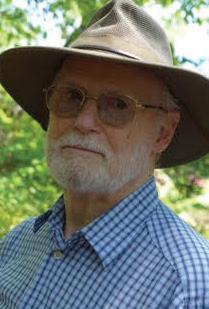
Kenney began teaching at Manhattan College as an assistant professor of English in 1966 and retired in 1998.
O’Donnell describes Kenney as a master teacher, saying his classes influenced students’ lives long after the classes were complete. English major — now English teacher — Erin (Doyle) Boyle ’88 credits Kenney as being especially influential on her classroom practices.
“My first class with Dr. Kenney was a class about comedy in film, and I absolutely loved it!” recalls Boyle, who teaches English at Walter Panas High School in Cortlandt Manor, New York. “I took American Literature courses with him, but that film class stood out to me.
Speaking about his impact on her teaching now, Boyle says, “Currently, I teach a Literature, Film & Modern Culture English 12 course, and some of my approach is based on [Kenney’s] ideas of balancing the enjoyment of the movies and the understanding of the technical aspects, as well as the history behind the film and how it connects us to our time.”
Kenney wrote a number of articles for the Encyclopedia of World Literature in the Twentieth Century, published in 1992, and several Haiku poetry books after he retired.
He earned his bachelor’s and master’s degrees from Boston College, and received his doctorate from the University of Michigan.
He is survived by his wife, Patricia.
MANHATTAN.EDU N 51
Robert Spinna
ROBERT J. SPINNA , associate professor emeritus of civil engineering who taught for more than four decades at the College and served as department chair, died on Jan. 25, 2022. He was 92.
He began teaching at the College in 1954 and continued until his retirement in 1995. His fields of greatest expertise were soil mechanics and foundation design, but he also taught a wide variety of courses on both the undergraduate and graduate levels during his tenure at Manhattan.
Spinna served as chair of the civil engineering department in the 1980s, but his emphasis remained on teaching and mentoring students throughout his years on campus. He worked with Walter Saukin, associate professor of civil and environmental engineering, on creating the College’s Fire Engineering Institute in the 1980s. Renowned fire safety expert Vincent Dunn even served as a consultant for the institute.
“I always tried to convince Bob not to retire. He was a great guy, and he brought so much to the department, especially in the soils area,” Saukin says. “He was always an advocate of women in engineering and tried to give advice and provide support for them. Bob really liked the students.”
A licensed professional engineer in both New York and New Jersey, Spinna was a sought-after consultant for decades. He often provided expert witness testimony, as his consulting practice focused on structural and foundation design and commercial building inspections. Spinna also held patents for his bulkhead designs.

During graduate school, Spinna worked as a “sandhog” (a person who works underground or underwater on construction projects) and operated a jackhammer on tunnel construction projects. He also taught at The Cooper Union in New York City and City College of New York. Spinna created the civil engineering department at Merrimack College in North Andover, Massachusetts, while teaching there.
A native of Brooklyn and longtime resident of both North Salem and Southampton, New York, Spinna dedicated much of his time to public service. He served for a brief time as town supervisor of North Salem and for many years as chair of the town’s Board of Assessment Review.
Spinna earned his bachelor’s degree in civil engineering from Villanova University and master’s in civil engineering from Columbia University.
Spinna is survived by his son, Robert Spinna Jr. ’96 (Emily); daughters, Rosemarie Kirchner (Albert), and Christine Keenan ’92 (Michael); and 11 grandchildren. He is predeceased by his wife, Rose.

J. Carl Bennett
J. CARL BENNETT, professor emeritus of physical education at Manhattan College for more than three decades, died on June 28, 2022. He was 79.
Widely known as Doc, he taught at Manhattan College from 1971 until his retirement in 2002. During his tenure, he served as chair of Health, Physical Education and Human Performance Sciences.
In 1979, he and fellow faculty member Bill Byron established the Manhattan College Games for children and adults with disabilities. The annual athletic event was hosted in Draddy Gymnasium and grew over several decades.
“Throughout his years teaching at Manhattan College, he touched the lives of many physical educators,” notes Lisa Toscano ’79, professor of kinesiology at Manhattan College. “You cannot think of Doc without a smile coming to your face. His classes were alive with energy and possibility. Every student has their own Doc story. His passion and his skill level were second to none. Doc mentored a countless number of teachers, coaches, physical therapists and administrators. He found a home at Manhattan College. We were very lucky he did.”
Bennett served a term as national president of Phi Epsilon Kappa Fraternity, a national, professional, honorary fraternity that was founded originally for individuals engaged in the field of physical education. He also served on a number of United States Olympic Committees, including the United States Olympic Education Committee, the United States Job Opportunities Committee, and the United States Wrestling Sports Service Committee.

Earning several honors and accolades during his career, Bennett was recognized with a Congressional Medal of Merit for Outstanding Leadership in 1986 and a Manhattan College Distinguished Lasallian Educator Award in 1991.
A devoted member of his community, he was active in the East Ramapo Mat Club for youth wrestling, which eventually grew into a summer program. When Bennett retired to Morehead City, North Carolina, in 2004, he spent another decade serving as a Gold Certified coach with USA Wrestling and a Bronze Certified coach with USA Weightlifting at both Swansboro and Broad Creek Middle Schools.
He earned his bachelor’s and master’s degrees from East Carolina University and a doctorate from the University of Utah. Bennett is survived by his wife, Faye; his son, Heath (Magaly); his sister, Donna (Thomas); and his sister-in-law, Connie.
52 N winter 202 3
OBITUARIES
Sister Kathleen Tracey, S.C.
SISTER KATHLEEN TRACEY, S.C., who served as the director of the cooperative program between Manhattan College and the College of Mount Saint Vincent (CMSV) for 20 years as part of her 64 years of service at CMSV, died on July 21, 2022. She was 96.
The cooperative program began in 1964 and was the longestrunning cooperative program between colleges in the country when it ended in 2006. Sister Kathleen directed the program for its final two decades.
Professor emerita of biology, Sister Kathleen began teaching at CMSV in 1953. During her tenure, she served as a biology professor, department chair, and associate vice president for advancement. On the cutting edge of her field, Sister Kathleen established the Institute for Aquatic Research at CMSV, which was one of the country’s first undergraduate programs in marine biology. Students benefited from handson study at a research station in Nassau, the Bahamas. She also introduced CMSV’s first bioethics course.
“Sister Kathleen Tracey, a Sister of Charity of New York, was an authentic person and teacher, a pioneer in environmental research and teaching,” says Sister Margaret Egan, S.C., councilor on the Sisters of Charity leadership team and professor emerita of education at CMSV. “She truly exemplified the College of Mount Saint Vincent motto, ‘Teach me Goodness, Discipline and Knowledge.’”
Leo Alves, professor emeritus of biology at Manhattan College, adds: “Over the years, Sister Kathleen’s temperament always carried the day. Her countenance, her Irish wit, her kindness, her optimism, her willingness to overlook faults and bring out the best in people, and her many other good qualities were a blessing to all she encountered. She was a marvelous person, a terrific educator, and an exemplar of the Sisters of Charity.”
In 2011, Sister Kathleen was named among 25 Bronx Influential Women by the Bronx Times-Reporter for her key role in the success of the college. In 1998, Sister Kathleen received the College of Mount Saint Vincent’s Alumna Award of Distinction, acknowledging her contributions to society. The College of Mount Saint Vincent
inaugurated the Kathleen Tracey, S.C., Medal for Service and Leadership in 2015.
Before joining the CMSV faculty, Sister Kathleen taught at Fordham University from 1953-1955 and at St. John the Evangelist High School in White Plains, New York, from 1955-1957. She also worked for two years at Mount Sinai Hospital, New York City, in bacteriology research before joining the Sisters of Charity of New York.
A native of New Jersey, Sister Kathleen entered the Sisters of Charity of New York in 1950 and professed her final vows in 1958. She was formerly known as Sister Kathleen Marie.
Sister Kathleen earned a bachelor’s degree in science from the College of Mount Saint Vincent. She earned both her master’s and doctoral degrees in biology from Fordham University and completed postdoctoral studies in radiation biology at the University of Chicago and the University of Tennessee, Oak Ridge.
She is survived by many nieces and nephews.
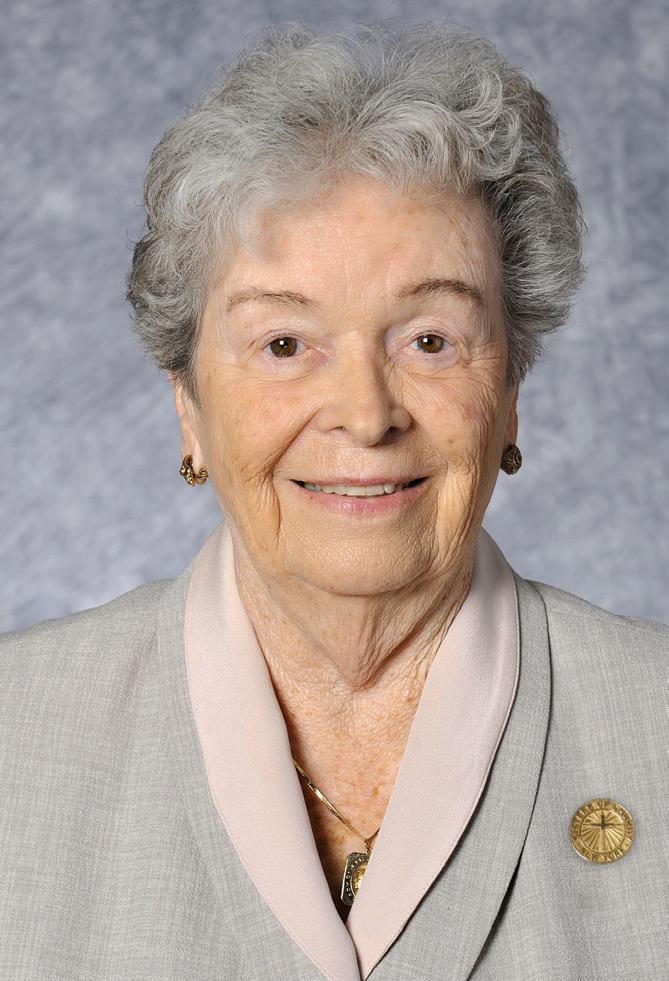
MANHATTAN.EDU N 53
“Sister Kathleen Tracey, a Sister of Charity of New York, was an authentic person and teacher, a pioneer in environmental research and teaching.”
—SISTER MARGARET EGAN, S.C.
Photo courtesy of the Sisters of Charity of New York
Rentaro Hashimoto
contagious love for philosophy has infected many students — who initially had no interest in the discipline — to become not only faithful adherents but to pursue philosophy at the graduate level.”

A number of faculty also considered Hashimoto a mentor.
“Hashi was a truly exceptional colleague and a pillar of the Manhattan College community, beloved by students, faculty and staff alike,” says Jordan Pascoe, associate professor of philosophy.
“He was also an amazing mentor. In my first years at Manhattan, I was lucky to share an office with Hashi, and to spend long afternoons with him talking about teaching, about students, about why philosophy mattered. Hashi taught me, and modeled for me, how to choose to teach what mattered, how to think outside the lines and simply do what was important — and how to trust my own judgment about what was important, both inside and out of the classroom. He was, in this sense, one of the most free people I have ever had the honor of meeting.”
Prior to teaching at Manhattan, Hashimoto was a typist/clerk for Samuel, Miller & Co. in Chicago, and an assistant production manager for Vanguard Recording Society Inc. He also taught part time at St. Francis College in Brooklyn, Fordham University and New York City Community College.
(known affectionately as Hashi), associate professor emeritus of philosophy, who taught at the College for almost 55 years and served as chair of the department, died on Oct.
Hashimoto began teaching philosophy at Manhattan in 1962. His courses focused on the existentialists, bringing Plato, Aristotle, Socrates, Nietzsche, Camus and Sartre to life. Throughout the decades, he added courses beyond the classic philosophers, including philosophers of non-Western and marginalized groups, such as Mao, Giap, Fanon, Frederick Douglass and Simone de Beauvoir.
Hashimoto both designed and taught courses in the core curriculum, as well as partnered with the Government department in teaching the Western Political Thought course. He also visited every section of the Global Origins Core course to share his own story of internment as a Japanese American child during World War II.
The longest-serving chair at the College, Hashimoto played an integral role in campus life, serving as a speaker of the Senate, a member of numerous committees, and a founding member and president of the Manhattan College chapter of Phi Beta Kappa. He also served as president and treasurer of the College’s chapter of the American Association of University Professors (AAUP).
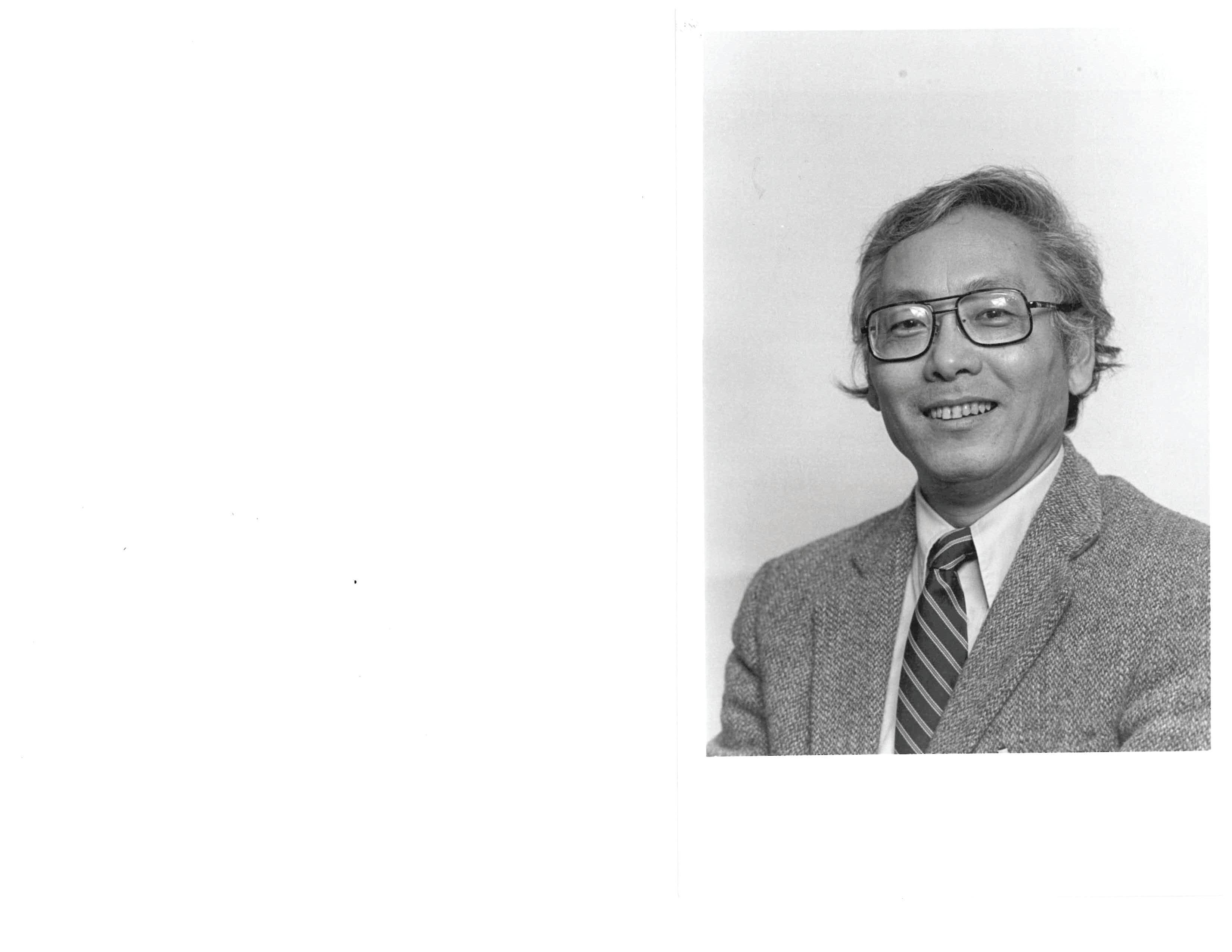
Hashimoto was honored with the Lasallian Educator Award for 2005-06. The citation celebrated his dedication to the College and its students, reading: “You have been teaching continuously (never taking a sabbatical or a leave) for over 40 years, bringing boundless enthusiasm, energy and dedication to all your endeavors. Your
A graduate of CUNY’s City College, Hashimoto earned his master’s degree from the University of Mexico with a Mexican government scholarship and the Downer Scholarship from the Spanish department of City College for study at the University of Mexico. He also had a fellowship with the University of Chicago as part of his master’s studies. Hashimoto earned his doctorate from Fordham University.
He is survived by his wife, Ayae; and daughter, Mari Hashimoto.
54 N winter 202 3 OBITUARIES
“Hashi was a truly exceptional colleague and a pillar of the Manhattan College community ...”
—JORDAN PASCOE
Felix Bocchino ’70
FELIX J. BOCCHINO ’70, associate professor of biology at the College of Mount Saint Vincent (CMSV) for 45 years, died on Aug. 13, 2021. He was 73.
Bocchino, who began teaching at CMSV in 1976, taught many Manhattan College students as part of the Cooperative Program.
Leo Alves, associate professor emeritus of biology at Manhattan College, and Bocchino were colleagues for nearly three decades in the Joined Biology department of CMSV and Manhattan. “Felix was a consummate educator,” Alves recalls. “In his classes, he taught many future physicians, nurses and other health-related professionals in courses such as Comparative Chordate Anatomy, Anatomy and Physiology, Pathophysiology, and Microbiology and Human Disease. He was beloved by his students and by his colleagues. His passing leaves a void that is not easily filled.”
Alves remembers Bocchino’s impressive and detailed blackboard sketches in multicolored chalks of various human organ systems, saying they were “anatomically precise, vivid, and works of art (worthy of framing, if that were possible).”
Bocchino served in the U.S. National Guard before beginning his teaching career at the College of Mount Saint Vincent. He was named Teacher of the Year every year he was eligible, and received the Dennis J. Enright Award for Excellence in Teaching seven times. He was known for working with students on their honors theses and oversaw the mentorship program for retention of first-year students in biology from 2001-04.

In addition, Bocchino was given a U.S. Department of Education grant and served as principal investigator. He contributed articles to various journals and held a number of professional affiliations, including
Anthony Sartor ’64
ANTHONY SARTOR ’64, P.E., a former member of the College’s Board of Trustees from 2000 to 2003 and a pioneer in the environmental engineering field, died on Aug. 5, 2022. He was 79.
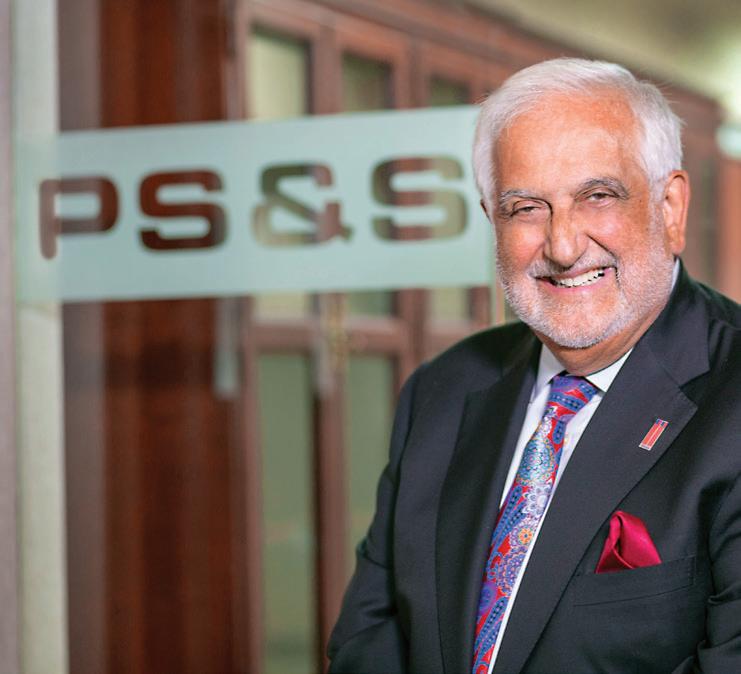
“Tony Sartor was a good friend,” says John Lawler ’55, former board chairman. “I knew him and worked with him long before either one of us served on the board. He certainly was a contributor and ... I know he was helpful especially with respect to opening doors to various public officials, both during and following his board service.”
In the 1970s, Sartor formed one of the first environmental engineering departments while working at Paulus and Sokolowski, an engineering firm based in New Jersey. He became a partner by 1974, and from 1974 to 2000, served as co-chairman of the board of Paulus, Sokolowski and Sartor (PS&S). During his tenure, the firm grew from 20 people to 300. In 2000, the company was acquired by National Grid (formerly KeySpan), a Fortune 500 company. Sartor was president of KeySpan Business Solutions LLC until 2003; senior vice president of National Grid; and president and chief operating officer of National Grid Energy Services (NGES), formerly KeySpan Services Inc., from 2003 to April 2009. He reacquired PS&S from National Grid in April 2009.
Beta Beta Beta, the national biological honor society; Sigma Xi, the scientific research honor society; and the Memorial SloanKettering Cancer Institute.
A native of Brooklyn, Bocchino earned his master’s and doctorate degrees from Fordham University after graduating from Manhattan College.
He is survived by his wife, Frances; his children, Christina Salo (Philip), and Michael Bocchino ’00 (Pascale); and four grandchildren.
Sartor also used his engineering expertise to support a number of projects in New Jersey. In 1992, he was appointed by then-Governor James Florio as a commissioner of the New Jersey Sports and Exposition Authority, serving until 1999. As chair of the Construction Committee, he was responsible for the construction of the Atlantic City Convention Center, the luxury suites at Giants Stadium, and athletic facilities at Rutgers University. Sartor held the position of commissioner of the Port Authority of New York and New Jersey from 1999 to 2013, serving under three different governors. Sartor was a member of the Operations Committee, the Committee on Governance and Ethics, and the World Trade Center Redevelopment Subcommittee, holding a leadership role in rebuilding the site.
He was a member of a number of boards, including the Italian American Foundation Board of Trustees and the New York Building Foundation Board of Governors. He is listed in Who’s Who in America, Who’s Who in American Science and Engineering, Who’s Who in Technology, American Men and Women of Science, and was a member of many other national and international organizations.
Sartor earned his bachelor’s degree in chemical engineering with honors from Manhattan College. He went on to earn master’s and doctoral degrees in engineering from the University of Michigan, funded by a National Science Foundation fellowship.
He is survived by his wife, Alice; three children, Lisanne, Colette and John; sons-in-law, Dakota Sunseri and Bob Ohanesian; daughterin-law, Kelly Sartor; and six grandchildren. He is predeceased by his first wife, Maria.
MANHATTAN.EDU N 55


56 N winter 202 3 PARTING SHOT
PHOTO BY CHRIS TAGGART
Program Director Angela Oliveira uses a medical training manikin to teach radiation therapy students proper patient setup techniques. The College offers VERT, a virtual environment of a radiotherapy treatment room. Through captivating 3D views and life-size visualizations, VERT offers an excellent platform for supplying radiation therapy training to students.
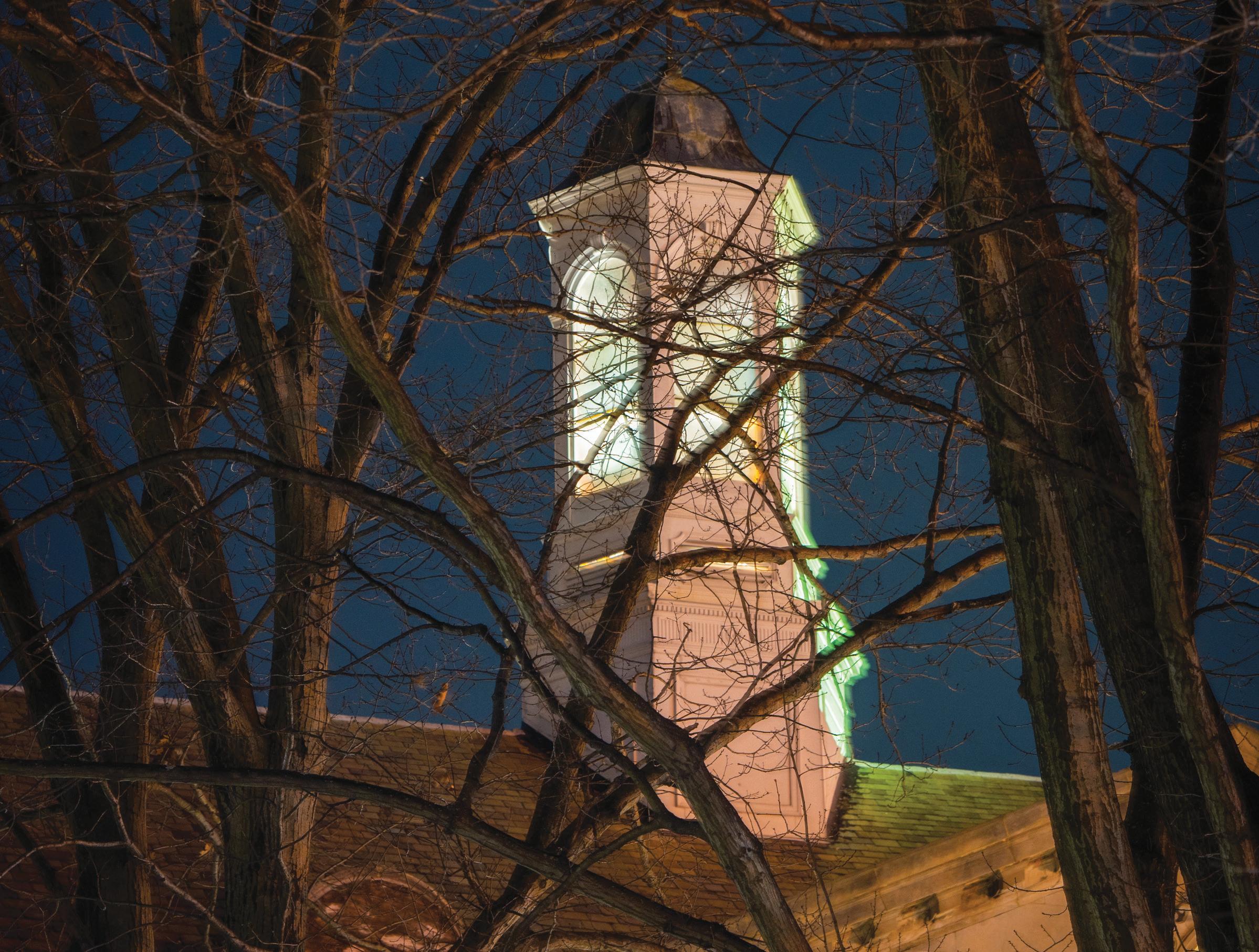
Published by the office of Marketing & Communication Manhattan College 4513 Manhattan College Parkway Riverdale, NY 10471 NON-PROFIT ORG. U.S. POSTAGE PAID BURL, VT 05401 PERMIT NO. 19 A LASALLIAN CATHOLIC COLLEGE SINCE 1853
Washed in a soft, white glow, the Memorial Hall cupola lights the way back to the Quadrangle on a clear and cold winter evening.
 MANHATTAN COLLEGE WINTER 2023
MANHATTAN COLLEGE WINTER 2023




































 BY CECILIA DONOHOE
BY CECILIA DONOHOE























































